Digi 9XTENDB XTend RF module User Manual product manual XTend OEM RF Module v2 x4x
Digi International Inc XTend RF module product manual XTend OEM RF Module v2 x4x
Digi >
Contents
- 1. User Manual
- 2. Updated User Manual
Updated User Manual
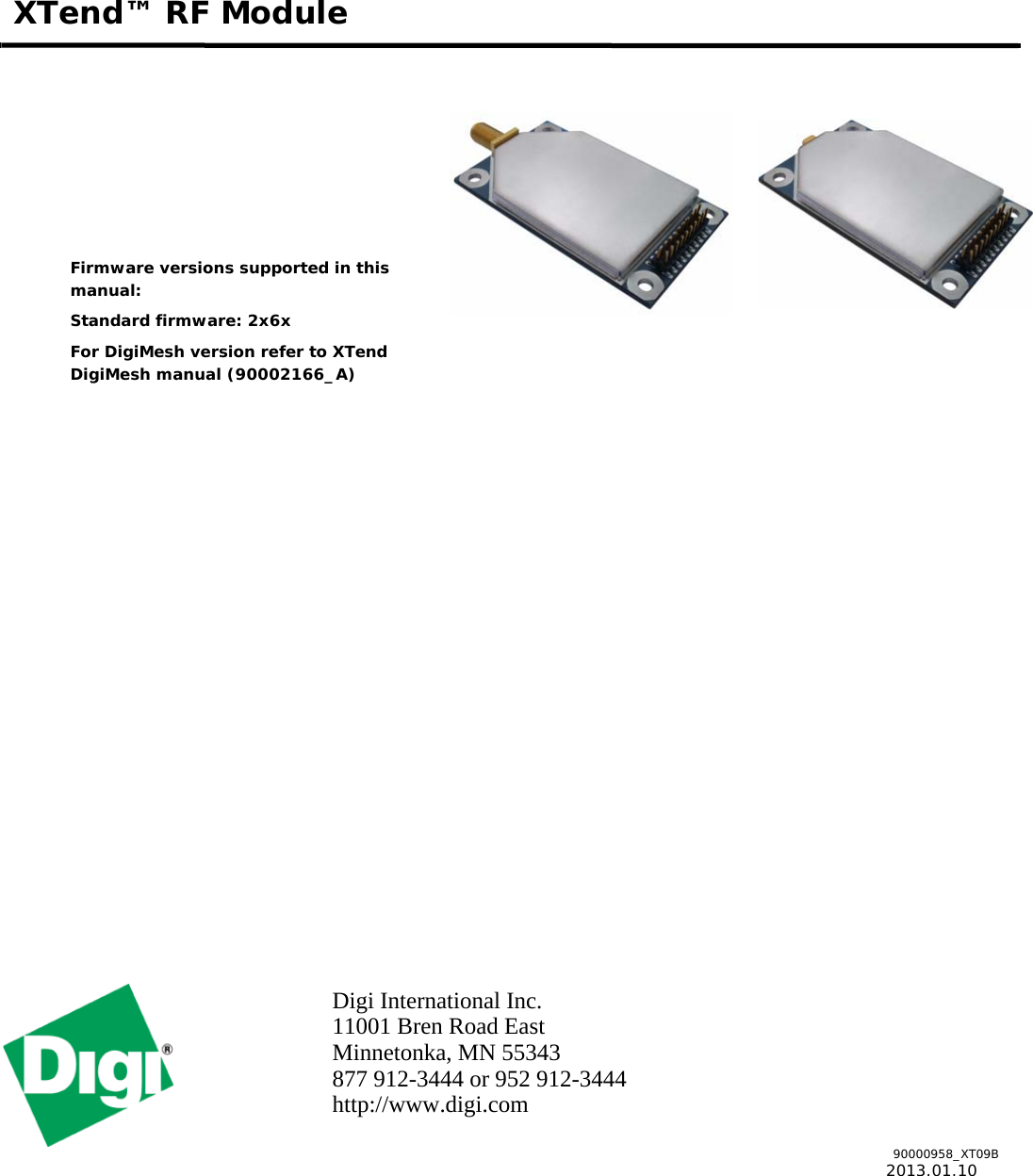
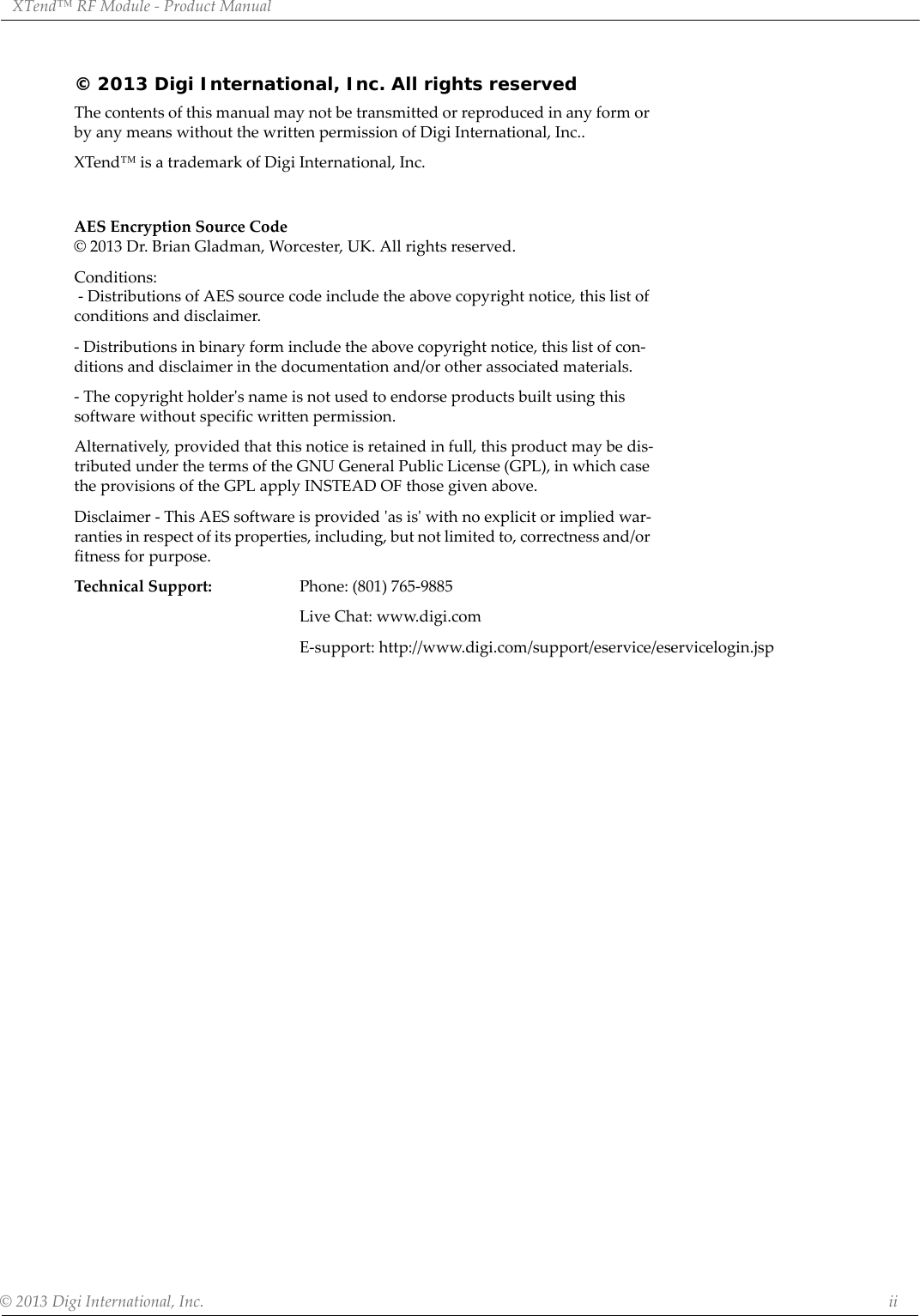
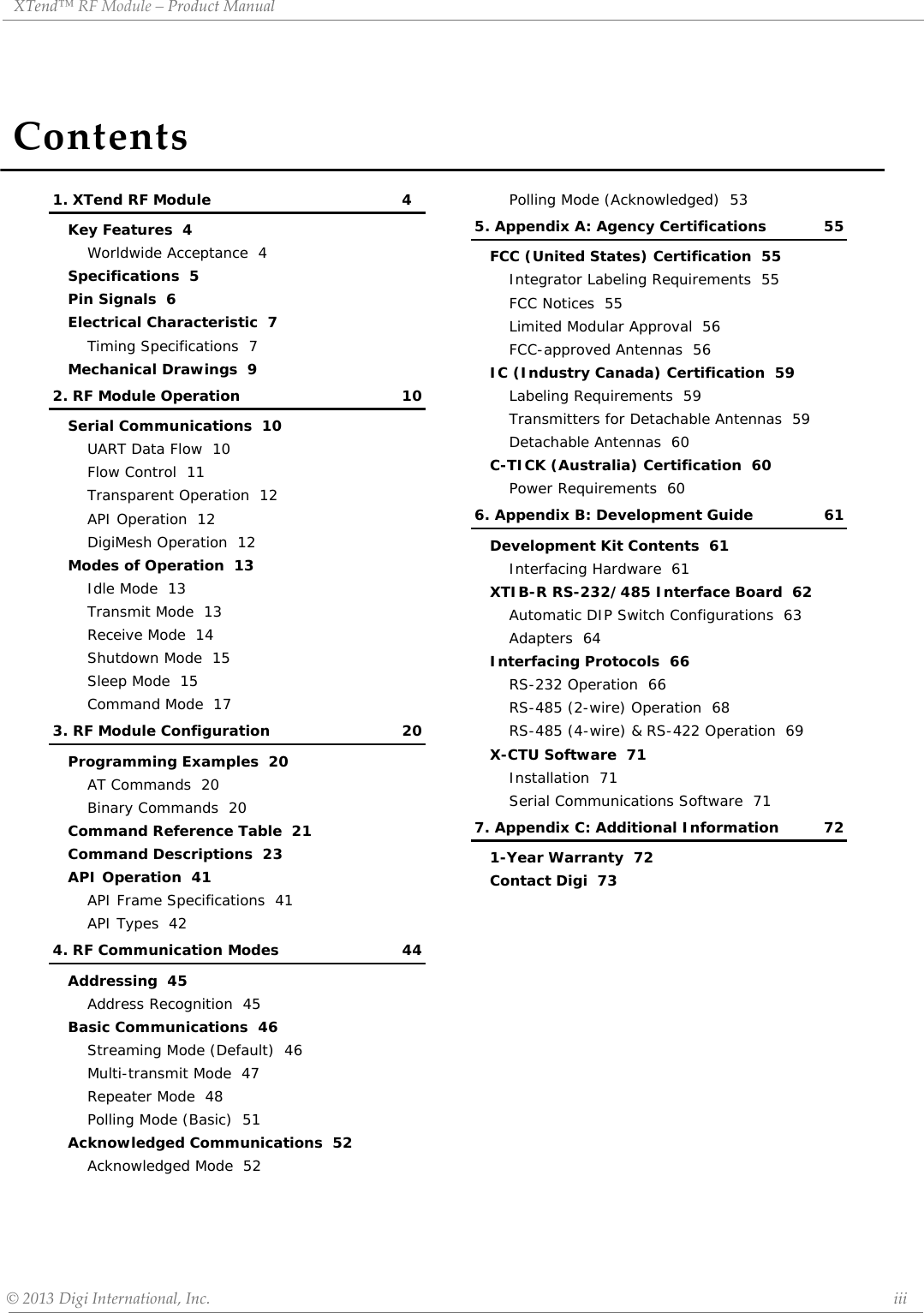
![©2013DigiInternationalInc. 41.XTendRFModuleThe XTend RF Module was engineered to provide customers with an easy-to-use RF solution that provides reliable delivery of critical data between remote devices. The module transfers a standard asynchronous serial data stream, operates within the ISM 900 MHz frequency band and sustains up to 115.2 Kbps data throughput.Key FeaturesWorldwide AcceptanceFCC Approved (USA) Refer to Appendix A [p55] for FCC Requirements.Systems that include XTend RF Modules inherit Digi’s Certifications.ISM (Industrial, Scientific & Medical) license-free 902-928 MHz frequency bandManufactured under ISO 9001:2000 registered standardsESD (Electrostatic Discharge) immunity - ESD-hardened and IEC1000-4-2 (Level 4) testedLong Range Data Integrity1 Watt Power Output (variable 1mW - 1W)Range (@9,600 bps throughput data rate):• Indoor/Urban: up to 3000’ (900 m)• Outdoor RF line-of-sight: up to 14 miles (22 km) w/dipole antenna• Outdoor RF line-of-sight:up to 40 miles (64 km) w/high-gain antennaRange (@115,200 bps throughput data rate):• Indoor/Urban: up to 1500’ (450 m)• Outdoor RF line-of-sight:up to 7 miles (11 km) w/dipole antenna• Outdoor RF line-of-sight:up to 20 miles (32 km) w/high-gain antennaContinuous RF data stream up to 115,200 bpsReceiver Sensitivity: -110 dBm (@ 9600 baud),–100 dBm (@ 115200 baud)Advanced Networking & SecurityTrue Peer-to-Peer (no Master device required),Point-to-Point, Point-to-Multipoint & MultidropRetries and AcknowledgementsFHSS (Frequency Hopping Spread Spectrum)10 hopping channels, each with over 65,000unique network addresses available256-bit AES Encryption - performed using a FIPS 197 certified implementation on a Phillips LPC microcontroller128-bit AES for international variantLow Power2.8 - 5.5 V Supply VoltagePin, Serial Port and Cyclicsoftware sleep modes supportedShutdown pin enables hardware sleep modethat draws only 5 µA (typical)Easy-to-UseNo configuration necessary for out-of boxRF communicationsFree X-CTU Software(Testing and configuration software)RF Modules easily configured usingstandard AT & binary commandsTransparent Operation (Wireless links replace serial wires)API Operation (Frame-based communications)Portable (small form-factor easily designed into a wide range of data systems)Software-selectable I/O interfacing ratesMultiple data formats supported(parity, start and stop bits, etc.)XII™ Interference ImmunityNo Master/Slave setup dependencies](https://usermanual.wiki/Digi/9XTENDB.Updated-User-Manual/User-Guide-1882461-Page-4.png)
![XTend™RFModule‐ProductManual©2013DigiInternatonal,Inc. 5XTend RF Modules are optimized for use in the US, Canada, and Australia (contact Digi for complete list of agency approvals).SpecificationsTable1‐01. XTendRFModuleXTend 900 MHz RF Module SpecificationsPerformance @9600 bps Throughput Data Rate @115200 bps Throughput Data RateTransmit Power Output (software selectable using PL command) 1mW - 1 Watt 1mW - 1 WattIndoor/Urban Range Up to 3000’ (900 m) Up to 1500’ (450 m)OutdoorRF line-of-sight RangeUp to 14 miles (22 km) w/ dipole antennaUp to 40 miles (64 km) w/ high-gain antennaUp to 7 miles (11 km) w/ dipole antennaUp to 20 miles (32 km) w/ high-gain antennaInterface Data Rate(software selectable using BD command) 1200 – 230400 bps 1200 – 230400 bpsThroughput Data Rate(software selectable using BR command) 9,600 bps 115,200 bpsRF Data Rate 10,000 bps 125,000 bpsReceiver Sensitivity -110 dBm -100 dBmPower RequirementsReceive Current 80 mAShutdown Mode Power Down 5 µA typicalPin Sleep Power Down 162 µAIdle Currents16 sec cyclic sleep (SM=8) 0.3 - 0.8 mA8 sec cyclic sleep (SM=7) 0.4 - 1.4 mA4 sec cyclic sleep (SM=6) 0.6 - 2.6 mA2 sec cyclic sleep (SM=5) 0.9 - 4.8 mA1 sec cyclic sleep (SM=4) 1.6 - 8.7 mANetworking & SecurityFrequency 902-928 MHz, 915-928 MHz International variantSpread Spectrum FHSS (Frequency Hopping Spread Spectrum)Modulation FSK (Frequency Shift Keying)Supported Network Topologies Peer-to-Peer (“Master/Slave” relationship not required), Point-to-Point, Point-to-Multipoint, MeshChannel Capacity 10 hop sequences share 50 frequenciesEncryption 256-bit or 128-bit AES Encryption – Refer to the KY Command [p29] to implementPhysical PropertiesRF Module Board Size 1.44” x 2.38” x 0.20” (3.65 cm x 6.05 cm x 0.51 cm)Weight 0.64 oz. (18 g)Connector 20-pinOperating Temperature -40 to 85º C (industrial)AntennaConnector Options RPSMA (Reverse-polarity SMA) or MMCXImpedance 50 ohms unbalancedCertifications (partial list) FCC Part 15.247 MCQ-9XTENDBIndustry Canada (IC) 1846A-9XTENDB](https://usermanual.wiki/Digi/9XTENDB.Updated-User-Manual/User-Guide-1882461-Page-5.png)
![XTend™RFModule‐ProductManual©2013DigiInternatonal,Inc. 6*Ifthesupplyvoltageforagivenpowersettingislowerthantheminimumsupplyvoltagerequirement(asshowninTable1‐02),theTXPowerOutputwilldecreasetothehighestpowerlevelsettinggiventhecurrentsupplyvoltage.**1WPowerOutputisnotsupportedwhenusinga3.3supplyvoltage.Pin SignalsFigure1‐01. XTendRFModulePinNumbersTable1‐02. XTendRFModuleSpecifications‐Relativetouser‐selectedTXPowerOutputPower Requirements (Supply voltage and TX currents relative to each TX Power Output option)Transmit Power Output 1 mW 10 mW 100 mW 500 mW * 1 W *Supply Voltage 2.8 - 5.5 VDC 3.0 - 5.5 VDC 4.75 - 5.5 VDCTransmit Current (5 V) typical 130 mA 160 mA 270 mA 500 mA 680 mATransmit Current (3.3 V) typical 125 mA 150 mA 260 mA 600 mA **Table1‐03. PinSignalDescriptions(Low‐assertedsignalsdistinguishedwithahorizontallineoversignalname.)Pin Number Mnemonic I/O High Impedance during Shutdown Must Connect Function1GND- - yesGround2VCCI - yesPower: 2.8 - 5.5 VDC (Power supply ripple: +/- 250mV max @ 5V, 1A or +/- 125mV max @ 3.3V, 600mA.)3GPO2 / RX LED Oyes -General Purpose Output 2: <Default (CD=2)> Pin is driven low. Refer to the CD Command [p25] for other configuration options.RX LED: Pin is driven high during RF data reception; otherwise, the pin is driven low. Refer to the CD Command [p25] to enable.4 TX_PWR O yes - Transmit_Power: Pin pulses low during RF transmission; otherwise, the pin is driven high to indicate power is on and the module is not in Sleep or Shutdown Mode.5DIIyes yesData In: Serial data entering the module (from the UART host). Refer to the Serial Communications [p10] section for more information.6DOOyes -Data Out: Serial Data exiting the module (to the UART host). Refer to the Serial Communications [p10] section for more information.7 SHDNIno yesShutdown: Pin is driven high during operation and low during Shutdown. Shutdown enables the lowest power mode (~5 µA) available to the module. Refer to the Shutdown Mode [p15] section for more information.8 GPI2 / SLEEP I yes -General Purpose Input 2: reserved for future useSLEEP: By default, SLEEP is not used. To configure this pin to enable Sleep Modes, refer to the Sleep Mode [p15], SM Command [p37] & PW Command [p33] sections.9GPO1 / CTS / RS-485 TX_EN Oyes -General Purpose Output 1: reserved for future useCTS (Clear-to-Send): <Default (CS=0)> When pin is driven low, the UART host is permitted to send serial data to the module. Refer to the Serial Communications [p10] & CS Command [p26] sections for more information.RS-485 Transmit Enable: To configure this pin to enable RS-485 half and full-duplex communications. Refer to the Serial Communications [p10] & CS Command [p26] sections.10 GPI1 / RTS / CMD Iyes -General Purpose Input 1: reserved for future useRTS (Request-to-Send): By default, is not used. To configure this pin to regulate the flow of serial data exiting the module, refer to the Serial Communications [p10] & RT Command [p36] sections.CMD (Command): By default, CMD is not used. To configure this pin to enable binary command programming, refer to the Binary Commands [p18] & RT Command [p36] sections.](https://usermanual.wiki/Digi/9XTENDB.Updated-User-Manual/User-Guide-1882461-Page-6.png)
![XTend™RFModule‐ProductManual©2013DigiInternatonal,Inc. 7*RFmodulehas10Kinternalpull‐upresistorNote: When integrating the module with a Host PC board, all lines not used should be left disconnected (floating).Electrical CharacteristicFigure1‐02. SystemBlockDiagramBasicRFLinkbetweenHostsThe data flow sequence is initiated when the first byte of data is received in the DI Buffer of the transmitting module (XTend RF Module A). As long as XTend RF Module A is not already receiving RF data, data in the DI Buffer is packetized then transmitted over-the-air to XTend RF Module B.Timing SpecificationsFigure1‐03. TimingSpecifications(‘A’and‘B’refertoFigure1‐02)11 CONFIG / RSSII* no - Configuration: Pin can be used as a backup method for entering Command Mode during power-up. Refer to the Command Mode [p17] section for more information. O* no - Receive Signal Strength Indicator: By default, pin is used as an RSSI PWM output after at the conclusion of the power-up sequence. Refer to the RP Command [p35] for more information. The PWM output is 2.8V-level.12-20 reserved / do not connectTable1‐03. PinSignalDescriptions(Low‐assertedsignalsdistinguishedwithahorizontallineoversignalname.)Pin Number Mnemonic I/O High Impedance during Shutdown Must Connect Function](https://usermanual.wiki/Digi/9XTENDB.Updated-User-Manual/User-Guide-1882461-Page-7.png)
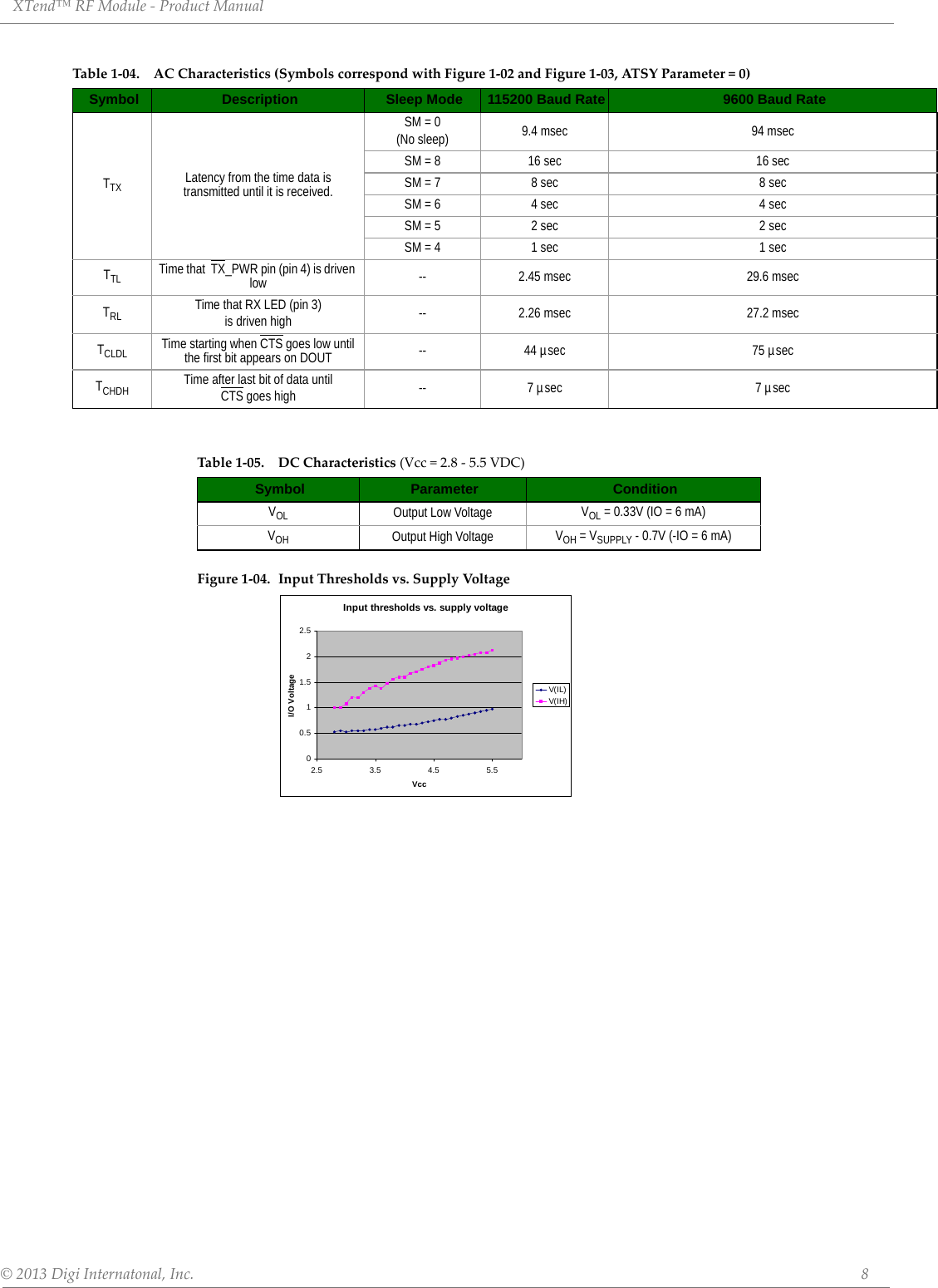
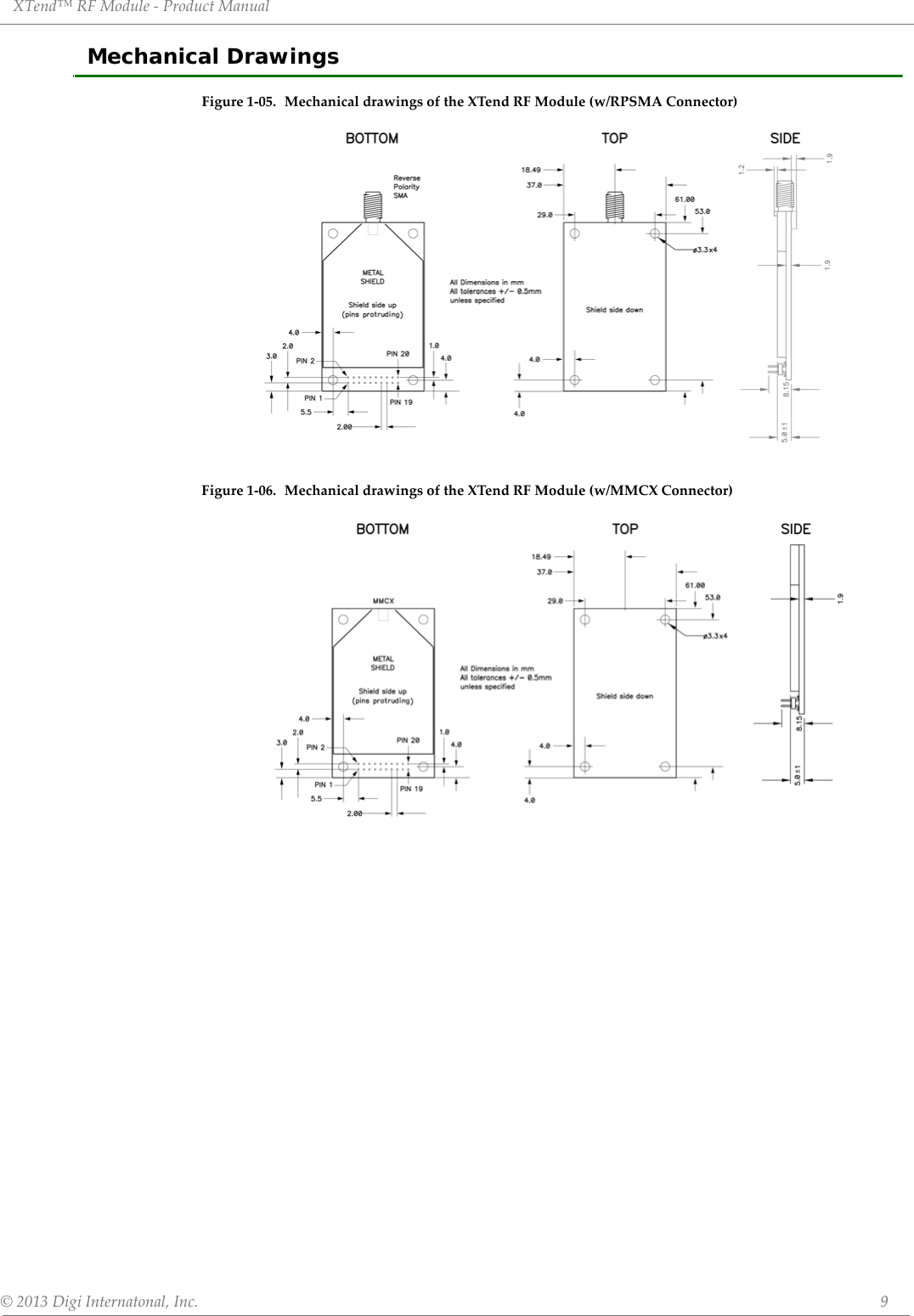
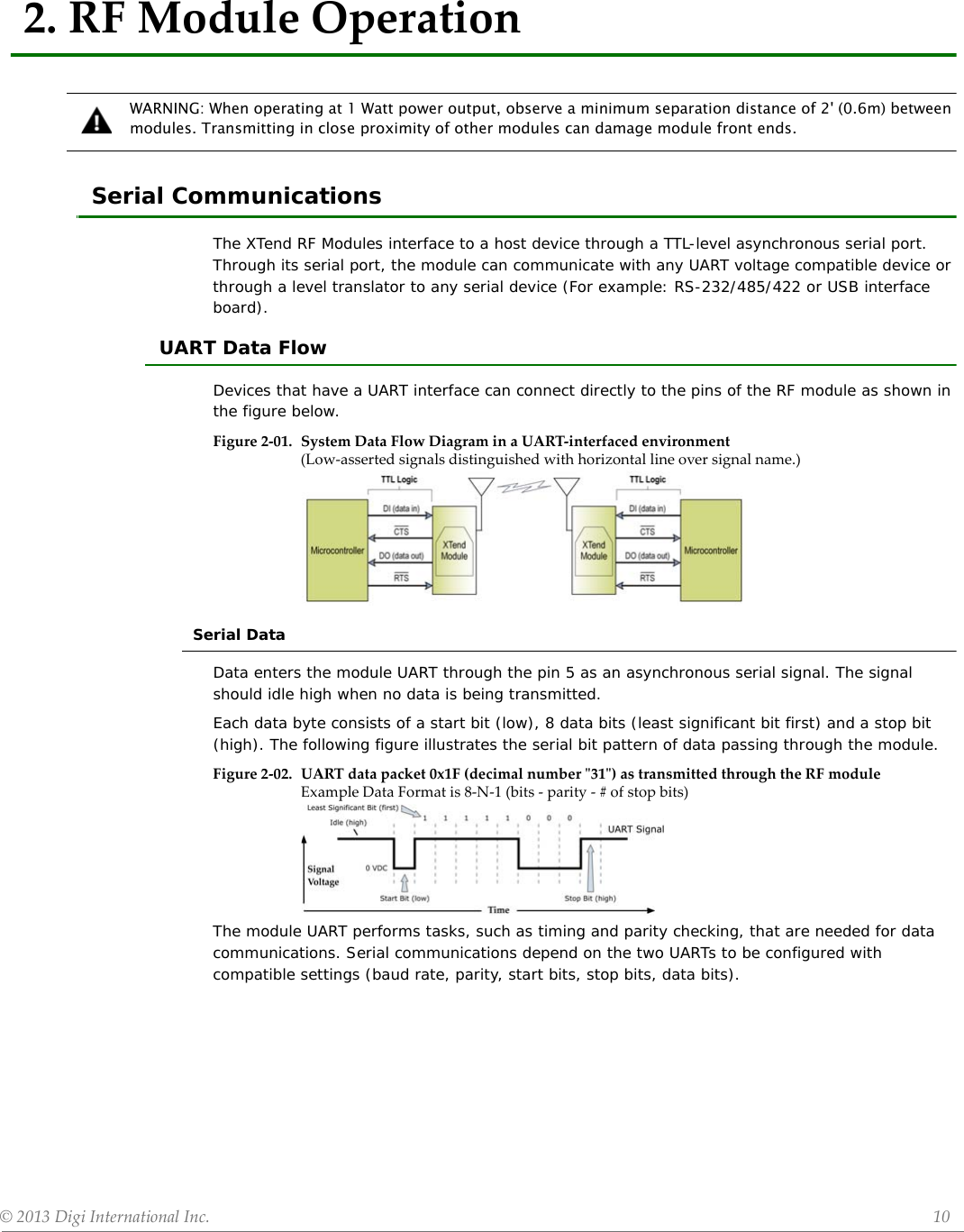
![XTend™RFModule‐ProductManual©2013DigiInternatonal,Inc. 11Flow ControlFigure2‐03. InternalDataFlowDiagram(Thefivemostcommonly‐usedpinsignalsshown)DI (Data In) Buffer and Flow ControlWhen serial data enters the module through the DI pin (pin 5), the data is stored in the DI Buffer until it can be processed.When the RB and RO parameter thresholds are satisfied (refer to ‘Transmit Mode’ section for more information), the module attempts to initialize an RF connection. If the module is already receiving RF data, the serial data is stored in the module's DI Buffer. The DI buffer stores at least 2.1 KB. If the DI buffer becomes full, hardware or software flow control must be implemented in order to prevent overflow (loss of data between the host and RF module).How to eliminate the need for flow control:Two cases in which the DI Buffer may become full and possibly overflow:Hardware Flow Control (CTS). When the DI buffer is 17 bytes away from being full; by default, the module de-asserts CTS (high) to signal to the host device to stop sending data [refer to FT (Flow Control Threshold) and CS (GPO1 Configuration) Commands]. CTS is re-asserted after the DI Buffer has 34 bytes of memory available.Software Flow Control (XON). XON/XOFF software flow control can be enabled using the FL (Software Flow Control) Command. This option only works with ASCII data.DO (Data Out) BufferWhen RF data is received, the data enters the DO buffer and is sent out the serial port to a host device. Once the DO Buffer reaches capacity, any additional incoming RF data is lost. The DO buffer stores at least 2.1 KB.Two cases in which the DO Buffer may become full and possibly overflow:Hardware Flow Control (RTS). If RTS is enabled for flow control (RT Parameter = 2), data will not be sent out the DO Buffer as long as RTS (pin 10) is de-asserted. Software Flow Control (XOFF). XON/XOFF software flow control can be enabled using the FL (Software Flow Control) Command. This option only works with ASCII data.1. Send messages that are smaller than the DI buffer size. The size of the DI buffer varies according to the packet size (PK parameter) and the parity setting (NB parameter) used.2. Interface at a lower baud rate (BD parameter) than the RF data rate (BR parameter).1. If the serial interface data rate is set higher than the RF data rate of the module, the mod-ule will receive data from the host faster than it can transmit the data over-the-air.2. If the module is receiving a continuous stream of RF data or if the module is monitoring data on a network, any serial data that arrives on the DI pin (pin 5) is placed in the DI Buf-fer. The data in the DI buffer will be transmitted over-the-air when the module no longer detects RF data in the network.1. If the RF data rate is set higher than the interface data rate of the module, the module will receive data from the transmitting module faster than it can send the data to the host.2. If the host does not allow the module to transmit data out from the DO buffer because of being held off by hardware or software flow control.](https://usermanual.wiki/Digi/9XTENDB.Updated-User-Manual/User-Guide-1882461-Page-11.png)
![XTend™RFModule‐ProductManual©2013DigiInternatonal,Inc. 12Transparent OperationBy default, XTend RF Modules operate in Transparent Mode. The modules act as a serial line replacement - all UART data received through the DI pin is queued up for RF transmission. When RF data is received, the data is sent out the DO pin.When the RO (Packetization Timeout) parameter threshold is satisfied, the module attempts to initialize an RF transmission. If the module cannot immediately transmit (for instance, if it is already receiving RF data), the serial data continues to be stored in the DI Buffer. Data is packetized and sent at any RO timeout or when the maximum packet size is received.The module operates as described above unless the Command Mode Sequence is detected. The Command Mode Sequence consists of three copies of the command sequence character [CC parameter] surrounded by the before and after guard times [BT & AT parameters].If the DI buffer becomes full, hardware or software flow control must be implemented in order to prevent overflow (loss of data between the host and module).API OperationAPI (Application Programming Interface) Operation is an alternative to the default Transparent Operation. The API is frame-based and extends the level to which a host application can interact with the networking capabilities of the module. When in API mode, all data entering and leaving the RF module is contained in frames that define operations or events within the module.Transmit Data Frames (received through the DI (Data In) pin) include:• 16-bit addressReceive Data Frames (sent out the DO (Data Out) pin) include:• Showing a received RF packet (16 bits only)• Response to a TX (Transmit) packet• Showing events such as hardware reset, watchdog reset, asynchronous events, etc.The module will send data frames to the application containing status packets; as well as source, RSSI and payload information from received data packets.API operation option facilitates many operations such as the examples cited below:To implement API operations, refer to ‘API Operation’ sections [p41].DigiMesh OperationXTend RF Modules containing firmware version 8020 (or above) now feature DigiMesh mesh networking support. Mesh networking allows messages to be routed through several different XTend nodes to a final destination node. This firmware load allows system integrators to bolster their networks with the self-healing attributes of mesh networking. In the event that one RF connection between nodes is lost (due to power-loss, environmental obstructions, etc.) critical data can still reach its destination due to mesh networking capabilities embedded inside the module. Transparent or API operations can be used in conjunction with the mesh networking topology. A separate product manual exists for DigiMesh modules. This product manual can be found on the Digi support site.-> Change destination addresses without having to enter command mode-> Receive success/failure status of each RF packet-> Identify the source address of each received packet](https://usermanual.wiki/Digi/9XTENDB.Updated-User-Manual/User-Guide-1882461-Page-12.png)
![XTend™RFModule‐ProductManual©2013DigiInternatonal,Inc. 13Modes of OperationXTend RF Modules operate in six modes.Figure2‐04. XTendRFModuleModesofOperation(RFmodulescanonlybeinonemodeatatime)Idle ModeWhen not receiving or transmitting data, the RF module is in Idle Mode. The module shifts into the other modes of operation under the following conditions:• Transmit Mode: Serial data is received in the DI Buffer• Receive Mode: Valid RF data is received through the antenna• Shutdown Mode: Shutdown condition is met• Sleep Mode: Sleep Mode condition is met• Command Mode: Command Mode Sequence is issuedThe module automatically transitions back to Idle Mode after responding to these conditions.Transmit ModeWhen the first byte of serial data is received from the UART in the DI buffer, the module attempts to shift to Transmit Mode and initiate an RF connection with other modules. After transmission is complete, the module returns to Idle Mode.RF transmission begins after either of the following criteria is met:Figure2‐05. TransmitModeDataFlowThe character timeout trigger can be disabled by setting RO to zero. In this case, transmission will not begin until RB bytes have been received and are pending for RF transmission. The RB parameter may be set to any value between 1 and the RF packet size [refer to PK (Max RF Packet Size) parameter], inclusive. Note that transition to Transmit Mode cannot take place during RF reception; the RF reception must complete before the radio can transition into Transmit Mode.If RB or RO conditions are met, the module initializes a communications channel. Serial data in the DI buffer is grouped into RF packets (up to 2048 bytes in each packet, refer to PK Command), converted to RF data and is transmitted over-the-air until the DI buffer is empty.1. RB bytes have been received by the UART and are pending for RF transmission.[Refer to the RB (Packetization Threshold) Command]2. At least one character has been received by the UART and is pending for RF transmission; and RO character times of silence been observed on the UART.[Refer to the RO (Packetization Timeout) Command]](https://usermanual.wiki/Digi/9XTENDB.Updated-User-Manual/User-Guide-1882461-Page-13.png)
![XTend™RFModule‐ProductManual©2013DigiInternatonal,Inc. 14Channel initialization is the process of sending an RF initializer that synchronizes receiving modules with the transmitting module. During channel initialization, incoming serial data accumulates in the DI buffer.RF data, which includes the payload data, follows the RF initializer. The payload includes up to the maximum packet size (PK Command) bytes. As the TX module nears the end of the transmission, it inspects the DI buffer to see if more data exists to be transmitted. This could be the case if more than PK bytes were originally pending in the DI buffer or if more bytes arrived from the UART after the transmission began. If more data is pending, the transmitting module assembles a subsequent packet for transmission.Refer to the ‘RF Communication Modes’ section to view state diagrams that illustrate channel initialization and the sequence of events that follow.RF PacketFigure2‐06. RFPacketComponents* When streaming multiple RF packets, the RF Initializer is only sent in front of the first packet.RF InitializerAn RF initializer is sent each time a new connection sequence begins. The RF initializer contains channel information that notifies receiving modules of information such as the hopping pattern used by the transmitting module. The first transmission always sends an RF initializer.An RF initializer can be of various lengths depending on the amount of time determined to be required to prepare a receiving module. For example, a wake-up initializer is a type of RF initializer used to wake remote modules from Sleep Mode (Refer to the FH, LH, HT and SM Commands for more information). The length of the wake-up initializer should be longer than the length of time remote modules are in cyclic sleep.HeaderThe header contains network addressing information that filters incoming RF data. The receiving module checks for matching a Hopping Channel, VID and Destination Address. Data that does not pass through all three network filter layers is discarded. Refer to the ‘Addressing’ section of the “RF Communication Modes” chapter for more information.CRC (Cyclic Redundancy Check)To verify data integrity and provide built-in error checking, a 16-bit CRC (Cyclic Redundancy Check) is computed for the transmitted data and attached to the end of each RF packet. On the receiving end, the receiving module computes the CRC on all incoming RF data. Received data that has an invalid CRC is discarded [refer to the ‘Receive Mode’ section].Receive ModeIf a module detects RF data while operating in Idle Mode, the module transitions to Receive Mode to start receiving RF packets. Once a packet is received, the module checks the CRC (cyclic redundancy check) to ensure that the data was transmitted without error. If the CRC data bits on the incoming packet are invalid, the packet is discarded. If the CRC is valid, the packet proceeds to the DO Buffer.](https://usermanual.wiki/Digi/9XTENDB.Updated-User-Manual/User-Guide-1882461-Page-14.png)
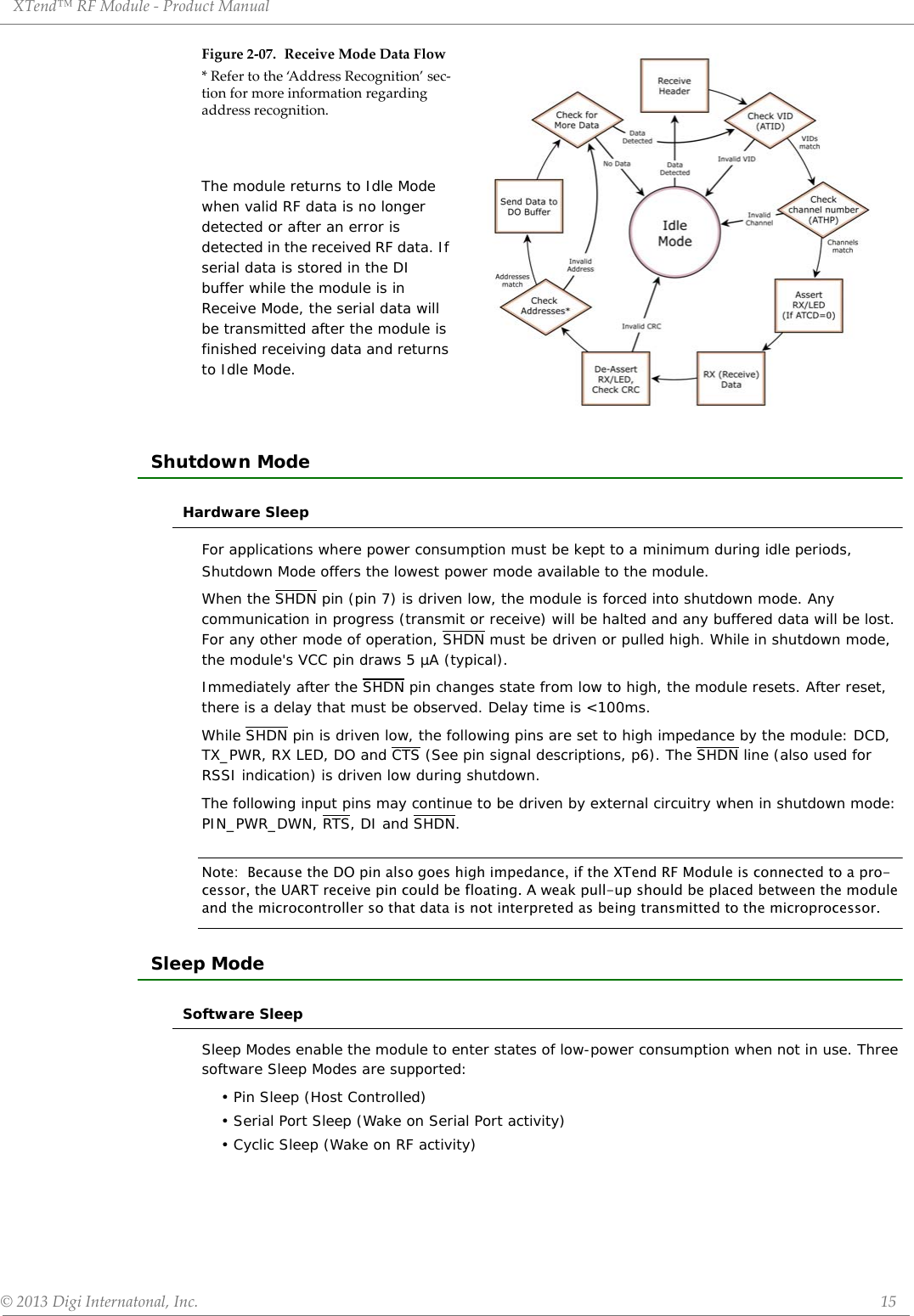
![XTend™RFModule‐ProductManual©2013DigiInternatonal,Inc. 16In order to enter Sleep Mode, one of the following conditions must be met (in addition to the module having a non-zero SM parameter value):When in Sleep Mode, the module will not transmit or receive data until the module first transitions to Idle Mode. All Sleep Modes are enabled and disabled using SM Command. Transitions into and out of Sleep Modes are triggered by various mechanisms as shown in the table below.The SM (Sleep Mode) command is central to setting all Sleep Mode configurations. By default, Sleep Modes are disabled (SM = 0) and the module remains in Idle/Receive Mode. When in this state, the module remains constantly ready to respond to serial or RF activity.Refer to the ‘Hardware Sleep’ section of the ‘Shutdown Mode’ section [previous page] to enable the module's lowest power-consuming state (5 µA typical power-down current).Pin Sleep (SM = 1)• Pin/Host-controlled• Typical power-down current: < 162 A This mode is voltage level activated. When the SLEEP pin is asserted, the module will finish any transmitting or receiving activity; enter Idle Mode; then enter a state of sleep. When in Pin Sleep Mode, the module will not respond to serial or RF activity. After enabling Pin Sleep, the SLEEP pin controls whether the module is active or sleeping. When SLEEP is de-asserted, the module is fully operational. When SLEEP is asserted, the module transitions to Sleep Mode and remains in its lowest power-consuming state until the pin is de-asserted. This pin is only active if the module is setup to operate in this mode; otherwise the pin is ignored.Once in Pin Sleep, CTS (GPO1) is de-asserted (high), indicating that data should not be sent to the module. The PWR pin is also de-asserted (low) when the module is in Pin Sleep Mode.Note: The module will complete a transmission or reception before activating Pin Sleep.Serial Port Sleep (SM = 2)• Wake on serial port activity• Typical power-down current: < 10 mASerial Port Sleep is a Sleep Mode in which the module runs in a low power state until serial data is detected on the DI pin.1. The module is idle (no data transmission or reception) for the amount of time defined by the ST (Time before Sleep) parameter. [NOTE: ST is only active when SM = 4-5.]2. SLEEP (pin 8) is asserted (only for the ‘Pin Sleep’ option).Table2‐01. SummaryofSleepModeConfigurationsSleep Mode (Setting) Transition into Sleep Mode Transition out of Sleep Mode (wake) RelatedCommands PowerConsumptionPin Sleep(SM = 1)Assert (high) SLEEP pin - A micro controller can shut down and wake modules via the SLEEP pin.Note: The module will complete a transmission or reception before activating Pin Sleep.De-assert (low) SLEEP pin (SM) < 162ASerial Port Sleep(SM = 2)Automatic transition to Sleep Mode occurs after a user-defined period of inactivity (no transmitting or receiving of data). Period of inactivity is defined by the ST (Time before Sleep) Command.When a serial byte is received on the DI pin (SM), ST < 10 mACyclic Sleep(SM = 4 - 8)RF module transitions in and out of Sleep Mode in cycles (user-selectable wake-up interval of time is set using the SM command). The cyclic sleep interval of time must be shorter than the interval of time that is defined by the LH (Wake-up Initializer TImer) command.Note: The module can be forced into Idle Mode using the SLEEP pin if the PW (Pin Wake-up) command is issued.(SM), ST, HT, LH, PW< 1.6 mA when sleeping(SM=4, 1 sec., @120K baud)](https://usermanual.wiki/Digi/9XTENDB.Updated-User-Manual/User-Guide-1882461-Page-16.png)
![XTend™RFModule‐ProductManual©2013DigiInternatonal,Inc. 17The period of time the module sleeps is determined by ST (Time before Sleep) Command. Once a character is received through the DI pin, the module returns to Idle Mode and is fully operational.Cyclic Sleep (SM = 4-8)• Typical Power-down Current: < 1.6 mA (when asleep)Cyclic Sleep Modes allow modules to periodically wake and check for RF data. The module wakes according to the times designated by the Cyclic sleep settings. If the module detects a wake-up initializer during the time it is awake, the module synchronizes with the transmitting module and receives data after the wake-up initializer runs its duration. Otherwise, the module returns to Sleep Mode and continues to cycle in and out of activity until a wake-up initializer is detected. While the module is in Cyclic Sleep Mode, CTS (GPO1) is de-asserted (high) to indicate that data should not be sent to the module. When the module awakens to listen for data, GPO1 is asserted and any data received on the DI Pin is transmitted. The PWR pin is also de-asserted (low) when the module is in Cyclic Sleep Mode.The module remains in Sleep Mode for a user-defined period of time ranging from 0.5 seconds to 16 seconds (SM parameters 4 through 8). After this interval of time, the module returns to Idle Mode and listens for a valid data packet. The listen time will depend on the [BR] (RF Data Rate) parameter setting.The default [BR] setting of 1 will require at least a 35ms wake time, while the [BR] setting of 0 will require a wake time of up to 225ms. If the module does not detect valid data (on any frequency), the module returns to Sleep Mode. If valid data is detected, the module transitions into Receive Mode and receives the incoming RF packets. The module then returns to Sleep Mode after a period of inactivity determined by the ST "Time before Sleep" parameter.The module can also be configured to wake from cyclic sleep when the SLEEP pin is de-asserted. To configure a module to operate in this manner, PW (Pin Wake-up) Command must be issued. Once the SLEEP pin is de-asserted, the module is forced into Idle Mode and can begin transmitting or receiving data. It remains active until data is no longer detected for the period of time specified by the ST Command, at which point it resumes its low-power cyclic state.Cyclic Scanning. Each RF transmission consists of an RF Initializer and payload. The RF initializer contains initialization information and all receiving modules must wake during the wake-up initializer portion of data transmission in order to be synchronized with the transmitting module and receive the data. The cyclic interval time defined by the SM (Sleep Mode) command must be shorter than the interval time defined by LH (Wake-up Initializer Timer) command.Figure2‐08. CorrectConfiguration(LH>SM):Thelengthofthewake‐upinitializerexceedsthetimeintervalofCyclicSleep.Thereceiverisguaranteedtodetectthewake‐upinitializerandreceivetheaccompanyingpayloaddata.Command ModeTo modify or read module parameters, the module must first enter into Command Mode (state in which incoming characters are interpreted as commands). Two command types are supported:• AT Commands• Binary CommandsFor modified parameter values to persist in the module registry, changes must be saved to non-volatile memory using the WR (Write) command. Otherwise, parameters are restored to previously saved values when the module is powered off and then on again.](https://usermanual.wiki/Digi/9XTENDB.Updated-User-Manual/User-Guide-1882461-Page-17.png)
![XTend™RFModule‐ProductManual©2013DigiInternatonal,Inc. 18AT Command ModeTo Enter AT Command Mode:Default AT Command Mode Sequence (for transition to Command Mode):• No characters sent for one second [refer to the BT (Guard Time Before) Command]• Input three plus characters (“+++”) within one second[refer to the CC (Command Sequence Character) Command.]• No characters sent for one second [refer to the AT (Guard Time After) Command.]All of the parameter values in the sequence can be modified to reflect user preferences.To Send AT Commands:Figure2‐09.SyntaxforsendingATCommandsTo read a parameter value stored in the module register, leave the parameter field blank.The preceding example would change the module’s Destination Address to "0x1F". To store the new value to non-volatile (long term) memory, the Write (ATWR) command must subsequently be sent before powering off the module.System Response. When a command is sent to the module, the module will parse and execute the command. Upon successful execution of a command, the module returns an “OK” message. If execution of a command results in an error, the module returns an “ERROR” message.To Exit AT Command Mode:For an example of programming the RF module using AT Commands and descriptions of each config-urable parameter, refer to the "RF Module Configuration" chapter [p20].Binary Command ModeSending and receiving parameter values using binary commands is the fastest way to change operating parameters of the module. Binary commands are used most often to sample signal strength [refer to DB (Received Signal Strength) parameter] and/or error counts; or to change module addresses and channels for polling systems when a quick response is necessary. Since the sending and receiving of parameter values takes place through the same serial data path as 'live' data (received RF payload), interference between the two types of data can be a concern.Common questions about using binary commands: • What are the implications of asserting CMD while live data is being sent or received? 1. Send the 3-character command sequence "+++" and observe guard times before and after the command characters. [refer to ‘Default AT Command Mode Sequence’ below.] The ‘Ter-minal’ tab (or other serial communications software) of the X-CTU Software can be used to enter the sequence.[OR]2. Assert (low) the CONFIG pin and turn the power going to the module off and back on (or pulse the SHDN pin). [If the module is mounted to a Digi RS-232/485 Interface Board, the result can be achieved by pressing the configuration switch down for 2 seconds.]Send AT commands and parameters using the syntax shown below.1. If no valid AT Commands are received within the time specified by CT (Command Mode Timeout) Command, the module automatically returns to Idle Mode. [OR]2. Send ATCN (Exit Command Mode) Command.](https://usermanual.wiki/Digi/9XTENDB.Updated-User-Manual/User-Guide-1882461-Page-18.png)
![XTend™RFModule‐ProductManual©2013DigiInternatonal,Inc. 19• After sending serial data, is there a minimum time delay before CMD can be asserted? • Is a time delay required after CMD is de-asserted before payload data can be sent? • How does one discern between live data and data received in response to a command? The CMD pin (pin 10) must be asserted in order to send binary commands to the module. The CMD pin can be asserted to recognize binary commands anytime during the transmission or reception of data. The status of the CMD signal is only checked at the end of the stop bit as the byte is shifted into the serial port. The application does not allow control over when data is received, except by waiting for dead time between bursts of communication. If the command is sent in the middle of a stream of payload data to be transmitted, the command will essentially be executed in the order it is received. If the module is continuously receiving data, the radio will wait for a break in the received data before executing the command. The CTS signal will frame the response coming from the binary command request [refer to figure below].A minimum time delay of 100 µs (after the stop bit of the command byte has been sent) must be observed before the CMD pin can be de-asserted. The command executes after all parameters associated with the command have been sent. If all parameters are not received within 0.5 seconds, the module returns to Idle Mode. Note: When parameters are sent, they are two bytes long with the least significant byte sent first. Binary commands that return one parameter byte must be written with two parameter bytes.Commands can be queried for their current value by sending the command logically ORed (bit-wise) with the value 0x80 (hexadecimal) with CMD asserted. When the binary value is sent (with no parameters), the current value of the command parameter is sent back through the DO pin.Figure2‐010.BinaryCommandWritethenReadSignal#4isCMDSignal#1istheDIsignalSignal#2istheDOsignalfromtheradioSignal#3isCTSIn this graph, a value was written to a register and then read out to verify it. While not in the middle of other received data, note that the CTS signal outlines the data response out of the module.IMPORTANT: In order for the module to recognize a binary command, the RT (GPI1 Configuration) parameter must be set to one. If binary programming is not enabled (RT parameter value is not equal to ‘1’), the module will not recognize that the CMD pin is asserted and therefore will not recognize the data as binary commands.Refer to [p20] for a binary programming example (DT command example returns two bytes).](https://usermanual.wiki/Digi/9XTENDB.Updated-User-Manual/User-Guide-1882461-Page-19.png)
![©2013DigiInternationalInc. 203.RFModuleConfigurationProgramming ExamplesRefer to the ‘Command Mode’ section [p17] for information regarding entrance into Command Mode, sending AT commands and exiting Command Mode. Refer to the ‘X-CTU’ section [p71] of the ‘Development Guide’ for more information regarding Digi’s configuration software.AT CommandsTo Send AT Commands (Using the ‘Terminal’ tab of the X-CTU Software)Note: When using X-CTU Software to program a module, PC com port settings must match the baud (interface data rate), parity & stop bits parameter settings of the module. Use the 'Com Port Setup' section of the “PC Settings” tab to configure PC com port settings to match those of the module.Binary CommandsTo Send Binary Commands:Note: CTS (pin 9) is high when a command is being executed. Hardware flow control must be disabled as CTS will hold off parameter bytes.Example: Utilize the 'Terminal' tab of the X-CTU Software to change the module's DT (Destina-tion Address) parameter and save the new address to non-volatile memory. This example requires the installation of Digi’s X-CTU Software and a serial connection to a PC. Select the ‘Terminal’ tab of the X-CTU Software and enter the following command lines:Method 1 (One line per command)Send AT Command+++ATDT <Enter>ATDT1A0D <Enter>ATWR <Enter>ATCN <Enter>System ResponseOK <CR> (Enter into Command Mode){current value} <CR> (Read Destination Address)OK <CR> (Modify Destination Address)OK <CR> (Write to non-volatile memory)OK <CR> (Exit Command Mode)Method 2 (Multiple commands on one line)Send AT Command+++ATDT <Enter>ATDT1A0D,WR,CN <Enter>System ResponseOK <CR> (Enter into Command Mode){current value} <CR> (Read Destination Address)OK <CR> (Execute commands)Example: Use binary commands to change the RF module's destination address to 0x1A0D and save the new address to non-volatile memory.1. RT Command must be set to '1' in AT Command Mode to enable binary programming.2. Assert CMD (Pin 10 is driven high). (Enter Binary Command Mode)3. Send Bytes [parameter bytes must be 2 bytes long]:00 (Send DT (Destination Address) Command)0D (Least significant byte of parameter bytes)1A (Most significant byte of parameter bytes)08 (Send WR (Write) Command)4. De-assert CMD (pin 10 is driven low). (Exit Binary Command Mode)Note:Donotsendcom‐mandstothemoduleduringflashprogram‐ming(whenparametersarebeingwrittentothemoduleregistry).WaitfortheʺOKʺsys‐temresponsethatfol‐lowstheATWRcommandbeforeenter‐ingthenextcommandoruseflowcontrol.](https://usermanual.wiki/Digi/9XTENDB.Updated-User-Manual/User-Guide-1882461-Page-20.png)
![XTend™RFModule‐ProductManual©2013DigiInternatonal,Inc. 21Command Reference TableXTendCommands(TheRFmodulesexpectnumericalvaluesinhexadecimal.Hexadecimalvaluesaredesignatedbya“0x”prefix.Decimalequivalentsaredesignatedbya“d”suffix.)AT Command Binary Command AT Command Name Parameter Range Command Category # Bytes Returned Factory Default%V 0x3B (59d) Board Voltage 0x2CCCA - 0x5BFFA [read-only] Diagnostics 4 --AM 0x40 (64d) Auto-set MY -- Networking & Security -- --AP v2.x20* -- API Enable 0 - 2 Serial Interfacing 1 0AT 0x05 (5d) Guard Time After 2 - (ATST-3) [x 100 msec] Command Mode Options 2 0x0A (10d)BD 0x15 (21d) Interface Data Rate 0 - 8 (standard rates)0x39 - 0x1C9C38 (non-standard rates) Serial Interfacing 4 3BR 0x39 (57d) RF Data Rate 0 - 1 RF Interfacing 1 1BT 0x04 (4d) Guard Time Before 0 - 0xFFFF [x 100 msec] Command Mode Options 2 0x0A (10d)CC 0x13 (19d) Command Sequence Character 0x20 - 0x7F Command Mode Options 1 0x2B ["+"] (43d)CD 0x28 (40d) GPO2 Configuration 0 - 4 Serial Interfacing 1 2CF -- Number Base 0 - 2 Command Mode Options 1 1CN 0x09 (9d) Exit Command Mode -- Command Mode Options -- --CS 0x1F (31d) GPO1 Configuration 0 - 4 Serial Interfacing 1 0CT 0x06 (6d) Command Mode Timeout 2 - 0xFFFF [x 100 ms] Command Mode Options 2 0xC8 (200d)DB 0x36 (54d) Received Signal Strength 0x6E - 0x28 [read-only] Diagnostics 2 --DT 0x00 (0d) Destination Address 0 - 0xFFFF Networking & Security 2 0E0 0x0A (10d) Echo Off -- Command Mode Options -- --E1 0x0B (11d) Echo On -- Command Mode Options -- --ER 0x0F (15d) Receive Error Count 0 - 0xFFFF Diagnostics 2 0FH 0x0D (13d) Force Wake-up Initializer -- Sleep (Low Power) -- --FL 0x07 (7d) Software Flow Control 0 - 1 Serial Interfacing 1 0FS 0x3E (62d) Forced Sync Time 0 - 0xFFFF [x 10 msec] RF Interfacing 2 0FT 0x24 (36d) Flow Control Threshold 0 - (DI buffer size - 0x11) [Bytes] Serial Interfacing 2 DI buffer size minus 0x11GD 0x10 (16d) Receive Good Count 0 - 0xFFFF Diagnostics 2 0HP 0x11 (17d) Hopping Channel 0 - 9 Networking & Security 1 0HT 0x03 (3d) Time before Wake-up Initializer 0 - 0xFFFF [x 100 msec] Sleep (Low Power) 2 0xFFFF (65535d)HV -- Hardware Version 0 - 0xFFFF [read-only] Diagnostics 2 --ID 0x27 (39d) Modem VID 0x11 - 0x7FFF (user-settable)0x8000 - 0xFFFF (factory-set, read-only) Networking & Security 2 0x3332 (13106d)KY 0x3C (60d) AES Encryption Key 0 - (64 hex digits all set to 'F') Networking & Security 2 0 (disabled)LH 0x0C (12d) Wake-up Initializer Timer 0 - 0xFF [x 100 msec] Sleep (Low Power) 1 1MD v2.x20* 0x31 (49d) RF Mode 0 - 6 Networking & Security 1 0MK 0x12 (18d) Address Mask 0 - 0xFFFF Networking & Security 2 0xFFFF (65535d)MT 0x3D (61d) Multi-Transmit 0 - 0xFF Networking & Security 1 0MY 0x2A (42d) Source Address 0 - 0xFFFF Networking & Security 2 0xFFFF (65535d)NB 0x23 (35d) Parity 0 - 4 Serial Interfacing 1 0PB v2.x20* 0x45 (69d) Polling Begin Address 0 - 0xFFFF Networking & Security 2 0PD v2.x20* 0x47 (71d) Minimum Polling Delay 0 - 0xFFFF (Base: (x 1 ms), Remote: [x 10 ms]) Networking & Security 2 0PE v2.x20* 0x46 (70d) Polling End Address 0 - 0xFFFF Networking & Security 2 0](https://usermanual.wiki/Digi/9XTENDB.Updated-User-Manual/User-Guide-1882461-Page-21.png)
![XTend™RFModule‐ProductManual©2013DigiInternatonal,Inc. 22*FirmwareversioninwhichcommandandparameteroptionswerefirstsupportedPK 0x29 (41d) Maximum RF Packet Size 1 - 0x800 [Bytes] RF Interfacing 2 variesPL 0x3A (58d) TX Power Level 0 - 4 RF Interfacing 1 4 (1 Watt)PW 0x1D (29d) Pin Wake-up 0 - 1 Sleep (Low Power) 1 0RB 0x20 (32d) Packetization Threshold 1 - Current value of PK Serial Interfacing 2 0x800 (2048d)RC -- Ambient Power - Single Channel 0 - 0x31 [dBm, read-only] Diagnostics 1 --RE 0x0E (14d) Restore Defaults -- (Special) -- --RM -- Ambient Power - All Channels No parameter - 0x7D0 Diagnostics 2 --RN 0x19 (25d) Delay Slots 0 - 0xFF [slots] Networking & Security 1 0RO 0x21 (33d) Packetization Timeout 0 - 0xFFFF [x UART character time] Serial Interfacing 2 3RP 0x22 (34d) RSSI PWM Timer 0 - 0xFF [x 100 msec] Diagnostics 1 0x20 (32d)RR 0x18 (24d) Retries 0 - 0xFF Networking & Security 1 0x0A (10d)RT 0x16 (22d) GPI1 Configuration 0 - 2 Serial Interfacing 1 0SB 0x37 (55d) Stop Bits 0 - 1 Serial Interfacing 1 0SH 0x25 (37d) Serial Number High 0 - 0xFFFF [read-only] Diagnostics 2 variesSL 0x26 (38d) Serial Number Low 0 - 0xFFFF [read-only] Diagnostics 2 variesSM 0x01 (1d) Sleep Mode 0 - 8 (3 is reserved) Sleep (Low Power) 1 0ST 0x02 (2d) Time before Sleep (ATAT+3) - 0x7FFF [x 100 msec] Sleep (Low Power) 2 0x64 (100d)TP 0x38 (56d) Board Temperature 0 - 0x7F [read-only] Diagnostics 1 --TR 0x1B (27d) Delivery Failure Count 0 - 0xFFFF [read-only] Diagnostics 2 0TT 0x1A (26d) Streaming Limit 0 - 0xFFFF [0 = disabled] Networking & Security 2 0TX 0x3F (63d) Transmit Only 0 - 1 RF Interfacing 1 0VL -- Firmware Version - verbose Returns string Diagnostics -- --VR 0x14 (20d) Firmware Version 0 - 0xFFFF [read-only] Diagnostics 2 --WA -- Active Warning Numbers Returns string Diagnostics -- --WN -- Warning Data Returns string Diagnostics -- --WR 0x08 (8d) Write -- (Special) -- --WS -- Sticky Warning Numbers Returns string Diagnostics -- --XTendCommands(TheRFmodulesexpectnumericalvaluesinhexadecimal.Hexadecimalvaluesaredesignatedbya“0x”prefix.Decimalequivalentsaredesignatedbya“d”suffix.)AT Command Binary Command AT Command Name Parameter Range Command Category # Bytes Returned Factory Default](https://usermanual.wiki/Digi/9XTENDB.Updated-User-Manual/User-Guide-1882461-Page-22.png)
![XTend™RFModule‐ProductManual©2013DigiInternatonal,Inc. 23Command DescriptionsCommands in this section are listed alphabetically. Command categories are designated between the "< >" symbols that follow each command title. By default, XTend RF Modules expect numerical values in hexadecimal since the default value of the CF (Number Base) Parameter is '1'. Hexadecimal values are designated by the "0x" prefix and decimal values by the "d" suffix.%V (Board Voltage) Command<Diagnostics> %V Command is used to read the current voltage of the module circuit board.Sample Output:5.02 V (when ATCF = 0)5051F (when ATCF = 1) *5.02 (when ATCF = 2)* When CF = 1 (default), a hex integer is shown that is equal to (voltage * 65536d).AM (Auto-set MY) Command<Networking & Security> AM Command is used to automatically set the MY (Source Address) parameter from the factory-set serial number of the module. The address is formed with bits 29, 28 and 13-0 of the serial number (in that order). The resulting value is displayed as a result of this command.AP (API Enable) Command<Serial Interfacing> The AP command is used to enable the module to operate using the frame-based API operation.AT (Guard Time After) Command<Command Mode Options> AT Command is used to set/read the time-of-silence that follows the command sequence character (CC Command) of the AT Command Mode Sequence (BT + CC + AT). By default, 1 second must elapse before and after the command sequence character. The times-of-silence surrounding the command sequence character are used to prevent inadvertent entrance into AT Command Mode.Refer to the ‘AT Command Mode’ section [p18] for more information regarding the AT Command Mode Sequence.AT Command: AT%VBinary Command: 0x3B (59 decimal)Parameter Range (read-only): 0x2CCCA - 0x5BFFA (2.80 - 5.75 decimal)Number of bytes returned: 4AT Command: ATAMBinary Command: 0x40 (64 decimal)AT Command: ATAPParameter Range:0 - 2Parameter Configuration0API Disabled(Transparent Operation)1API enabled(w/out escaped characters)2API enabled (with escaped characters)Default Parameter Value:0Number of Bytes Returned:1Minimum Firmware Version Required: 2.x20AT Command: ATATBinary Command: 0x05 (5 decimal)Parameter Range:2 - (ATST-3), up to 0x7FFC[x 100 milliseconds]Default Parameter Value: 0x0A (10 decimal)Number of bytes returned: 2Related Commands: BT (Guard Time Before), CC (Command Sequence Character)](https://usermanual.wiki/Digi/9XTENDB.Updated-User-Manual/User-Guide-1882461-Page-23.png)
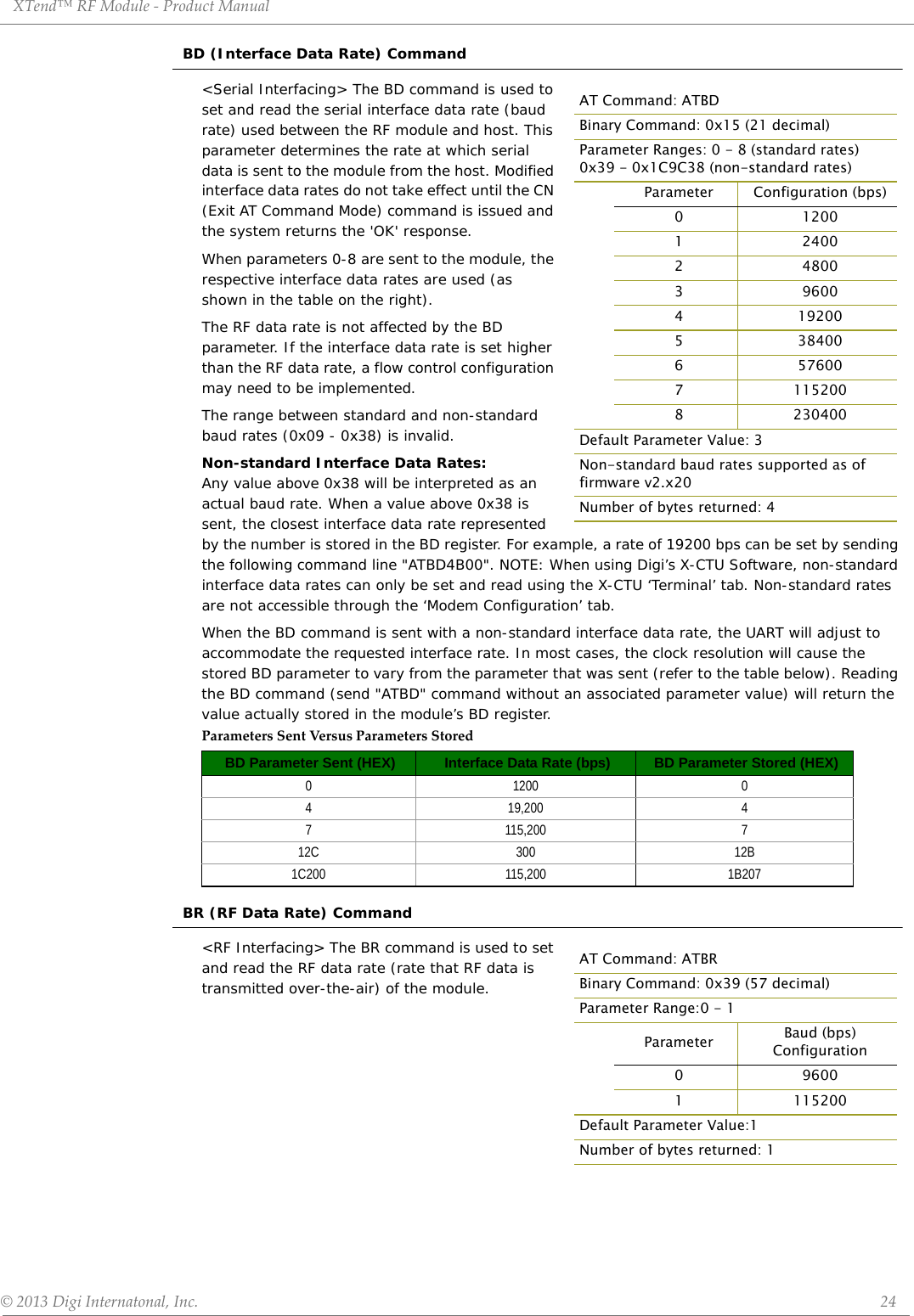
![XTend™RFModule‐ProductManual©2013DigiInternatonal,Inc. 25BT (Guard Time Before) Command<AT Command Mode Options> BT Command is used to set the DI pin silence time that must precede the command sequence character (CC command) of the AT Command Mode sequence.Refer to the ‘AT Command Mode’ section [p18] for more information regarding the AT Command Mode Sequence.CC (Command Sequence Character) Command<AT Command Mode Options> The CC command is used to set/read the ASCII character used between guard times of the AT Command Mode Sequence (BT + CC + AT). This sequence enters the module into AT Command Mode so that data entering the module (from the host) is recognized as commands instead of payload.Refer to the ‘AT Command Mode’ section [p18] for more information regarding the AT Command Mode Sequence.CD (GPO2 Configuration) Command<Serial Interfacing> CD Command is used to select/read the behavior of the GPO2 line (pin 3).CF (Number Base) Command<Command Mode Options> CF command is used to set/read the command formatting setting. The following commands are always entered and read in hex, no matter the CF setting: VR (Firmware Version)HV (Hardware Version)KY (AES Encryption Key)AT Command: ATBTBinary Command: 0x04Parameter Range: 0 - 0xFFFFDefault Parameter Value: 0x0ANumber of bytes returned: 2AT Command: ATCCBinary Command: 0x13 (19 decimal)Parameter Range: 0x20 - 0x7FDefault Parameter Value: 0x2B (ASCII “+”)Number of bytes returned: 1Related Commands: AT (Guard Time After), BT (Guard Time Before)AT Command: ATCDBinary Command: 0x28 (40 decimal)Parameter Range: 0 - 8 (standard rates)Parameter Configuration0RX LED1Default High2Default Low3(reserved)4RX LED(valid address only)Default Parameter Value: 2Number of bytes returned: 1AT Command: ATCFParameter Range: 0 – 2Parameter Configuration0Commands utilize default number base; decimal commands may output units1All commands forced to unsigned, unit-less hex2Commands utilize their default number base; no units are outputDefault Parameter Value: 1Number of bytes returned: 1](https://usermanual.wiki/Digi/9XTENDB.Updated-User-Manual/User-Guide-1882461-Page-25.png)
![XTend™RFModule‐ProductManual©2013DigiInternatonal,Inc. 26CN (Exit AT Command Mode) Command<Command Mode Options> The CN command is used to explicitly exit the module from AT Command Mode.CS (GPO1 Configuration) Command<Serial Interfacing> CS Command is used to select the behavior of the GP01 pin (pin 9). This output can provide RS-232 flow control, control the TX enable signal (for RS-485 or RS-422 operations). By default, GP01 provides RS-232 CTS (Clear-to-Send) flow control.CT (Command Mode Timeout) Command<Command Mode Options> The CT command is used to set and read the amount of inactive time that elapses before the module automatically exits from AT Command Mode and returns to Idle Mode.Use the CN (Exit AT Command Mode) command to exit AT Command Mode manually.DB (Received Signal Strength) Command<Diagnostics> DB Command is used to read the receive signal strength (in decibels relative to milliWatts) of the last received packet. This parameter is useful in determining range characteristics of the RF modules under various conditions. In default mode, this command shows the power level in signed decimal format with the units (dBm). If CF = 1, the magnitude of the value is presented in unsigned hex. If CF = 2, the value is presented in decimal, but without the units.Sample Output:-88 dBm(when ATCF = 0)58 (when ATCF = 1)-88 (when ATCF = 2)NOTE: If the DB register is read before the module has received an RF packet, the module will return a value of 0x8000 (which means an RF packet has not yet been received).AT Command: ATCNBinary Command: 0x09 (9 decimal)AT Command: ATCSBinary Command: 0x1F (31 decimal)Parameter Range: 0 - 4Parameter Configuration0 RS-232 CTS flow control1 RS-485 TX enable low2High3 RS-485 TX enable high4LowDefault Parameter Value: 0Number of bytes returned: 1Related Commands: RT (GPI1 Configuration), TO (GP01 Timeout)AT Command: ATCTBinary Command: 0x06 (6 decimal)Parameter Range:2 - 0xFFFF [x 100 milliseconds]Default Parameter Value: 0xC8 (200d)Number of bytes returned: 2Related Command: CN (Exit AT Command Mode)AT Command: ATDBBinary Command: 0x36 (54 decimal)Parameter Range (read-only): 0x6E - 0x28(-110 to -40 Decimal)Number of bytes returned: 2](https://usermanual.wiki/Digi/9XTENDB.Updated-User-Manual/User-Guide-1882461-Page-26.png)
![XTend™RFModule‐ProductManual©2013DigiInternatonal,Inc. 27DT (Destination Address) Command<Networking & Security> DT Command is used to set/read the networking address of an RF module. The modules utilize three filtration layers: Vendor ID Number (ATID), Channel (ATHP), and Destination Address (ATDT). The DT command assigns an address to a radio that enables it to communicate with other radios in the network. The simplest use of this command is that when MY=0xFFFF and MK=0xFFFF on all radios in a network, only radios with matching DT's will communicate with each other.If MY is not 0xFFFF, then DT acts as a transmit address and MY acts as a receive address. For example, MY can be set to unique values 1, 2, 3, etc. on unique radios in the network. Then set DT on the transmitting radio to match the MY of the receiving radio you intend to communicate with.Setting DT=0xFFFF will broadcast to all radios in the network. Refer to the 'Addressing' section [p45] for more information.E0 (Echo Off) Command<Command Mode Options> E0 Command turns off character echo in AT Command Mode. By default, echo is off.E1 (Echo On) Command<Command Mode Options> E1 Command enables character echo in AT Command Mode. Each typed character will be echoed back to the terminal when ATE1 is active. E0 (Echo Off) is the default.ER (Receive Error Count) Command<Diagnostics> The ER command is used to set/read the number of receive-errors. The error count records the number of packets partially received then aborted on a reception error. This value returns to 0 after a reset and is not non-volatile (Value does not persist in the module's memory after a power-up sequence). Once the Receive Error Count reaches its maximum value (up to 0xFFFF), it remains at its maximum count value until the maximum count value is explicitly changed or the module is reset.The ER parameter is not reset by pin, serial port or cyclic sleep modes.FH (Force Wake-up Initializer) Command<Sleep (Low Power)> The FH command is used to force a Wake-up Initializer to be sent on the next transmission. Use only with cyclic sleep modes active on remote modules. ATFH will not send a long header if ATHT = 0xFFFF. WR (Write) Command does not need to be issued with FH Command.AT Command: ATDTBinary Command: 0x00Parameter Range:0 - 0xFFFFDefault Parameter Value: 0Number of bytes returned: 2Related Commands: HP (Hopping Channel), ID (Modem VID), MK (Address Mask), MY (Source Address)AT Command: ATE0Binary Command: 0x0A (10 decimal)AT Command: ATE1Binary Command: 0x0B (11 decimal)AT Command: ATERBinary Command: 0x0F (15 decimal)Parameter Range: 0 - 0xFFFFDefault Parameter Value: 0Number of bytes returned: 2Related Commands: GD (Receive Good Count)AT Command: ATFHBinary Command: 0x0D (13 decimal)](https://usermanual.wiki/Digi/9XTENDB.Updated-User-Manual/User-Guide-1882461-Page-27.png)
![XTend™RFModule‐ProductManual©2013DigiInternatonal,Inc. 28FL (Software Flow Control) Command<Serial Interfacing> The FL command is used to configure software flow control. Hardware flow control is implemented with the modual as the GP01 pin (CTS pin of the RF module), which regulates when serial data can be tranferred to the module. FL Command can also be used to allow software flow control to be enabled. The XON character used is 0x11 (17 decimal). The XOFF character used is 0x13 (19 decimal).FS (Forced Synch Time) Command<RF Interfacing> The FS command only applies to streaming data. Normally, only the first packet of a continuous stream contains the full RF initializer. The RF modules then remain synchronized for subsequent packets of the stream. This parameter can be used to periodically force an RF initializer during such streaming. Any break in UART character reception long enough to drain the DI Buffer (UART receive buffer) and cause a pause in RF data transmission will also cause an RF initializer to be inserted on the next transmission.FT (Flow Control Threshold) Command<Serial Interfacing> The FT command is used to set/read the flow control threshold. When FT bytes have accumulated in the DI buffer (UART Receive), CTS is de-asserted or the XOFF software flow control character is transmitted.GD (Receive Good Count) Command<Diagnostics> The GD command is used to set/read the count of good received RF packets. Its parameter value is reset to 0 after every reset and is not non-volatile (The parameter value does not persist in the RF module's memory after a power-up sequence). Once the "Receive Good Count" reaches its maximum value (up to 0xFFFF), it remains at its maximum count value until the maximum count value is manually changed or the module is reset.The GD parameter is not reset by pin, serial port or cyclic sleep modes.HP (Hopping Channel) Command<Networking & Security> The HP command is used to set/read the RF module's hopping channel number. A channel is one of three layers of filtration available to the module. In order for modules to communicate with each other, the modules must have the same channel number since each channel uses a different AT Command: ATFLBinary Command: 0x07 (7 decimal)Parameter Range:0 - 1Default Parameter Value: 0Number of bytes returned: 1AT Command: ATFSBinary Command: 0x3E (62 decimal)Parameter Range:0 - 0xFFFF [x 10 milliseconds]Default Parameter Value: 0Number of bytes returned: 2AT Command: ATFTBinary Command: 0x24 (36 decimal)Parameter Range:0 - (DI buffer size minus 0x11) [Bytes]Default Parameter Value: DI Buffer size minus 0x11 (17 decimal)Number of bytes returned: 2AT Command: ATGDBinary Command: 0x10 (16 decimal)Parameter Range: 0 - 0xFFFFDefault Parameter Value: 0Number of bytes returned: 2Related Commands: ER (Receive Error Count) AT Command: ATHPBinary Command: 0x11 (17 decimal)Parameter Range: 0 - 9Default Parameter Value: 0Number of bytes returned: 1Related Commands: ID (Modem VID), DT (Destination Address), MK (Address Mask)](https://usermanual.wiki/Digi/9XTENDB.Updated-User-Manual/User-Guide-1882461-Page-28.png)
![XTend™RFModule‐ProductManual©2013DigiInternatonal,Inc. 29hopping sequence. Different channels can be used to prevent modules in one network from listening to transmissions of another.HT (Time before Wake-up Initializer) Command<Sleep (Low Power)> The HT command is used to set/read the time of inactivity (no serial or RF data is sent or received) before a wake-up initializer is sent by a TX (transmitting) RF module. The HT parameter should be set shorter than inactivity timeout [ST Command] time of any RX (receiving) modules operating in Cyclic Sleep (SM=4-8). The wake-up initializer sent by the TX module instructs all RX modules to remain awake to receive RF data. From the RX module perspective: After HT time elapses and the inactivity timeout [ST Command] is met, the RX module goes into cyclic sleep. In cyclic sleep, the RX module wakes once per sleep interval [SM Command] to check for a wake-up initializer. When a wake-up initializer is detected, the module stays awake to receive data. The wake-up initializer must be longer than the cyclic sleep interval to ensure that sleeping modules detect incoming data. When HT time elapses, the TX module knows it needs to send a wake-up Initializer for all RX modules to remain awake and receive the next transmission.The main purpose of this command is to prevent the Long Header from being sent with every data packet.HV (Hardware Version) Command<Diagnostics> The HV command is used to read the hardware version of the RF module.ID (Modem VID) Command<Networking & Security> The ID command is used to set/read the VID (Vendor Identification Number) of the RF module. RF modules must have matching VIDs in order to communicate.KY (AES Encryption Key) Command<Networking & Security> The KY command is used to set the 256-bit AES (Advanced Encryption Standard) key for encrypting/decrypting data. Once set, the key cannot be read out of the module by any means. The entire payload of the packet is encrypted using the key and the CRC is computed across the ciphertext. When encryption is enabled, each packet carries an additional 16 bytes to convey the random CBC Initialization Vector (IV) to the receiver(s). The KY value may be “0” or any 256-bit value (= 64 hex digits = 32 bytes). Any other value, including entering ATKY by itself with no parameters, causes an error.A module with the wrong key (or no key) will receive encrypted data, but the data driven out the serial port will be meaningless. Likewise, a module with a key will receive unencrypted data sent AT Command: ATHTBinary Command: 0x03 (3 decimal)Parameter Range:0 - 0xFFFF [x 100 milliseconds]Default Parameter Value: 0xFFFF (wake-up initializer will not be sent)Number of bytes returned: 2Related Commands: LH (Wake-up Initializer Timer), SM (Sleep Mode), ST (Time before Sleep)AT Command: ATHVParameter Range:0 - 0xFFFF [Read-only]Minimum Firmware Version Required: v1.x80AT Command: ATIDBinary Command: 0x27 (39 decimal)Parameter Range: 0x11 - 0x7FFF (user-settable) 0 - 0x10 & 0x8000 - 0xFFFF (factory-set)Default Parameter Value: 0x3332 (13106d)Number of bytes returned: 2AT Command: ATKYBinary Command: 0x3C (60 decimal)Parameter Range: 0 - (64 hex digits all set to 'F')Default Parameter Value: 0 (disabled)Number of bytes returned: 2Number Base: Always Hexadecimal](https://usermanual.wiki/Digi/9XTENDB.Updated-User-Manual/User-Guide-1882461-Page-29.png)
![XTend™RFModule‐ProductManual©2013DigiInternatonal,Inc. 30from a module without a key, but the output will be meaningless. Because CBC mode is utilized, repetitive data appears differently in different transmissions due to the randomly-generated IV.NOTE: For international (non-U.S.) variants of XTend modules, the encryption key is 128-bit AES. The command operates the same except the key length is 16 bytes rather than 32 bytes. This pertains to part numbers ending with -NA or -128 (the -NA and -128 suffix mean the same thing), no matter what firmware version is loaded. This also pertains to the Australia version of firmware 22xx, no matter what part number XTend it is loaded onto.LH (Wake-up Initializer Timer) Command<Sleep (Low Power)> The LH Command is used to set/read the duration of time during which the wake-up initializer is sent. When receiving modules are in Cyclic Sleep Mode, they power-down after a period of inactivity (as specified by the ST parameter) and will periodically wake and listen for transmitted data. In order for the receiving modules to remain awake, they must detect ~35ms of the wake-up initializer.LH Command must be used whenever a receiving module is operating in Cyclic Sleep Mode. The Wake-up Initializer Time must be longer than the cyclic sleep time that [as determined by SM (Sleep Mode) parameter]. If the wake-up initializer time were less than the Cyclic Sleep interval, the connection would be at risk of missing the wake-up initializer transmission.Refer to figures loated under the SM command description to view diagrams of correct and incorrect configurations. The images emphasize that the LH value must be greater than the SM value.MD (RF Mode) Command<Networking & Security> The MD command is used to select/read the settings that enable the Polling and Repeater Modes on the module.Polling Mode - A ‘Polling Base’ is responsible for polling remotes. A ‘Polling Remote’ requires a poll in order to transmit. Repeater Mode - A ‘Repeater’ re-sends RF data unless the transmission is addressed to it or if the transmission has already been detected. A ‘Repeater End Node’ handles repeated messages, but will not repeat the message over-the-air.Refer to the Polling and Repeater Mode sections of the ‘RF Communication Modes’ chapter for more information.AT Command: ATLHBinary Command: 0x0C (12 decimal)Parameter Range:0 - 0xFF [x 100 milliseconds]Default Parameter Value: 1Number of bytes returned: 1Related Commands: HT (Time before Wake-up Initializer), SM (Sleep Mode), ST (Time before Sleep)AT Command: ATMDBinary Command: 0x31 (49 decimal)Parameter Range: 0 - 6Parameter Configuration0 Transparent Operation(Repeater Base)1 [reserved - not used]2[reserved - not used]3Polling Base4 Polling Remote5 Repeater6 Repeater End NodeDefault Parameter Value: 0Number of bytes returned: 1Minimum Firmware Version Required: 2.x20](https://usermanual.wiki/Digi/9XTENDB.Updated-User-Manual/User-Guide-1882461-Page-30.png)
![XTend™RFModule‐ProductManual©2013DigiInternatonal,Inc. 31MK (Address Mask) Command<Networking & Security> The MK command is used to set/read the Address Mask of a module. All RF data packets contain the Destination Address of the TX (transmitting) module. When a packet is received, the TX module Destination Address is logically "ANDed" (bitwise) with the Address Mask of the RX (receiving) module. The resulting value must match the Destination Address or Address Mask of the RX module for the packet to be received and sent out the RX module's DO (Data Out) pin. If the "ANDed" value does not match the Destination Address or Address Mask of the RX module, the packet is discarded.Sniffer Mode (when MK = 0): ACK requests are ignored and every RX (receive) frame is sent to the UART, without regard for repeated frames.All “0” values are treated as irrelevant values and ignored.Refer to the ‘Addressing’ section [p45] for more information.MT (Multi-transmit) Command<Networking & Security> The MT command is used to enabled multiple transmissions of RF data packets. When Multi-transmit Mode is enabled (MT > 0), packets do not request an ACK (acknowledgement) from the receiving RF module(s). MT takes precedence over RR, so if both MT and RR are non-zero, then MT+1 packets will be sent (with no ACK requests). When a receiving module receives a packet with remaining forced retransmissions, it calculates the length of the packet and inhibits transmission for the amount of time required for all retransmissions. Thereafter, a random number of delay slots are inserted between 0 and RN before transmission is allowed from the receiving module(s). This prevents all listening modules from transmitting at once upon conclusion of a multiple transmission event (when RN > 0).NOTE: The actual number of forced transmissions is the parameter value plus one. For example, if MT = 1, two transmissions of each packet will be sent.Refer to the ‘Multi-transmit Mode’ section [p47] for more information.MY (Source Address) Command<Networking & Security> The MY command is used to set/read the Source Address of the RF module.Refer to the DT command and the 'Addressing' section [p45] for more information.AT Command: ATMKBinary Command: 0x12 (18 decimal)Parameter Range:0 - 0xFFFFDefault Parameter Value: 0xFFFF (65535d)Number of bytes returned: 2Related Commands: DT (Destination Address), HP (Hopping Channel), ID (Modem VID), MY (Source Address)AT Command: ATMTBinary Command: 0x3D (61 decimal)Parameter Range: 0 - 0xFFDefault Parameter Value:0 (no forced retransmissions)Number of bytes returned: 1Related Commands: Networking (DT, MK, MY, RN, TT), Serial Interfacing (BR, PK, RB, RO), RF Interfacing (FS)AT Command: ATMYBinary Command: 0x2A (42 decimal)Parameter Range: 0 - 0xFFFFDefault Parameter Value: 0xFFFF (Disabled - DT (Destination Address) parameter serves as both source and destination address.)Number of bytes returned: 2Related Commands: DT (Destination Address), HP (Hopping Channel), ID (Modem VID), MK (Address Mask)](https://usermanual.wiki/Digi/9XTENDB.Updated-User-Manual/User-Guide-1882461-Page-31.png)
![XTend™RFModule‐ProductManual©2013DigiInternatonal,Inc. 32NB (Parity) Command<Serial Interfacing> The NB command is used to select/read the parity settings of the RF module for UART communications.PB (Polling Begin Address) Command<Networking & Security> PB command is used to set/read the module’s Polling Begin Address - the first address polled Polling Mode is enabled.Polling Operations: The ‘Polling Base’ (MD = 3) cycles through a sequential range of addresses, polling each ‘Polling Remote’ (MD = 4). The base then waits for a response & proceeds to the next ‘Polling Remote’. Each ‘Polling Remote’ responds by sending the data from the Data In buffer following the RB & RO parameters. When there is no eligible data to send, the ‘Polling Remote’ will not respond. The ‘Polling Base’ will move to the next address in the polling sequence after a short delay.PD (Minimum Polling Delay) Command<Networking & Security> The PD command is used to set/read Polling Delay (Base, MD=3) or Polling Timeout (Remote, MD=4). Polling Delay (Base) is the time between polling cycles. The Polling Base will start the polling cycle after sending the first poll. After the polling cycle has completed, the timer is restarted.Polling Timeout (Remote) is the amount of time the remote unit will hold data from the serial port before discarding it. Data entered within the PD time of the poll is transmitted and not discarded.PE (Polling End Address) Command<Networking & Security> PE command is used to set/read the module’s Polling End Address - the last address polled when Polling Mode is enabled.Polling Operations: The ‘Polling Base’ (MD = 3) cycles through a sequential range of addresses, polling each ‘Polling Remote’ (MD = 4). The base then waits for a response & proceeds to the next ‘Polling Remote’. Each ‘Polling Remote’ responds by sending data from the DI buffer following the RB & RO parameters. When there is no eligible data to send, the ‘Polling Remote’ will not respond. The ‘Polling Base’ will move to the next address in the polling sequence after a short delay.AT Command: ATNBBinary Command: 0x23 (35 decimal)Parameter Range: 0 - 4Parameter Configuration08-bit (no parity or7-bit (any parity)18-bit even28-bit odd38-bit mark48-bit spaceDefault Parameter Value: 0Number of bytes returned: 1AT Command: ATPBBinary Command: 0x45 (69 decimal)Parameter Range: 0 - 0xFFFFDefault Parameter Value: 0Number of bytes returned: 2Minimum Firmware Version Required: 2.x20Related Commands: MD (RF Mode), PE (Polling End Address), PD (Minimum Polling Delay)AT Command: ATPDBinary Command: 0x47 (71 decimal)Parameter Range: 0 - 0xFFFF(Base: [x 1ms], Remote: [x 10ms])Default Parameter Value: 0Number of bytes returned: 2Minimum Firmware Version Required: 2.x20Related Commands: MD (RF Mode), PB (Polling Begin Address), PE (Polling End Address)AT Command: ATPEBinary Command: 0x46 (70 decimal)Parameter Range: 0 - 0xFFFFDefault Parameter Value: 0Number of bytes returned: 2Minimum Firmware Version Required: 2.x20Related Commands: MD (RF Mode), PB (Polling Begin Address), PD (Minimum Polling Delay)](https://usermanual.wiki/Digi/9XTENDB.Updated-User-Manual/User-Guide-1882461-Page-32.png)
![XTend™RFModule‐ProductManual©2013DigiInternatonal,Inc. 33PK (Maximum RF Packet Size) Command<RF Interfacing> The PK command is used to set/read the maximum size of RF packets transmitted from an RF module. The maximum packet size can be used along with the RB and RO parameters to implicitly set the channel dwell time. If PK is set above 256 and BR is subsequently changed to 0, PK will automatically be lowered to 256 and a warning will be raised (refer to the BR (RF Data Rate) and WN (Warning Data) commands for details).Changes to the PK parameter may have a secondary effect on the RB (Packetization Threshold) parameter. RB must always be less than or equal to PK. If PK is changed to a value that is less than the current value of RB, the RB value is automatically lowered to be equal to PK.* When BR = 0 (9600 baud), the maximum PK value is 0x100 (256d). When BR = 1 (115,200 baud), the maximum PK value is 0x800 (2048d).PL (TX Power Level) Command<RF Interfacing> The PL command is used to set/read the power level at which the RF module transmits dataPW (Pin Wake-up) Command<Sleep (Low Power)> Under normal operation, an RF module in Cyclic Sleep Mode cycles from an active state to a low-power state at regular intervals until data is ready to be received. If the PW parameter is set to 1, the SLEEP pin (pin 8) can be used to awaken the module from Cyclic Sleep. When the SLEEP Pin is de-asserted (low), the module will be fully operational and will not go into Cyclic Sleep. Once the SLEEP pin is asserted, the module will remain active for the period of time specified by the ST (Time before Sleep) parameter and will return to Cyclic Sleep Mode (if no data is ready to be transmitted). PW Command is only valid if Cyclic Sleep has been enabled.AT Command: ATPKBinary Command: 0x29 (41 decimal)Parameter Range:1 - 0x800 [Bytes]Default Parameter Value:0x100* or 0x800*(256 or 2048 decimal)Number of bytes returned: 2Related Commands: BR (RF Data Rate) RB (Packetization Threshold), RO (Packetization Timeout), WN (Warning Data)AT Command: ATPLBinary Command: 0x3A (58 decimal)Parameter Range: 0 - 4Parameter Configuration01 mW110 mW2 100 mW3 500 mW4 1000 mW (1 Watt)Default Parameter Value: 4Number of bytes returned: 1AT Command: ATPWBinary Command: 0x1D (29 decimal)Parameter Range: 0 - 1Parameter Configuration0 Disabled1EnabledDefault Parameter Value: 0Number of bytes returned: 1Related Commands: SM (Sleep Mode), ST (Time before Sleep)](https://usermanual.wiki/Digi/9XTENDB.Updated-User-Manual/User-Guide-1882461-Page-33.png)
![XTend™RFModule‐ProductManual©2013DigiInternatonal,Inc. 34RB (Packetization Threshold) Command<Serial Interfacing> The RB command is used to set/read the character threshold value.RF transmission begins after data is received in the DI Buffer and either of the following criteria is met:• RB characters received by the UART• RO character times of silence detected on the UART receive lines (after receiving at least 1 Byte of data)If PK (Max. RF Packet Size) is lowered below the value of RB, RB is automatically lowered to match the PK value. If (RO = 0), RB bytes must be received before beginning transmission.Note: RB and RO criteria only apply to the first packet of a multi-packet transmission. If data remains in the DI Buffer after the first packet, transmissions will continue in a streaming manner until there is no data left in the DI Buffer (UART receive buffer).RC (Ambient Power - Single Channel) Command<Diagnostics> The RC command is used to examine and report the power level on a given channel.Sample output:-78 dBm [when CF = 0] 4e [when CF = 1] -78 [when CF = 2]RE (Restore Defaults) Command<Diagnostics> The RE command is used to restore all configurable parameters to their factory default settings. The RE Command does not cause default values to be stored to non-volatile (persistent) memory. For the restored default settings to persist in the module’s non-volatile memory and be saved in the event of RF module reset or power-down, the WR (Write) command must be issued prior to power-down or reset.RM (Ambient Power - All Channels) Command<Diagnostics> The RM command is used to examine and report power levels on all channels. If no parameter is given, the channels are scanned one time. If a parameter is given, the channels are repeatedly scanned for that number of seconds. The maximum power level seen for each channel is reported (i.e. peak hold).A graphical spectrum analyzer can be implemented by repeatedly sending the RM command (with no arguments) and reading the resultant 50 power levels (this is easiest to do when CF = 1 or 2).Sample output [when CF = 0]: Ch 0: -100 dBm Ch 1: -103 dBm...Ch 49: -99 dBmSample output [when CF = 1]: 6467 ... 63Sample output [when CF = 2]: 100-103 … -99AT Command: ATRBBinary Command: 0x20 (32 decimal)Parameter Range:0 - PK parameter value(up to 0x800 Bytes)Default Parameter Value: 0x800 BytesNumber of bytes returned: 2Related Commands: BR (RF Data Rate), PK (RF Packet Size), RO (Packetization Timeout)AT Command: ATRCParameter Range (read-only): 0 - 0x31 [dBm]Number of bytes returned: 1Related Commands: RM (Ambient Power - All Channels)AT Command: ATREBinary Command: 0x0E (14 decimal)AT Command: ATRMParameter Range: no parameter - 0x7D0)Number of bytes returned: 2Related Commands: RC (Ambient Power - Single channel)](https://usermanual.wiki/Digi/9XTENDB.Updated-User-Manual/User-Guide-1882461-Page-34.png)
![XTend™RFModule‐ProductManual©2013DigiInternatonal,Inc. 35RN (Delay Slots) Command<Networking & Security> The RN command is used to set/read the time delay that the transmitting RF module inserts before attempting to resend a packet. If the transmitting module fails to receive an acknowledgement after sending a packet, it inserts a random number of delay slots (ranging from 0 to (RN minus 1)) before attempting to resend the packet. Each delay slot is 5 msec (when BR=1) and 54 msec (when BR=0). If two modules attempt to transmit at the same time, the random time delay after packet failure allows only one module to transmit the packet successfully; while the other module waits until the channel available for RF transmission.RN Command is only applicable if retries have been enabled [RR (Retries) Command] or if forced delays will be inserted into a transmission [TT (Streaming Limit) Command].RO (Packetization Timeout) Command<Serial Interfacing> The RO command is used to set/read the Packetization Timeout setting. RF transmission begins when data is in the DI buffer and either of the following criteria are met:• RO character times of silence on the UART receive lines (after receiving at least 1 byte)• RB characters have been received by the UARTRB and RO criteria only apply to the first packet of a multi-packet transmission. If data remains in the DI Buffer (UART receive) after the first packet, transmissions will continue in a streaming manner until there is no data left in the DI Buffer.When RO is the transmission-beginning criteria: The actual time between the reception of the last character from the UART and the beginning of RF transmission will be at least 800 µsec longer than the actual RO time to allow for transmission setup. Additionally, it is subject to 100-200 µsec of additional uncertainty, which could be significant for small values of RO at high UART bit rates.The correct UART character time (10, 11, or 12 bits) is calculated based on the following criteria:•1 start bit• 8 data bits• 0 or 1 parity bit [as determined by the NB (Parity) Command)• 1 or 2 stop bits [as determined by SB (Stop Bits) Command]RP (RSSI PWM Timer) Command<Diagnostics> RP Command is used to enable a PWM ("Pulse Width Modulation") output on the Config/RSSI pin (pin 11 of the RF Module). The pin is calibrated to show the difference between received signal strength and the sensitivity level of the RF module. PWM pulses vary from zero to 95 percent. Zero percent means the received RF signal is at or below the published sensitivity level of the module. AT Command: ATRNBinary Command: 0x19 (25 decimal)Parameter Range:0 - 0xFF [38 ms slots]Default Parameter Value: 0 (no delay slots inserted)Number of bytes returned: 1Related Commands: RR (Retries), TT (Streaming Limit)AT Command: ATROBinary Command: 0x21 (33 decimal)Parameter Range:0 - 0xFFFF [ x UART character times ]Default Parameter Value: 3Number of bytes returned: 2Related Commands: RB (Packetization Threshold) AT Command: ATRPBinary Command: 0x22 (34 decimal)Parameter Range:0 - 0xFF[x 100 milliseconds]Default Parameter Value: 0x20 (32d)Number of bytes returned: 1](https://usermanual.wiki/Digi/9XTENDB.Updated-User-Manual/User-Guide-1882461-Page-35.png)
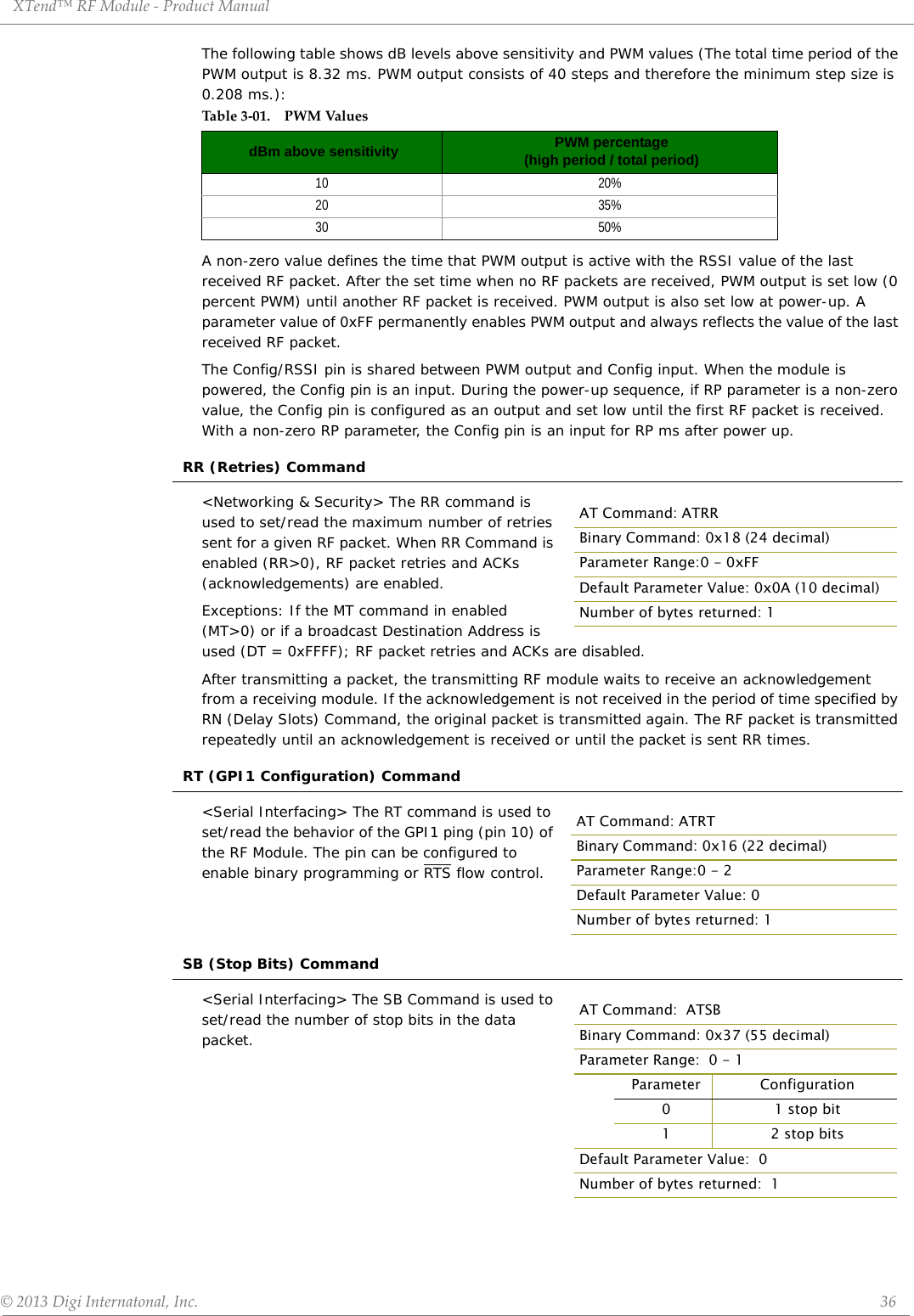
![XTend™RFModule‐ProductManual©2013DigiInternatonal,Inc. 37SH (Serial Number High) Command<Diagnostics> SH Command is used to set/read the serial number high word of the RF module.SL (Serial Number Low) Command<Diagnostics> SL Command is used to set/read the serial number low word of the RF module.SM (Sleep Mode) Command<Sleep Mode (Low Power)> The SM Command is used to set/read the RF module's Sleep Mode settings that configure the module to run in states that require minimal power consumption.For more information regarding Sleep Modes, refer to the Sleep Mode sections [p15]AT Command: ATSHBinary Command: 0x25 (37 decimal)Parameter Range (read-only): 0 - 0xFFFFDefault Parameter Value: variesNumber of bytes returned: 2Related Commands: SL (Serial Number Low)AT Command: ATSLBinary Command: 0x26 (38 decimal)Parameter Range (read-only): 0 - 0xFFFF Default Parameter Value: variesNumber of bytes returned: 2Related Commands: SH (Serial Number High)AT Command: ATSMBinary Command: 0x01Parameter Range: 0 - 8 (3 is reserved)Parameter Configuration0 Disabled1Pin Sleep2 Serial Port Sleep3 [reserved]4Cyclic 1.0 second sleep(RF module wakes every 1.0 seconds)5 Cyclic 2.0 second sleep6 Cyclic 4.0 second sleep7 Cyclic 8.0 second sleep8 Cyclic 16.0 second sleepDefault Parameter Value: 0Number of bytes returned: 1Related Commands: Pin Sleep - PC (Power-up Mode), PW (Pin Wake-up)Serial Port Sleep - ST (Time before Sleep)Cyclic Sleep - ST (Time before Sleep), LH (Wake-up Initializer Timer), HT (Time Before Wake-up Initializer), PW (Pin Wake-up)](https://usermanual.wiki/Digi/9XTENDB.Updated-User-Manual/User-Guide-1882461-Page-37.png)
![XTend™RFModule‐ProductManual©2013DigiInternatonal,Inc. 38ST (Time before Sleep) Command<Sleep Mode (Low Power)> The ST Command is used to set/read the period of time (in milliseconds) in which the RF module remains inactive before entering Sleep Mode. For example, if the ST Parameter is set to 0x64 (100 decimal), the module will enter into Sleep mode after 10 seconds of inactivity (no transmitting or receiving). This command can only be used if Cyclic Sleep or Serial Port Sleep Mode settings have been selected using SM (Sleep Mode) Command.TP (Board Temperature) Command<Diagnostics> TP Command is used to read the current temperature of the board.Sample Output:26 C[when ATCF = 0]1A [when ATCF = 1] 26 [when ATCF = 2].TR (Transmit Error Count) Command<Diagnostics> The TR command is used to report the number of retransmit failures. This number is incremented each time a packet is not acknowledged within the number of retransmits specified by the RR (Retries) parameter. The number of packets therefore are counted that were not successfully received and subsequently discarded. The TR parameter is not non-volatile and is reset to zero when the RF module is reset.TT (Streaming Limit) Command<Networking & Security> The TT command is used to set/read the limit on the number of bytes that can be sent out before a random delay is issued. If an RF module is sending a continuous stream of RF data, a delay is inserted which stops its transmission and allows other modules time to transmit (once it sends TT bytes of data). Inserted random delay lasts between 1 & 'RN + 1' delay slots, where each delay slot lasts 38 ms. The TT command can be used to simulate full-duplex behavior.AT Command: ATSTBinary Command: 0x02 (2 decimal)Parameter Range:(ATAT+3) - 0x7FFF [x 100 milliseconds]Default Parameter Value: 0x64 (100 decimal)Number of bytes returned: 2Related Commands: SM (Sleep Mode), LH (Wake-up Initializer Timer), HT (Time before Wake-up Initializer)AT Command: ATTPBinary Command: 0x38 (56 decimal)Parameter Range (read-only): 0- 0x7FNumber of bytes returned: 1Related Command: WN (Warning Data)AT Command: ATTRBinary Command: 0x1B (27 decimal)Parameter Range: 0 - 0xFFFFDefault Parameter Value: 0Number of bytes returned: 2Related Commands: RR (Retries)AT Command: ATTTBinary Command: 0x1A (26 decimal)Parameter Range:0 - 0xFFFFDefault Parameter Value: 0 (disabled)Number of bytes returned: 2Related Commands: RN (Delay Slots)](https://usermanual.wiki/Digi/9XTENDB.Updated-User-Manual/User-Guide-1882461-Page-38.png)
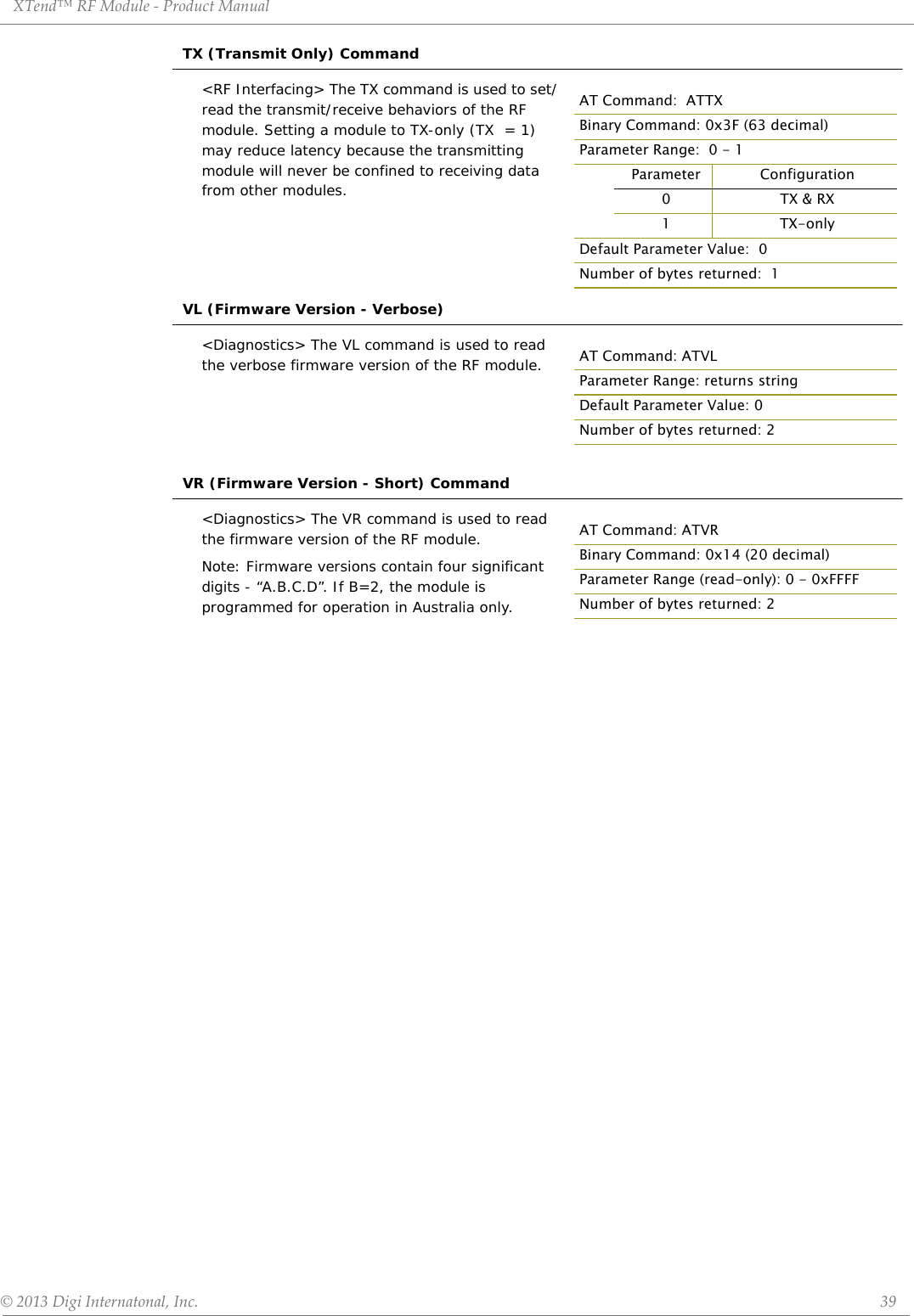
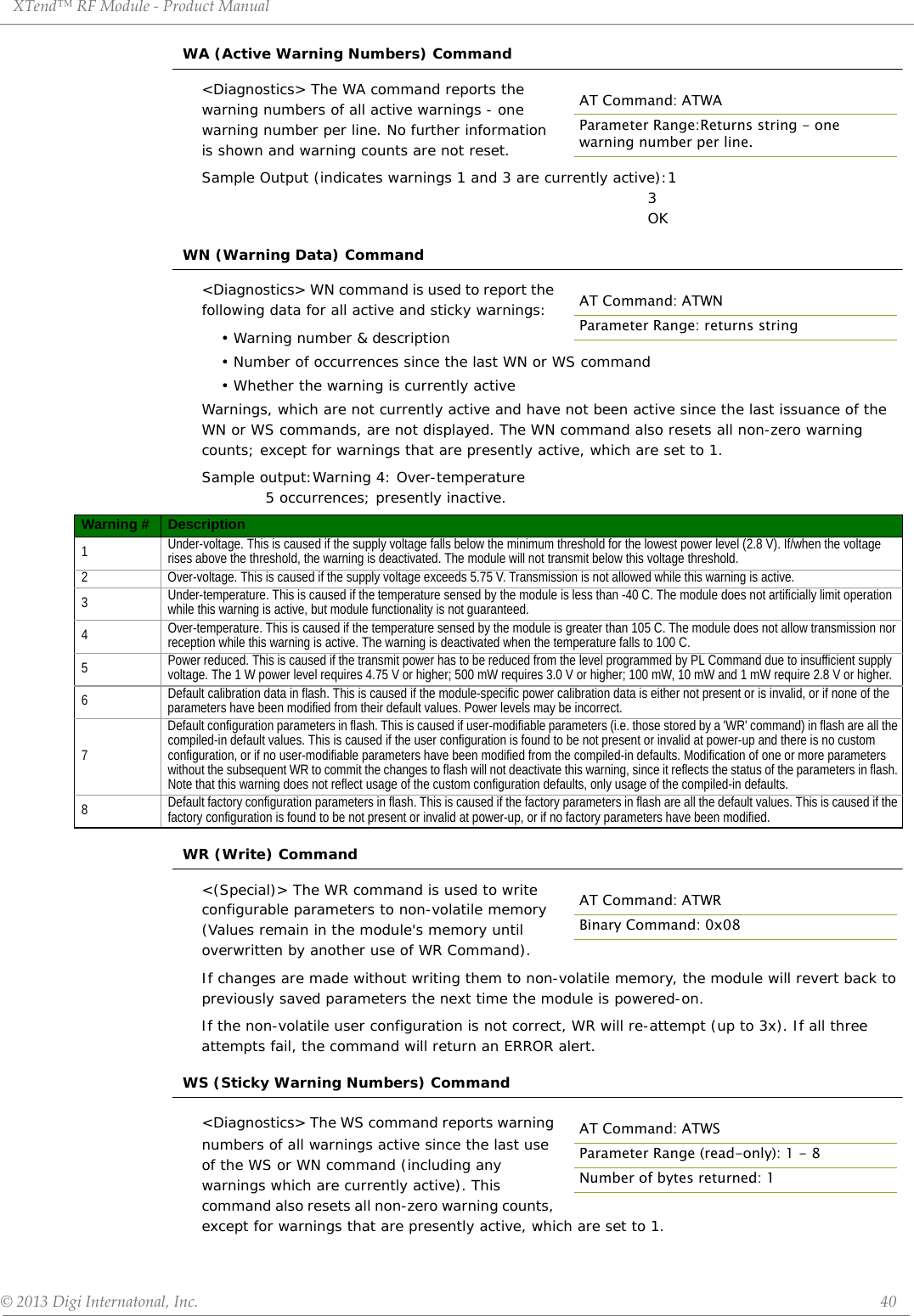
![XTend™RFModule‐ProductManual©2013DigiInternatonal,Inc. 41API OperationBy default, XTend RF Modules act as a serial line replacement (Transparent Operation) - all UART data received through the DI pin is queued up for RF transmission. When the module receives an RF packet, the data is sent out the DO pin with no additional information.Inherent to Transparent Operation are the following behaviors:• If module parameter registers are to be set or queried, a special operation is required for transitioning the module into Command Mode [refer to p17].• In point-to-multipoint systems, the application must send extra information so that the receiving module(s) can distinguish between data coming from different remotes.As an alternative to the default Transparent Operation, API (Application Programming Interface) Operations are available. API operation requires that communication with the module be done through a structured interface (data is communicated in frames in a defined order). The API specifies how commands, command responses and module status messages are sent and received from the module using a UART data frame.API Frame SpecificationsTwo API modes are supported and both can be enabled using the AP (API Enable) command. Use the following AP parameter values to configure the module to operate in a particular mode:• AP = 0 (default): Transparent Operation (UART Serial line replacement)API modes are disabled.•AP = 1: API Operation•AP = 2: API Operation (with escaped characters)Any data received prior to the start delimiter is silently discarded. If the frame is not received correctly or if the checksum fails, the data is silently discarded.API Operation (AP parameter = 1)When this API mode is enabled (AP = 1), the UART data frame structure is defined as follows:Figure3‐01. UARTDataFrameStructure:MSB=MostSignificantByte,LSB=LeastSignificantByteAPI Operation - with Escape Characters (AP parameter = 2)When this API mode is enabled (AP = 2), the UART data frame structure is defined as follows:Figure3‐02. UARTDataFrameStructure‐withescapecontrolcharacters:MSB=MostSignificantByte,LSB=LeastSignificantByteEscape characters. When sending or receiving a UART data frame, specific data values must be escaped (flagged) so they do not interfere with the UART or UART data frame operation. To escape an interfering data byte, insert 0x7D and follow it with the byte to be escaped XOR’d with 0x20.Start Delimiter(Byte 1) Length(Bytes 2-3) Frame Data(Bytes 4-n) Checksum(Byte n + 1)0x7E MSB LSB API-specific Structure 1 ByteStart Delimiter(Byte 1) Length(Bytes 2-3) Frame Data(Bytes 4-n) Checksum(Byte n + 1)0x7E MSB LSB API-specific Structure 1 ByteCharacters Escaped If Needed](https://usermanual.wiki/Digi/9XTENDB.Updated-User-Manual/User-Guide-1882461-Page-41.png)
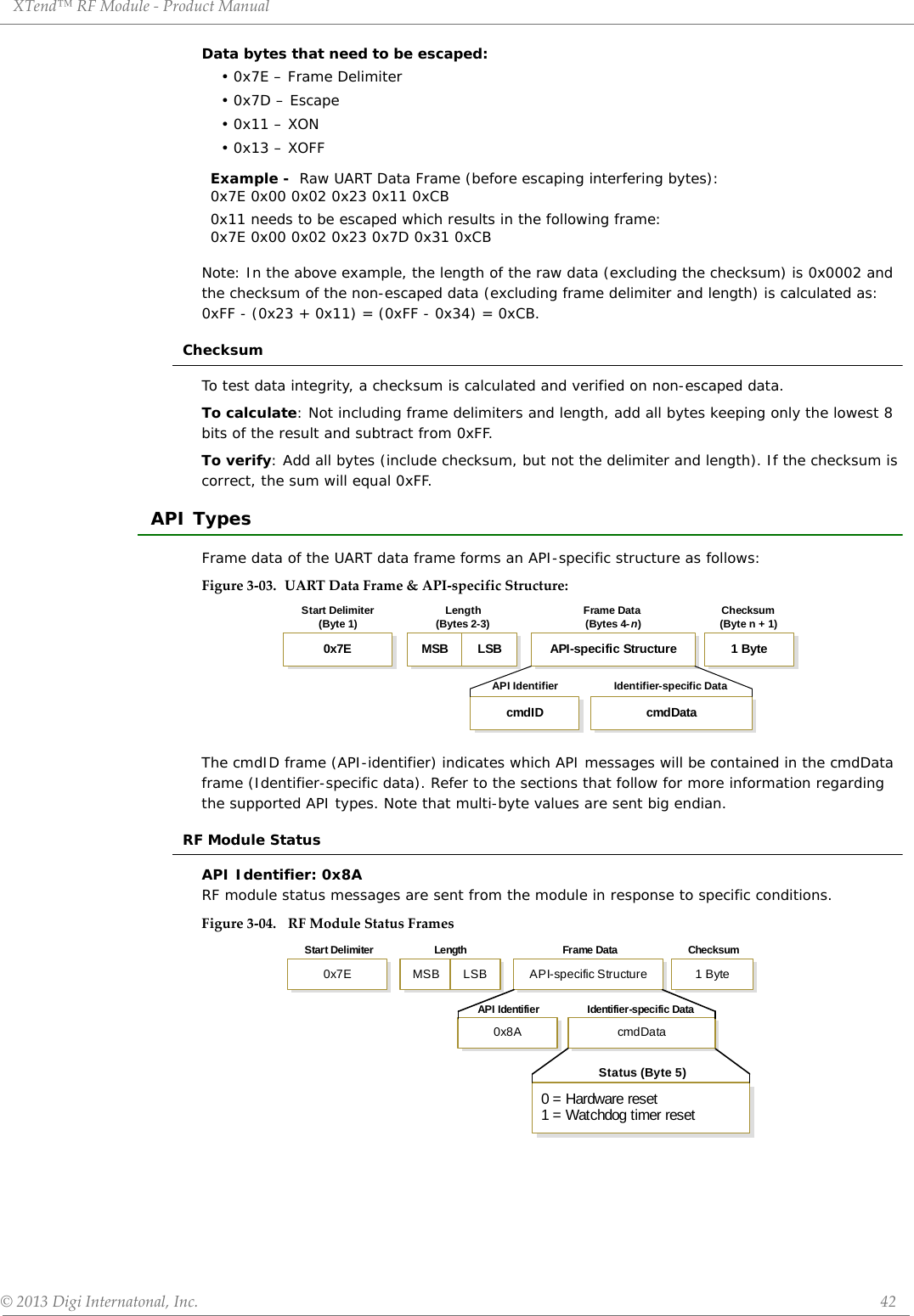
![XTend™RFModule‐ProductManual©2013DigiInternatonal,Inc. 43TX (Transmit) Request: 16-bit addressAPI Identifier Value: 0x01A TX Request message will cause the module to send RF Data as an RF Packet.Figure3‐5. TXPacket(16‐bitaddress)FramesFigure3‐6. Example:TXPacketAPIFramesTX (Transmit) StatusAPI Identifier Value: 0x89When a TX Request is completed, the module sends a TX Status message. This message will indicate if the packet was transmitted successfully or if there was a failure.Figure3‐7. TXStatusFramesNOTE: “STATUS = 1” occurs when all retries are expired and no ACK is received.“STATUS = 3” occurs when a packet is purged due to a ‘Polled Remote’ not receiving a poll.RX (Receive) Packet: 16-bit addressAPI Identifier Value: 0x81When the module receives an RF packet, it is sent out the UART using this message type.Figure3‐8. RXPacket(16‐bitaddress)FramescmdData0x01Length ChecksumStart Delimiter Frame DataIdentifier-specific DataAPI IdentifierMSB LSB0x7E 1 ByteAPI-specific StructureFrame ID (Byte 5)Identifies the UART data frame for the host tocorrelate with a subsequent ACK (acknowledgement).Setting Frame ID to ‘0' will disable response frame.Destination Address (Bytes 6-7)MSB first, LSB last.Broadcast = 0xFFFFOptions (Byte 8)0 = Standard1 = Disable ACKRF Data (Byte(s) 9-n)Up to 2048 Bytes per packet*Length[Bytes]=APIIdentifier+FrameID+Option+RFData**“R”valuewasarbitrarilyselectedChecksum0x18Byte 12Destination AddressBytes 6-70xFFFFOption0x00Byte 8Frame ID**R (0x52)Byte 5Length*Bytes 2-30x00 0x08API Identifier0x01Byte 4Start DelimiterByte 10x7ERF Data1 (0x31) 2 (0x32) 3 (0x33)Bytes 9-11cmdData0x89Length ChecksumStart Delimiter Frame DataIdentifier-specific DataAPI IdentifierMSB LSB0x7E 1 ByteAPI-specific StructureFrame ID (Byte 5) Status (Byte 6)0 = Success1 = No ACK (Acknowledgement) receivedIdentifies UART data frame being reported.Note: If Frame ID = 0 in the TX Request, noAT Command Response will be given.cmdData0x81Length ChecksumStart Delimiter Frame DataIdentifier-specific DataAPI IdentifierMSB LSB0x7E 1 ByteAPI-specific Structurebit 0 = ACKbit 1 = Indicate broadcastbits 2-7 [reserved]Up to 2048 Bytes perpacketReceived Signal Strength Indicator -Hexadecimal equivalent of (-dBm) value.(For example: If RX signal strength = -40dBm, “0x28” (40 decimal) is returned)Source Address (Bytes 5-6) RSSI (Byte 7)MSB (most significant byte) first,LSB (least significant) lastOptions (Byte 8) RF Data (Byte(s) 9-n)](https://usermanual.wiki/Digi/9XTENDB.Updated-User-Manual/User-Guide-1882461-Page-43.png)
![©2013DigiInternationalInc. 444.RFCommunicationModesThe network configurations covered in this chapter are described in terms of the following:• Network Topology (Point-to-Point, Point-to-Multipoint or Peer-to-Peer)• RF Communication Type (Basic or Acknowledged)• RF Mode (Streaming, Multi-Transmit, Repeater, Acknowledged or Polling)Note: Please see the DigiMesh chapter for additional information on networking features. The following table provides a summary of the network configurations supported.*Assumedefaultvaluesforparametersnotlisted.Profilesdonotreflectaddressingimplementations.**AM(Auto‐setMY)CommandmustbeissuedthroughaterminalprogramsuchastheoneincorporatedintheX‐CTUʹTerminalʹtab.Table4‐01. SummaryofnetworktopologiessupportedbytheXTendRFModulePoint-to-PointDefinition An RF data link between two modules.Sample Network Profile *(Broadcast Communications) Use default values for all modules.Sample Network Profile *(Acknowledged Communications) All modules: ATAM [auto-set MY (Source Address) parameter] **ATDT FFFF [set Destination Address to 0xFFFF]Basic RF Modes Streaming, Multi-Transmit, RepeaterAcknowledged RF Mode Acknowledged ModePoint-to-MultipointDefinition RF data links between one base and multiple remotes.Sample Network Profile *(Basic Communications)Base: ATMY 0 [set Source Address to 0x00]ATDT FFFF [set Destination Address to 0xFFFF]Remotes: ATAM [auto-set MY (Source Address) parameter] **ATDT 0 [set Destination Address to 0x00]Sample Network Profile *(Acknowledged Communications)Base:ATMY 0 [set Source Address to 0x00]ATDT FFFF [set Destination Address to 0xFFFF]ATRR 3 [set number of Retries to 3]Remotes:ATAM [auto-set MY (Source Address) parameter] **ATDT 0 [set Destination Address to 0x00]ATRR 3 [set number of Retries to 3]Basic RF Modes Streaming, Multi-Transmit, Repeater, PollingAcknowledged RF Modes Acknowledged, Polling Peer-to-PeerDefinitionRF modules remain synchronized without use of master/server dependencies. Each module shares the roles of master and slave. Digi's peer-to-peer architecture features fast synch times (35ms to synchronize modules) and fast cold start times (50ms before transmission).Sample Network Profile *(Basic Communications) Use default values for all modules.Sample Network Profile *(Acknowledged Communications) All modules:ATAM [auto-set MY (Source Address) parameter] **ATDT FFFF [set Destination Address to 0xFFFF]ATRR 3 [set number of Retries to 3]Basic RF Mode StreamingAcknowledged RF Mode Acknowledged](https://usermanual.wiki/Digi/9XTENDB.Updated-User-Manual/User-Guide-1882461-Page-44.png)
![XTend™RFModule‐ProductManual©2013DigiInternatonal,Inc. 45AddressingEach RF packet contains addressing information that is used to filter incoming RF data. Receiving modules inspect the Hopping Channel (HP parameter), Vendor Identification Number (ID parameter) and Destination Address (DT parameter) contained in each RF packet. Data that does not pass through all three network security layers is discarded.Figure4‐01. AddressinglayerscontainedintheRFpacketheaderAddress RecognitionTransmissions can be addressed to a specific module or group of modules using the DT (Destination Address) and MK (Address Mask) commands. A receiving module will only accept a packet if it determines the packet is addressed to it, either as a global or local packet. The receiving module makes this determination by inspecting the destination address of the packet and comparing it to its own address and address mask [refer to the figure below].Figure4‐02. AddressRecognition(@theReceivingRFModule)TX_DT=DestinationAddressoftransmittingmoduleRX_DT=DestinationAddressofreceivingmoduleRX_MK=AddressMaskofreceivingmoduleRX_MY=SourceAddressofreceivingmoduleThe transmitting module determines whether the packet is intended for a specific node (local address) or multiple nodes (global address) by comparing the packet's destination address (DT) and its own address mask (MK) [refer to the figure below]. It is assumed that the address masks on the transmitting module and receiving module have been programmed to the same value for proper operation in each RF Communication Mode.Figure4‐03. AddressRecognition(@theTransmittingRFModule)](https://usermanual.wiki/Digi/9XTENDB.Updated-User-Manual/User-Guide-1882461-Page-45.png)
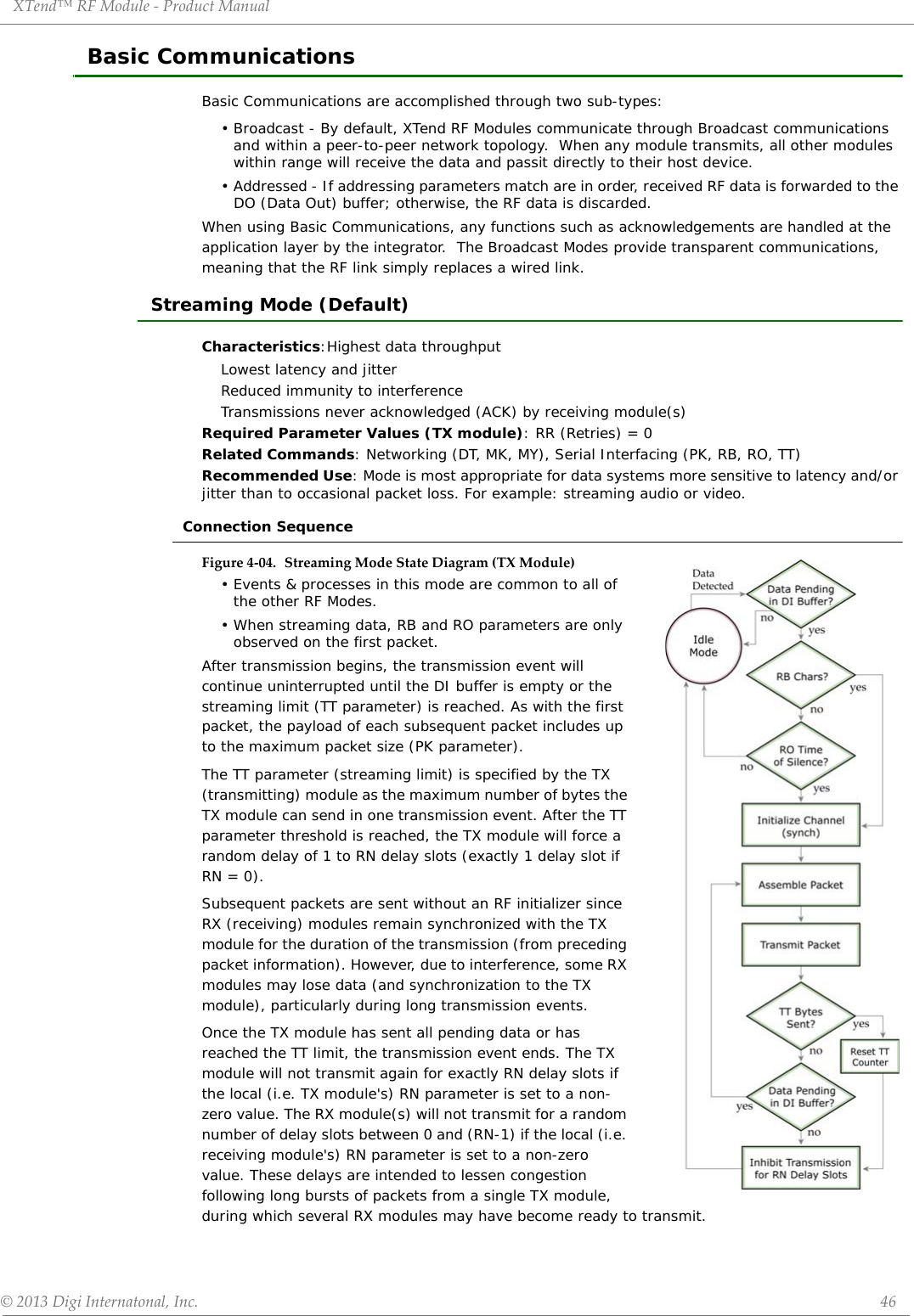
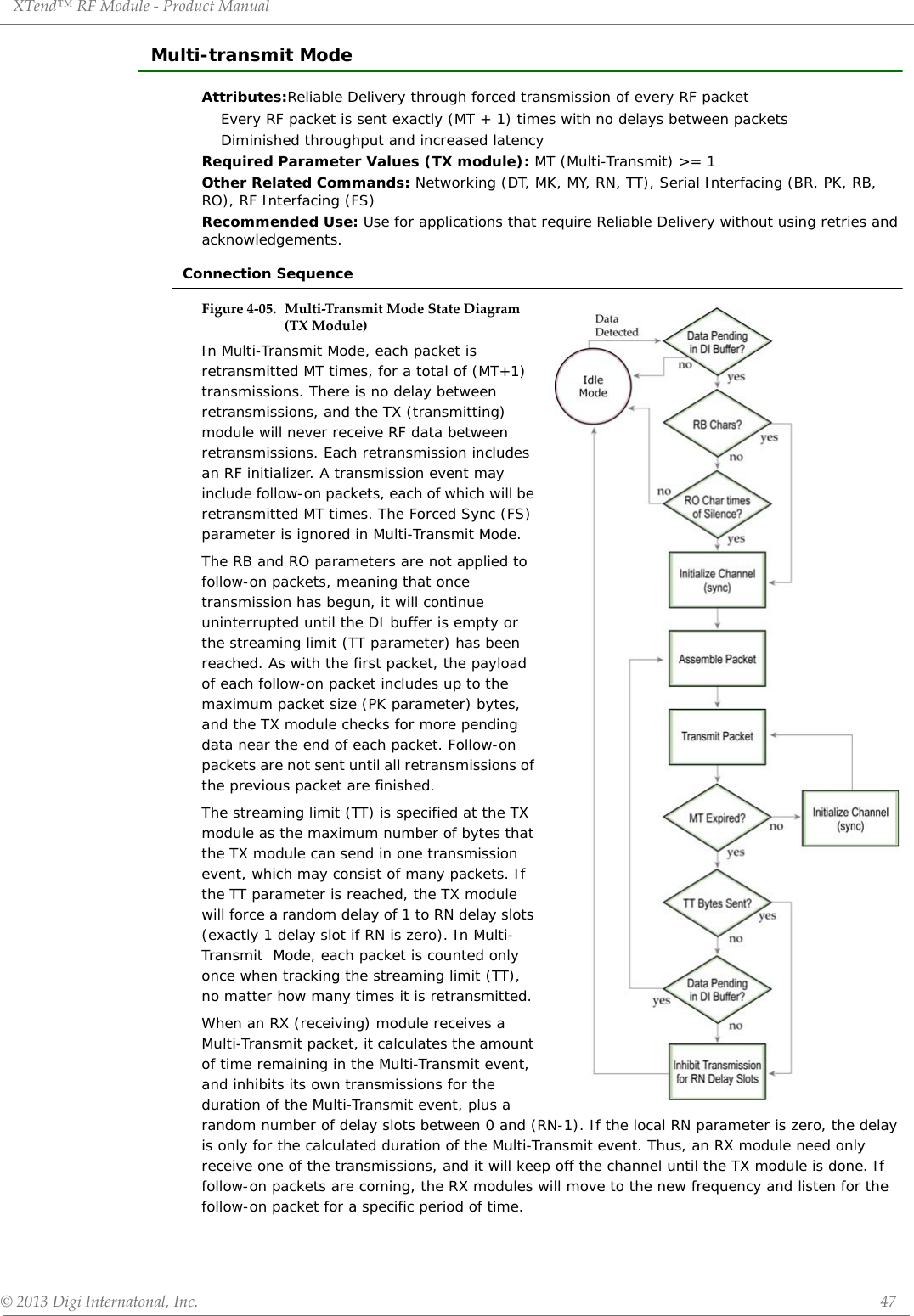
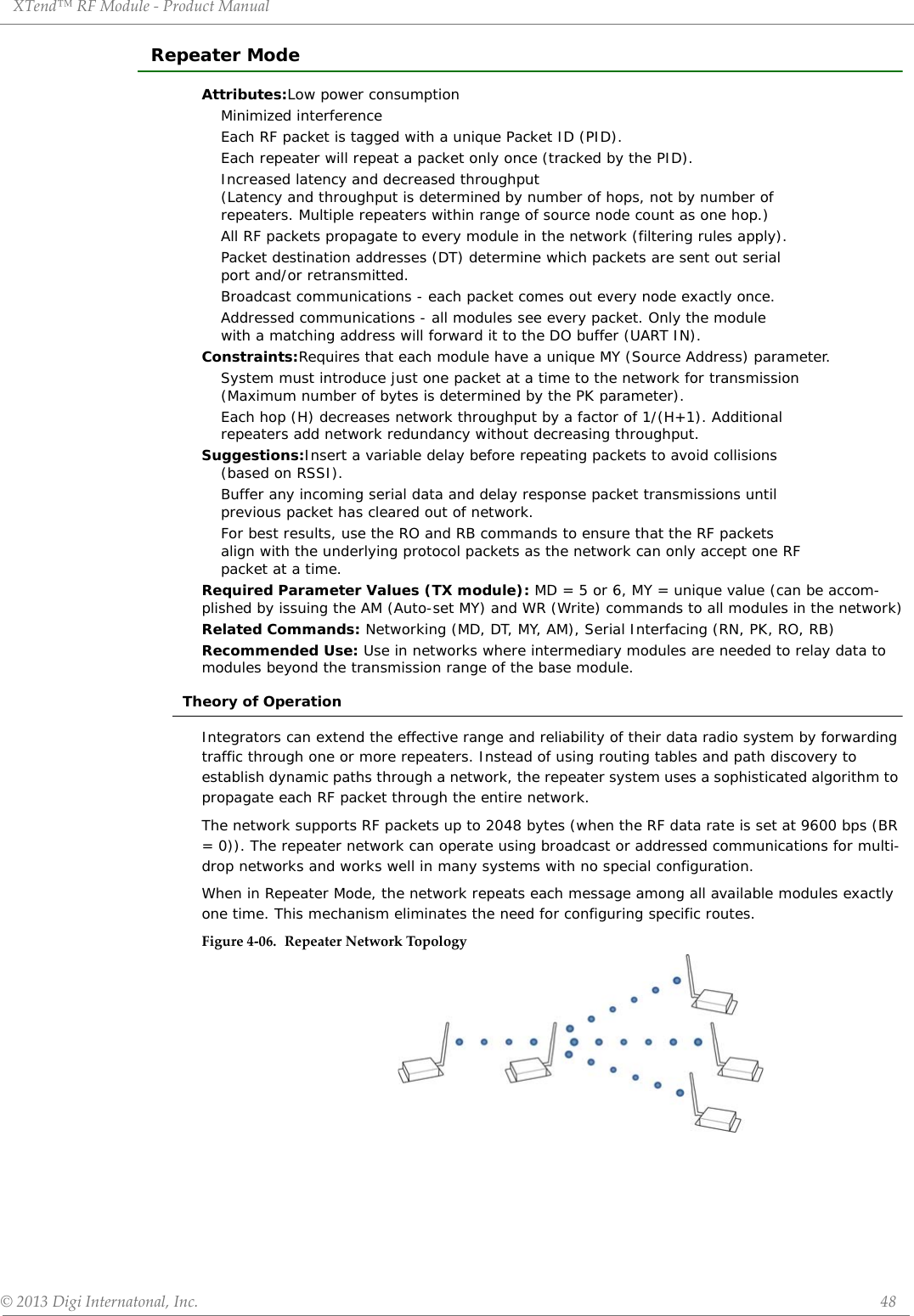
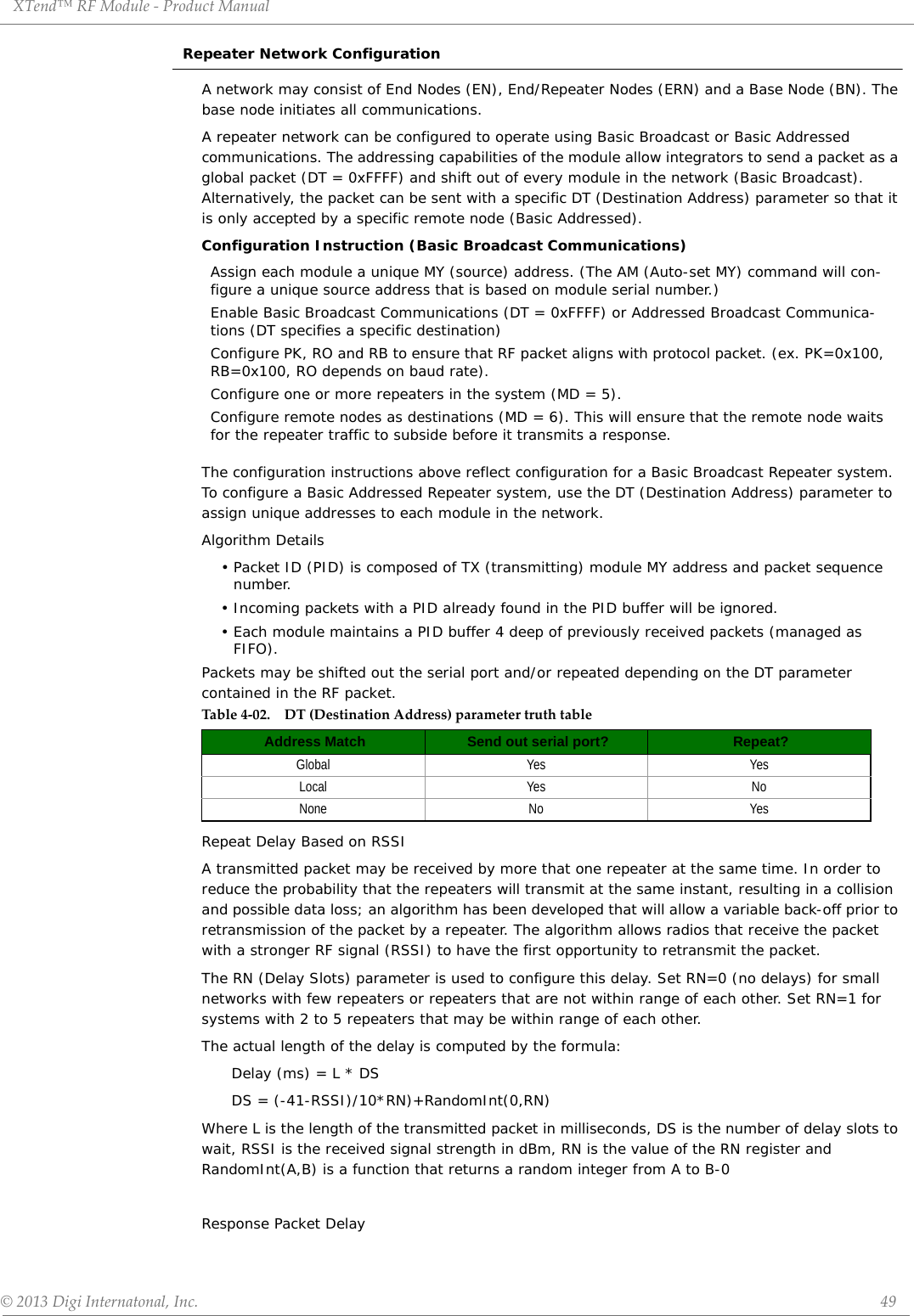
![XTend™RFModule‐ProductManual©2013DigiInternatonal,Inc. 50As a packet propagates through the repeater network, if any node receives the data and generates a quick response, the response needs to be delayed so as not to collide with subsequent retransmissions of the original packet. To reduce collisions, both repeater and end node radios in a repeater network will delay transmission of data shifted in the serial port to allow any repeaters within range to complete their retransmissions. The time for this delay is computed by the formula: Maximum Delay (ms) = L * DS DS = ((-41-(-100))/10)*RN)+RN+1Where L is the length of the transmitted packet in milliseconds, DS is the number of delay slots to wait, RSSI is the received signal strength in dBm, and RN is the value of the RN register. Use Case - Broadcast Repeater Network Consider modules R1 through R10 each communicating to a PLC using the ModBus protocol and spaced evenly in a line. All ten modules are configured as 'destinations & repeaters' within the scope of Basic Broadcast Communications (MD=5, AM, DT=0xFFFF, PK=0x100, RO=0x03, RB=0x100, RN=1). The Base Host (BH) shifts payload that is destined for R10 to R1. R1 initializes RF communication and transmits payload to nodes R2 through R5 which are all within range of R1. The modules R2 through R5 receive the RF packet and retransmit the packet simultaneously. They also send the data out the serial ports, to the PLCs. Bandwidth ConsiderationsUsing broadcast repeaters in a network reduces the overall network data throughput as each repeater must buffer an entire packet before retransmitting it. For example: if the destination is within range of the transmitter and the packet is 32-bytes long, the transmission will take 12ms on an XTend module operating at 115,200 baud. If the same packet must propagate through two repeaters, it will take 12ms to arrive at the first repeater, 12ms to get to the second and a final 12ms to reach the destination for a total of 36ms. Taking into account UART transfer times (~1ms/byte at 9600 baud), a server to send a 32-byte query and receive a 32-byte response is about 200ms, allowing for 5 polls per second. With the two repeaters in the path, the same query/response sequence would take about 500ms for 2 polls per second.Generally, network throughput will decrease by a factor of 1/(R+1), with R representing the number of repeaters between the source and destination.Table4‐03. CommandsusedtoconfigurerepeaterfunctionsATCommand BinaryCommand AT CommandName Range # Bytes Returned FactoryDefaultAM 0x3A (58d) Auto-set MY - - -DT 0x00 (0d) Destination Address 0 - 0xFFFF 2 0MD 0x3C (60d) RF Mode 0 - 6 1 0MY 0x2A (42d) Source Address 0 - 0xFFFF 2 0xFFFFRN 0x19 (25d) Delay Slots 0 - 0xFF [slots] 1 0WR 0x08 (8d) Write - - -](https://usermanual.wiki/Digi/9XTENDB.Updated-User-Manual/User-Guide-1882461-Page-50.png)
![XTend™RFModule‐ProductManual©2013DigiInternatonal,Inc. 51Polling Mode (Basic)NOTE: Polling Mode (Basic) and Polling Mode (Acknowledged) [p51] operate in the same way. The only difference between the two modes is in their means of achieving reliable delivery of data. In Polling Mode (Basic), reliable delivery is achieved using multiple transmissions.Attributes:Utilizes high percentage of available network bandwidthEliminates collisionsWorks with reliable delivery (RR or MT parameters)Supports binary data transfersBase module requests packets from remote module by polling a sequential range of addressesBase module is configured to specify the range of addresses being polledUses inter-character delay to create RF packet lengths aligned with protocol packet lengths up to 2048 bytes long.Required Parameter Values (Base): MD (RF Mode) = 3, PB (Polling Begin Address), PE (Polling End Address)Required Parameter Value (Remote): MD (RF Mode) = 4Related Commands: Networking (MT, PD, DT, MY, AM)Constraints: The minimum time interval between polling cycles is configurable. However, if the remote modules cannot all be processed within that time interval, the polling cycle is ineffective (i.e. it will impose no additional delay). In order to ensure a pause between polling cycles, PD must be set to a value which is large enough to accommodate the pause.Recommended Use: Use for point-to-multipoint applications that require Reliable Delivery of data. Use this mode when it is critical that a base module be able to discern data coming from multiple modules.Theory of OperationA ‘Polling Base’ module will cycle through a sequential range of addresses. The ‘Polling Base’ will poll each ‘Polling Remote’ module, wait for a response, then poll the next remote address in the sequence. Each ‘Polling Remote’ will respond by sending the data from its DI (Data In) buffer following the RB (Packetization Threshold) & RO (Packetization Timeout) parameters. When there is no eligible data to send, the ‘Polling Remote’ will not respond. The ‘Polling Base’ will poll the next address in the polling sequence after a short delay.Polling Base Configuration:Polling Remote Configuration:Set the MD (RF Mode) parameter (MD = 3).Set MY (Source Address) parameter (MY = 0).Set the sequential range of Polling Addresses using the PB (Polling Begin Address) and PE (Polling End Address) parameters. (Optional) Enable Basic Reliable Delivery (MT >= 0). Note: Acknowledged Reliable Delivery is also supported. Refer to the ‘Polling Mode - Acknowledged’ section for more information. (Optional) Use the PD (Minimum Polling Delay) command to configure a delay between polls to slow down system (if needed).(Optional) Enable API Mode to address remotes within polling range on a packet-by-packet basis.Set the MD (RF Mode) parameter (MD = 4).Configure sequential source addresses for all remote modules using the MY (Source Address) command. Set the DT (Destination Address) parameter to point to ‘Polling Base’ (DT = 0x0000).(Optional) Enable Basic Reliable Delivery (MT >= 0). Note: Acknowledged Reliable Delivery is also supported. Refer to the ‘Polling Mode - Acknowledged’ section for more information.](https://usermanual.wiki/Digi/9XTENDB.Updated-User-Manual/User-Guide-1882461-Page-51.png)
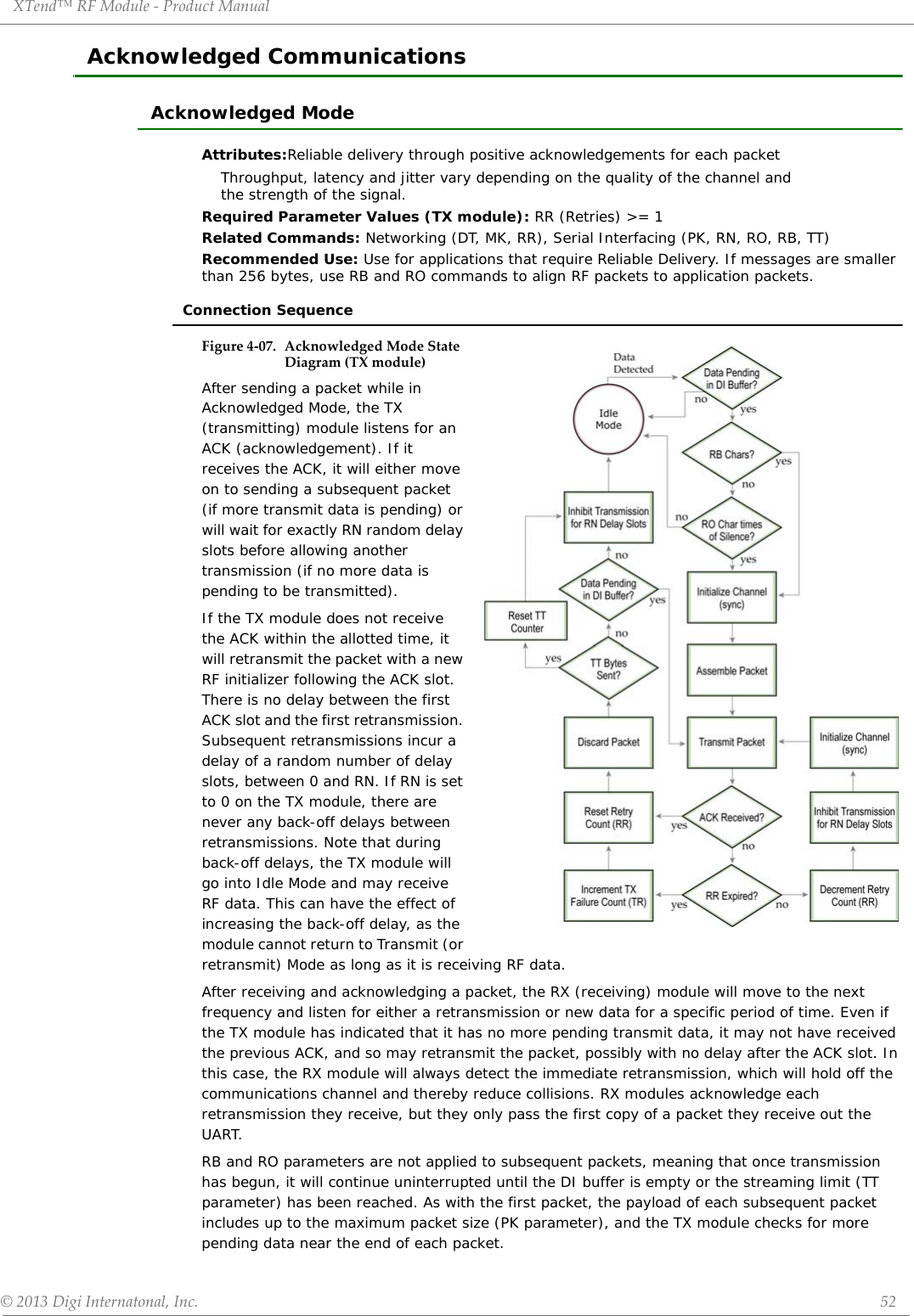
![XTend™RFModule‐ProductManual©2013DigiInternatonal,Inc. 53The TT parameter (streaming limit) specifies the maximum number of bytes that the TX module will send in one transmission event, which may consist of many packets and retries. If the TT parameter is reached, the TX module will force a random delay of 1 to RN delay slots (exactly 1 delay slot if RN is zero). Each packet is counted only once toward TT, no matter how many times the packet is retransmitted.Subsequent packets in Acknowledged Mode are similar to those in Streaming Mode, with the addition of an ACK between each packet, and the possibility of retransmissions. Subsequent packets are sent without an RF initializer, as the RX modules are already synchronized to the TX module from the preceding packet(s) and they remain synchronized for the duration of the transmission event. Each retransmission of a packet includes an RF initializer.Once the TX module has sent all pending data or has reached the TT limit, the acknowledged transmission event is completed. The TX module will not transmit again for exactly RN delay slots, if the local RN parameter is set to a non-zero value. The RX module will not transmit for a random number of delay slots between 0 and (RN-1), if the local RN parameter is set to a non-zero value. These delays are intended to lessen congestion following long bursts of packets from a single TX module, during which several RX modules may have themselves become ready to transmit.Polling Mode (Acknowledged)NOTE: Polling Mode (Acknowledged) and Polling Mode (Basic) [p51] operate in the same way. The difference between the two modes is in their means of achieving reliable delivery of data. In Poll-ing Mode (Acknowledged), reliable delivery is achieved using retries and acknowledgements.Attributes:Utilizes high percentage of available network bandwidthEliminates collisionsWorks with reliable delivery (RR or MT parameters)Supports binary data transfersBase module requests packets from remote module by polling a sequential range of addressesBase module is configured to specify the range of addresses being polledUses inter-character delay to create RF packet lengths aligned with protocol packet lengths up to 2048 bytes long.Required Parameter Values (Base): MD (RF Mode) = 3, PB (Polling Begin Address), PE (Polling End Address)Required Parameter Values (Remote): MD (RF Mode) = 4Related Commands: Networking (RR, PD, DT, MY, AM)Constraints: The minimum time interval between polling cycles is configurable. However, if the remote modules cannot all be processed within that time interval, the polling cycle is ineffective (i.e. it will impose no additional delay). In order to ensure a pause between polling cycles, PD must be set to a value which is large enough to accommodate the pause.Recommended Use: Use for point-to-multipoint applications that require Reliable Delivery of data. Use this mode when it is critical that a base module be able to discern data coming from multiple modules.Theory of OperationA ‘Polling Base’ module will cycle through a sequential range of addresses. The ‘Polling Base’ will poll each ‘Polling Remote’ module, wait for a response, then poll the next remote address in the sequence. Each ‘Polling Remote’ will respond by sending the data from its DI (Data In) buffer following the RB (Packetization Threshold) & RO (Packetization Timeout) parameters. When there is no eligible data to send, the ‘Polling Remote’ will not respond. The ‘Polling Base’ will poll the next address in the polling sequence after a short delay.](https://usermanual.wiki/Digi/9XTENDB.Updated-User-Manual/User-Guide-1882461-Page-53.png)
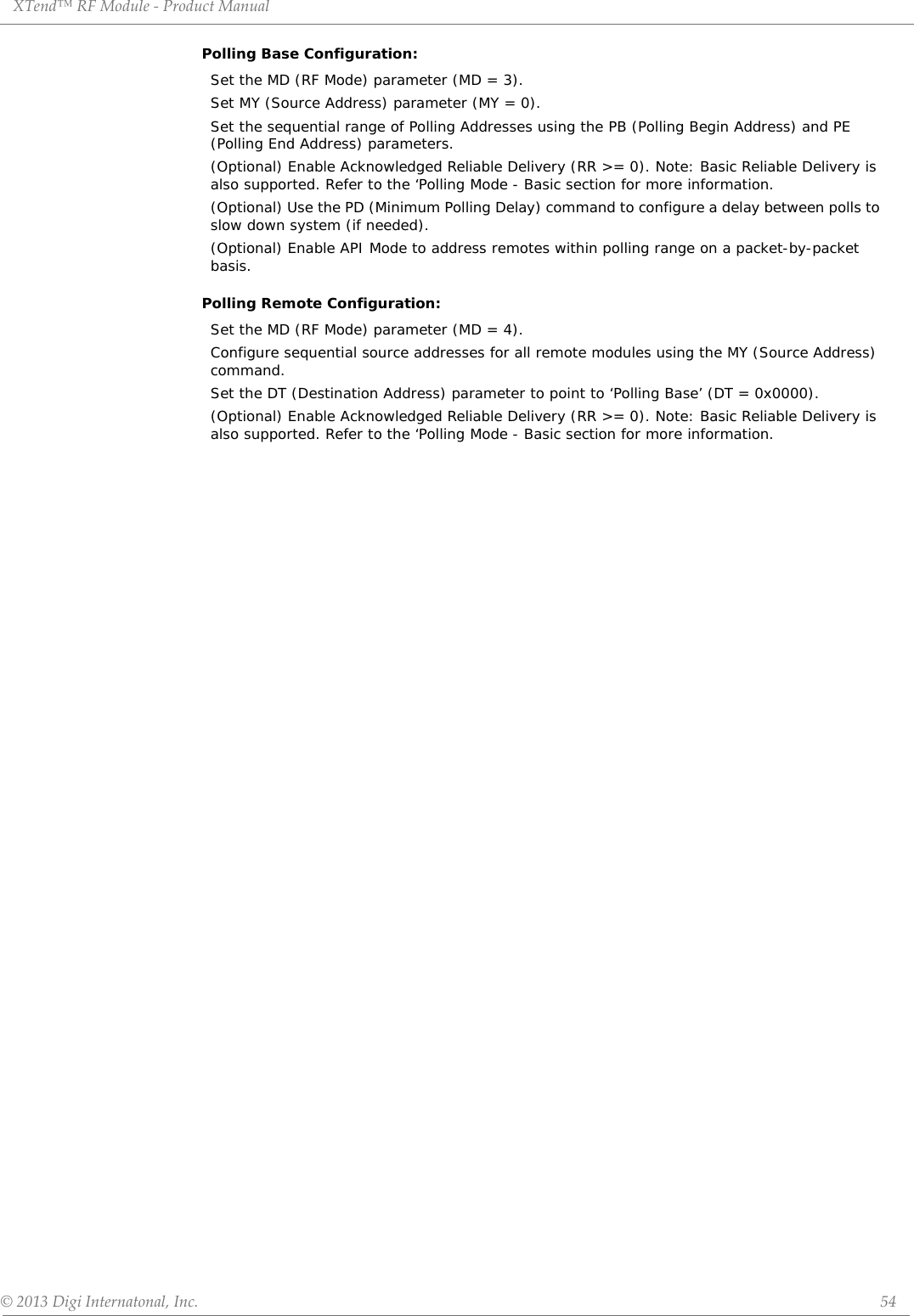
![©2013DigiInternationalInc. 55AppendixA:AgencyCertificationsFCC (United States) CertificationThe XTend RF Module complies with Part 15 of the FCC rules and regulations. Compliance with the labeling requirements, FCC notices and antenna usage guidelines is required.In order to operate under Digi’s FCC Certification, integrators must comply with the following regulations:Integrator Labeling RequirementsWARNING: The Original Equipment Manufacturer (OEM) must ensure that FCC labeling requirements are met. This includes a clearly visible label on the outside of the final product enclosure that displays the text shown in the figure below.FigureA‐01. RequiredFCCLabelforOEMproductscontainingtheXTendRFModuleFCC NoticesIMPORTANT: The XTend RF Module has been certified by the FCC for use with other products without any further certification (as per FCC section 2.1091). Modifications not expressly approved by Digi could void the user’s authority to operate the equipment.IMPORTANT: Integrators must test final product to comply with unintentional radiators (FCC sections 15.107 & 15.109) before declaring compliance of their final product to Part 15 of the FCC rules.IMPORTANT: The RF module has been certified for remote and base radio applications. If the module will be used for portable applications, the device must undergo SAR testing.This equipment has been tested and found to comply with the limits for a Class B digital device, pursuant to Part 15 of the FCC Rules. These limits are designed to provide reasonable protection against harmful interference in a residential installation. This equipment generates, uses and can radiate radio frequency energy and, if not installed and used in accordance with the instructions, may cause harmful interference to radio communications. However, there is no guarantee that interference will not occur in a particular installation.If this equipment does cause harmful interference to radio or television reception, which can be determined by turning the equipment off and on, the user is encouraged to try to correct the interference by one or more of the following measures: Re-orient or relocate the receiving antenna, Increase the separation between the equipment and receiver, Connect equipment and receiver to outlets on different circuits, or Consult the dealer or an experienced radio/TV technician for help.1. The integrator must ensure that the text provided with this device [Figure A-01] is placed on the outside of the final product and within the final product operation manual.2. The XTend RF Module may only be used with antennas that have been tested and approved for use with this module [refer to ‘FCC-approved Antennas’ section].Contains FCC ID: MCQ-9XTENDB The enclosed device complies with Part 15 of the FCC Rules. Operation is subject to the following two conditions: (i.) this device may not cause harmful interference and (ii.) this device must accept any inter-ference received, including interference that may cause undesired operation.](https://usermanual.wiki/Digi/9XTENDB.Updated-User-Manual/User-Guide-1882461-Page-55.png)
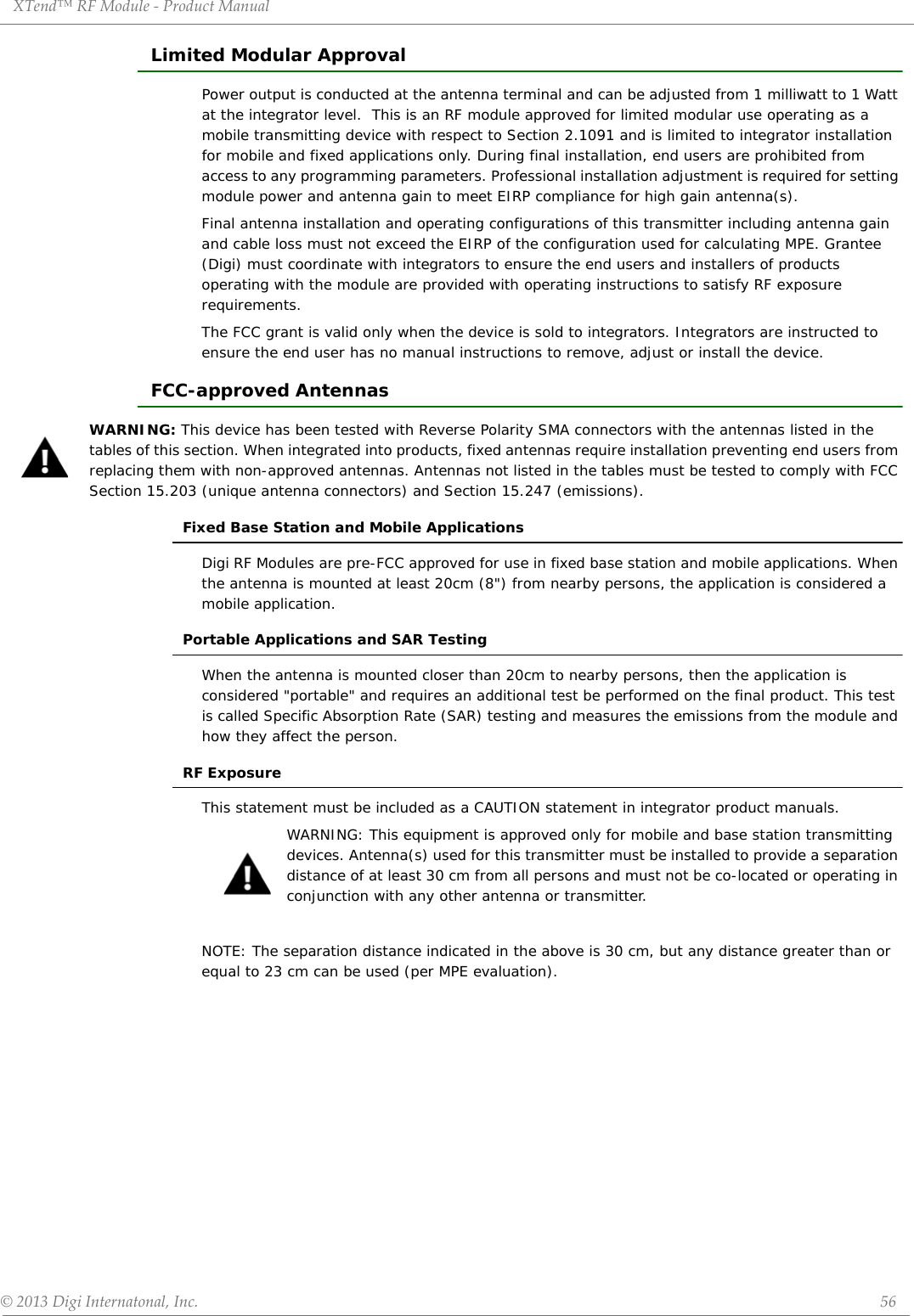
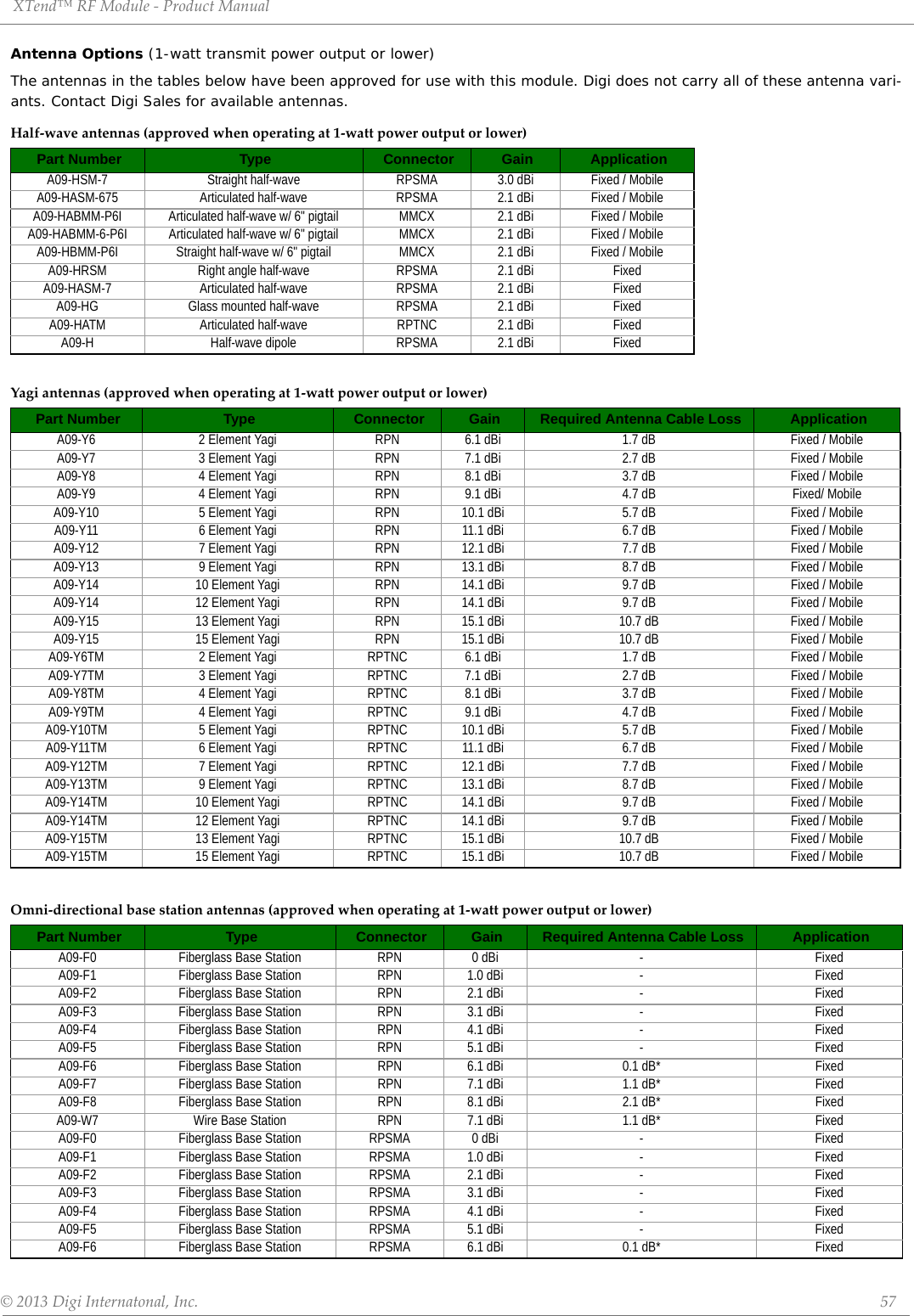
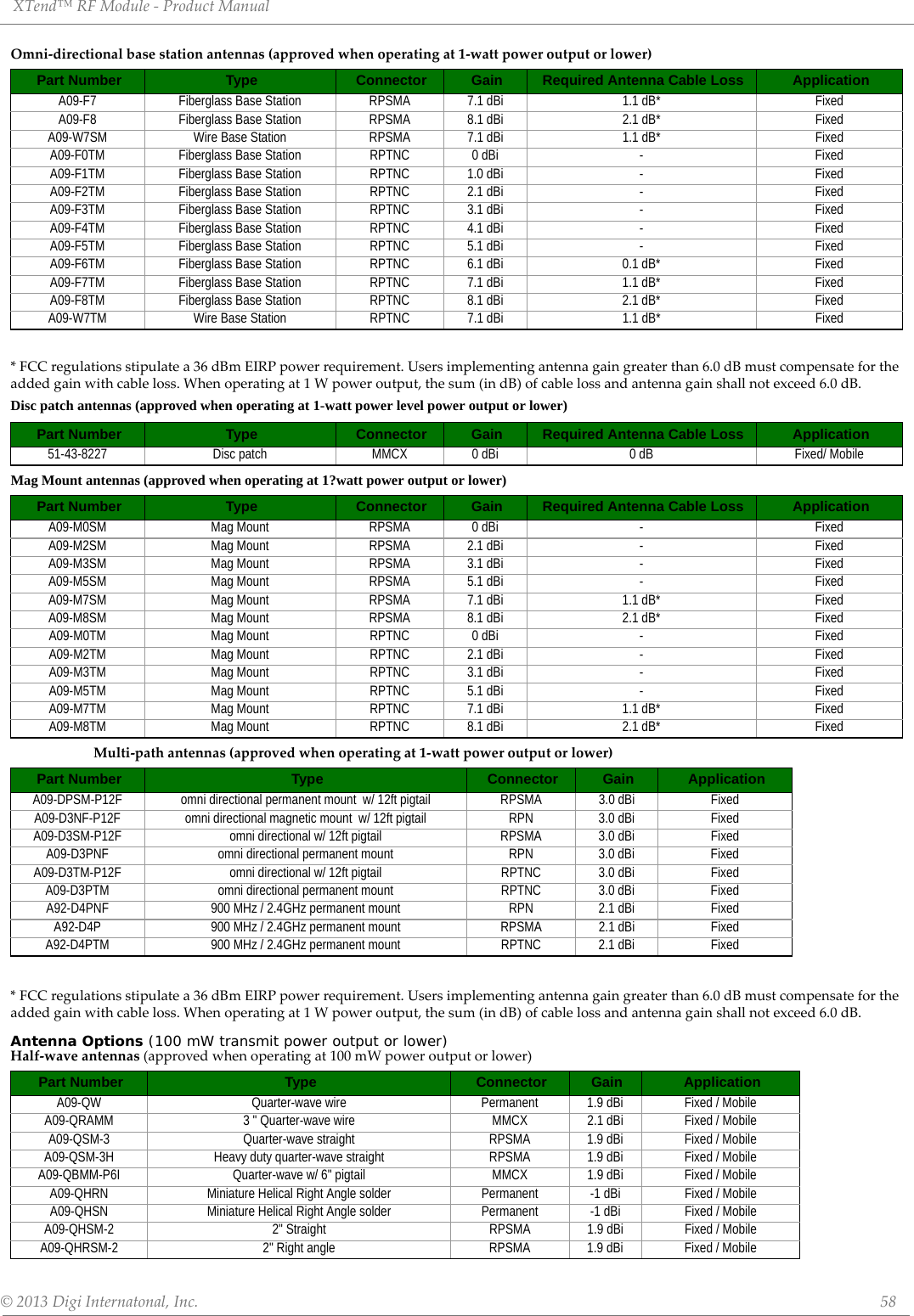
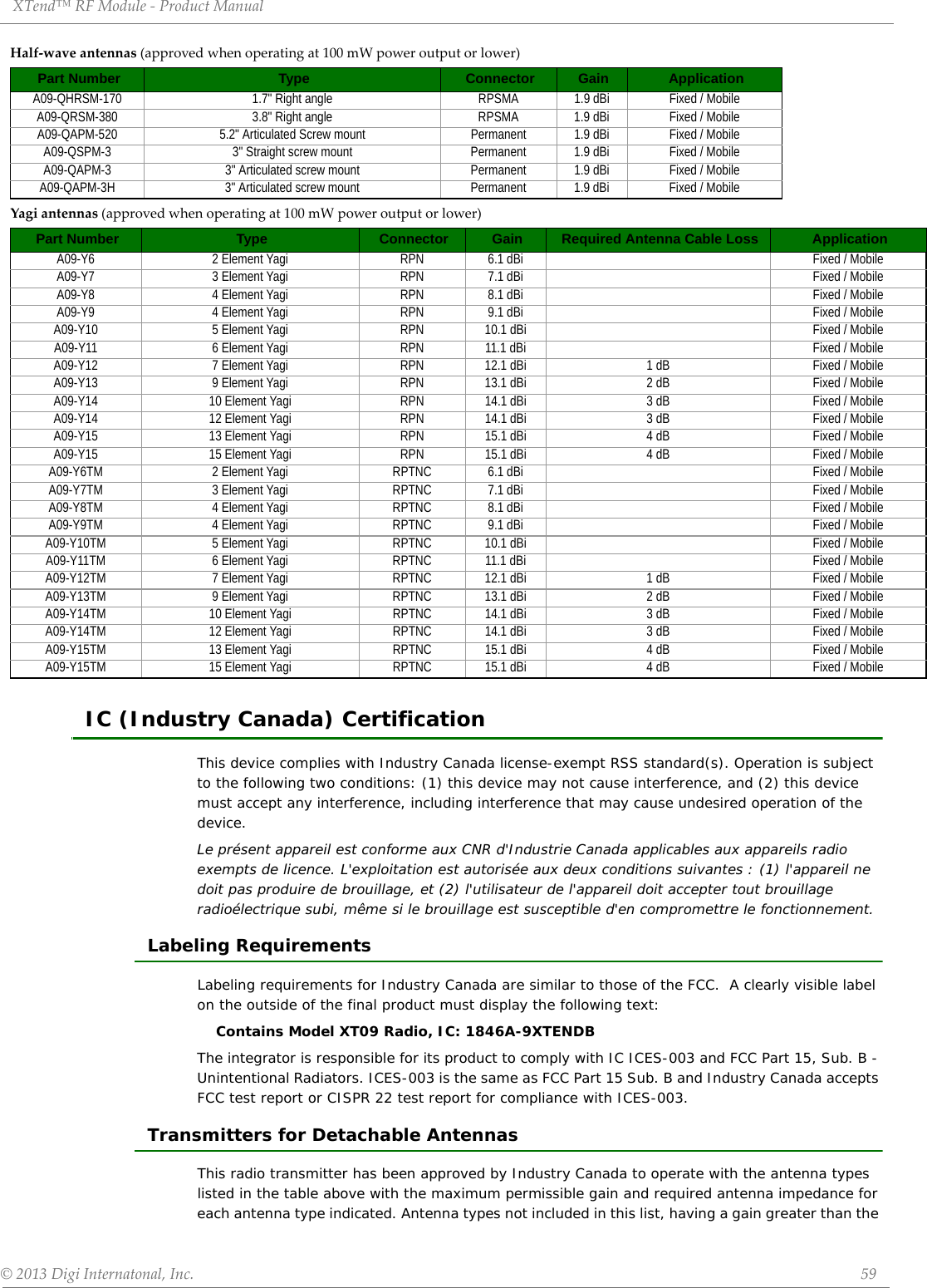
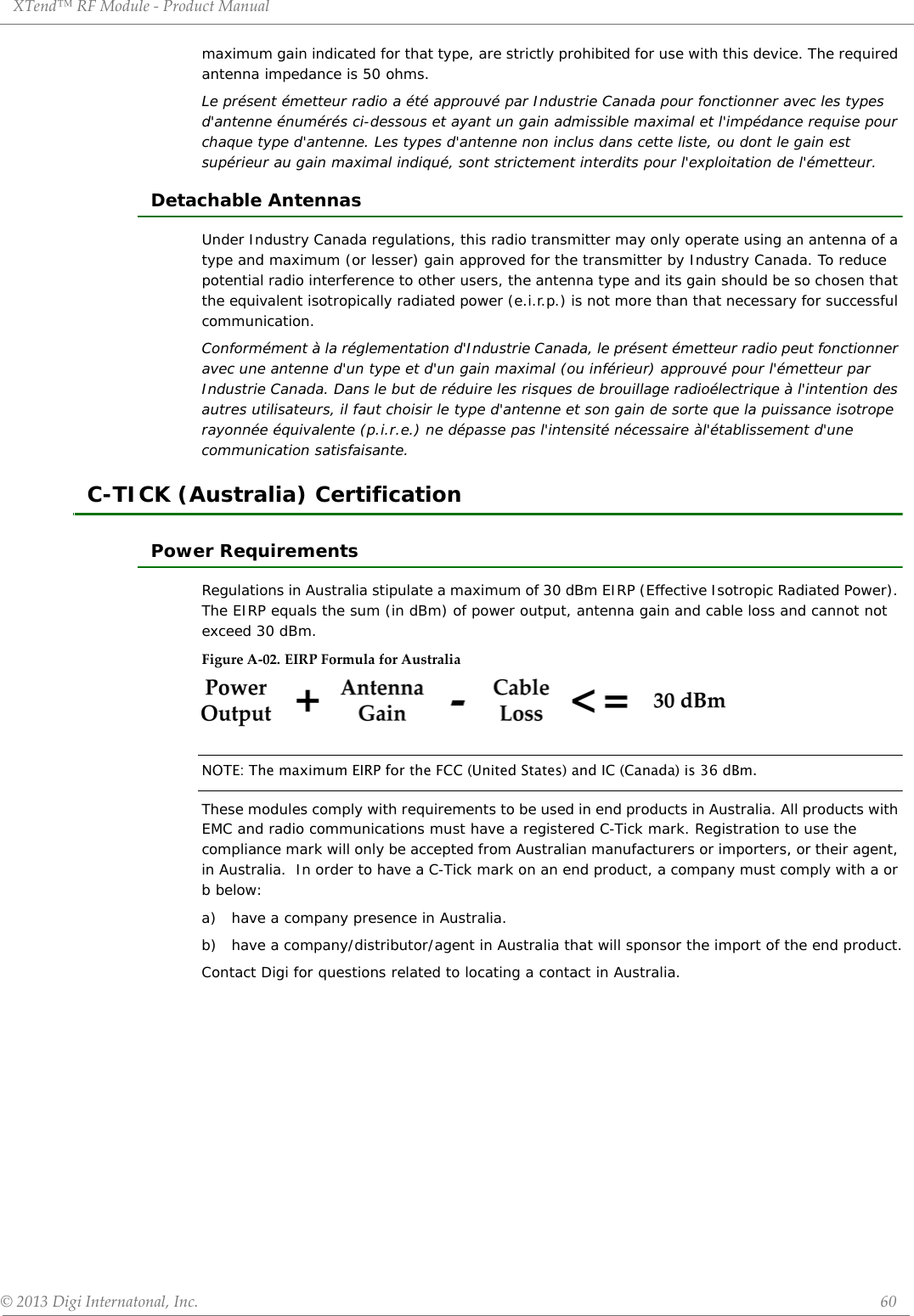
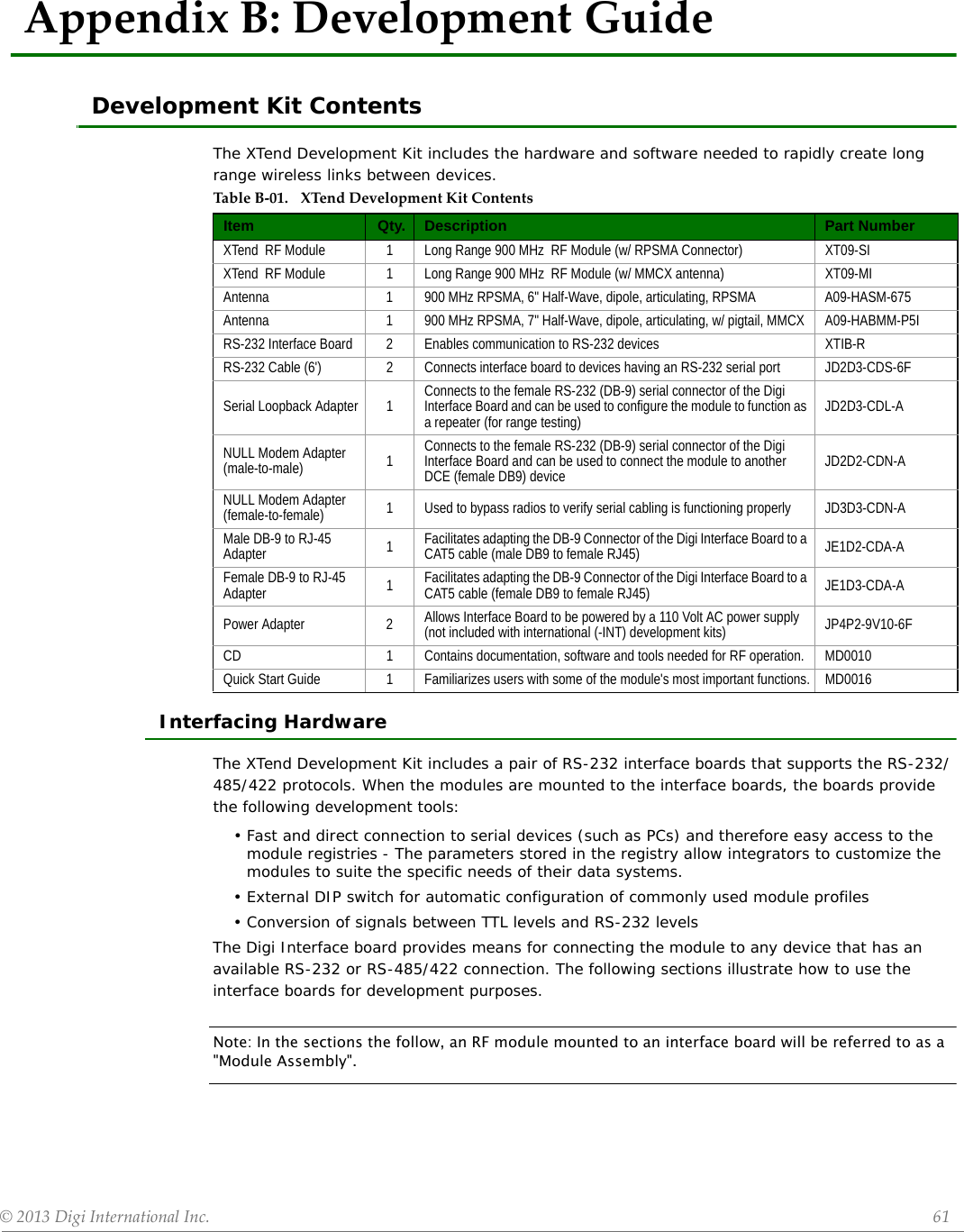
![XTend™RFModule‐ProductManual©2013DigiInternatonal,Inc. 62XTIB-R RS-232/485 Interface BoardFigureB‐03. DIPSwitchSettingsoftheXTIB‐R(RS‐232/485)InterfaceBoard B-01a. Config (Configuration) SwitchFigureB‐01. FrontView The Config Switch provides an alternate method for entering into Command Mode. To enter Command Mode at the module's default RF data rate, hold the Configuration Switch down for two seconds. B-01b. I/O & Power LEDsThe LEDs visualize gigantic status information and indicate module activity as follows:Yellow (top LED) = Serial Data Out (to host)Green (middle) = Serial Data In (from host)Red (bottom) = Power/TX Indicator (Red light is on when powered; it pulses on/off briefly during RF transmission.)) B-01c. DB-9 Serial PortStandard female DB-9 (RS-232) connector. This connector can also be used for RS-485 and RS-422 connections. B-01d. RSSI LEDsRSSI LEDs indicate the amount of fade margin present in an active wireless link. Fade margin is defined as the difference between the incoming signal strength and the module's receiver sensitivity.3 LEDs ON = Very Strong Signal (> 30 dB fade margin)2 LEDs ON = Strong Signal (> 20 dB fade margin)1 LED ON = Moderate Signal (> 10 dB fade margin)0 LED ON = Weak Signal (< 10 dB fade margin) B-01e. Power Connector7-28 VDC power connector (Center positive, 5.5/2.1mm)Note: The XTIB-R interface board can accept voltages as low as 5V. Contact Digi Technical Support to enable this option. B-02a. DIP SwitchFigureB‐02. BackView DIP Switch automatically configures the module to operate in different modes during the power-on sequence. Each time the module assembly (interface board + module) is powered-on, intelligence on the board programs the attached module according to the positions of the DIP Switch.Figure B-03 illustrates DIP Switch settings. Table B-02 summarizes the configurations triggered by the positions of the DIP Switch.B‐01a.ConfigSwitchB‐01b.I/O&PowerLEDsB‐01c.DB‐9SerialPortB‐01dRSSILEDsB‐01e.PowerConnectorB‐02a.DIPSwitchRefertothetablesinthe‘A u t o m a t i c DIPSwitchConfigurations’section[nextpage]regardingconfigura‐tionstriggeredbythepositionsoftheDIPSwitch(duringpower‐up).](https://usermanual.wiki/Digi/9XTENDB.Updated-User-Manual/User-Guide-1882461-Page-62.png)
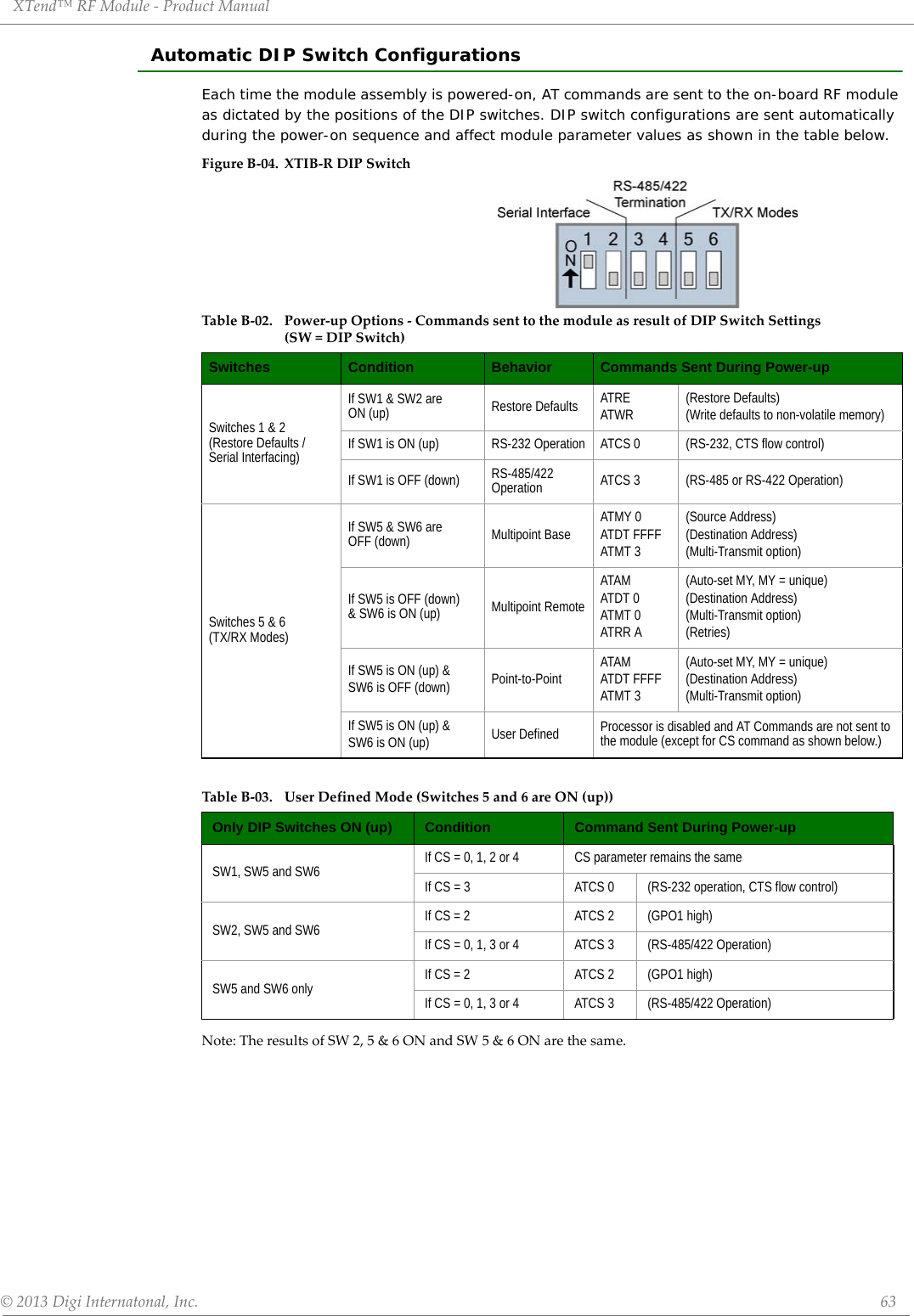
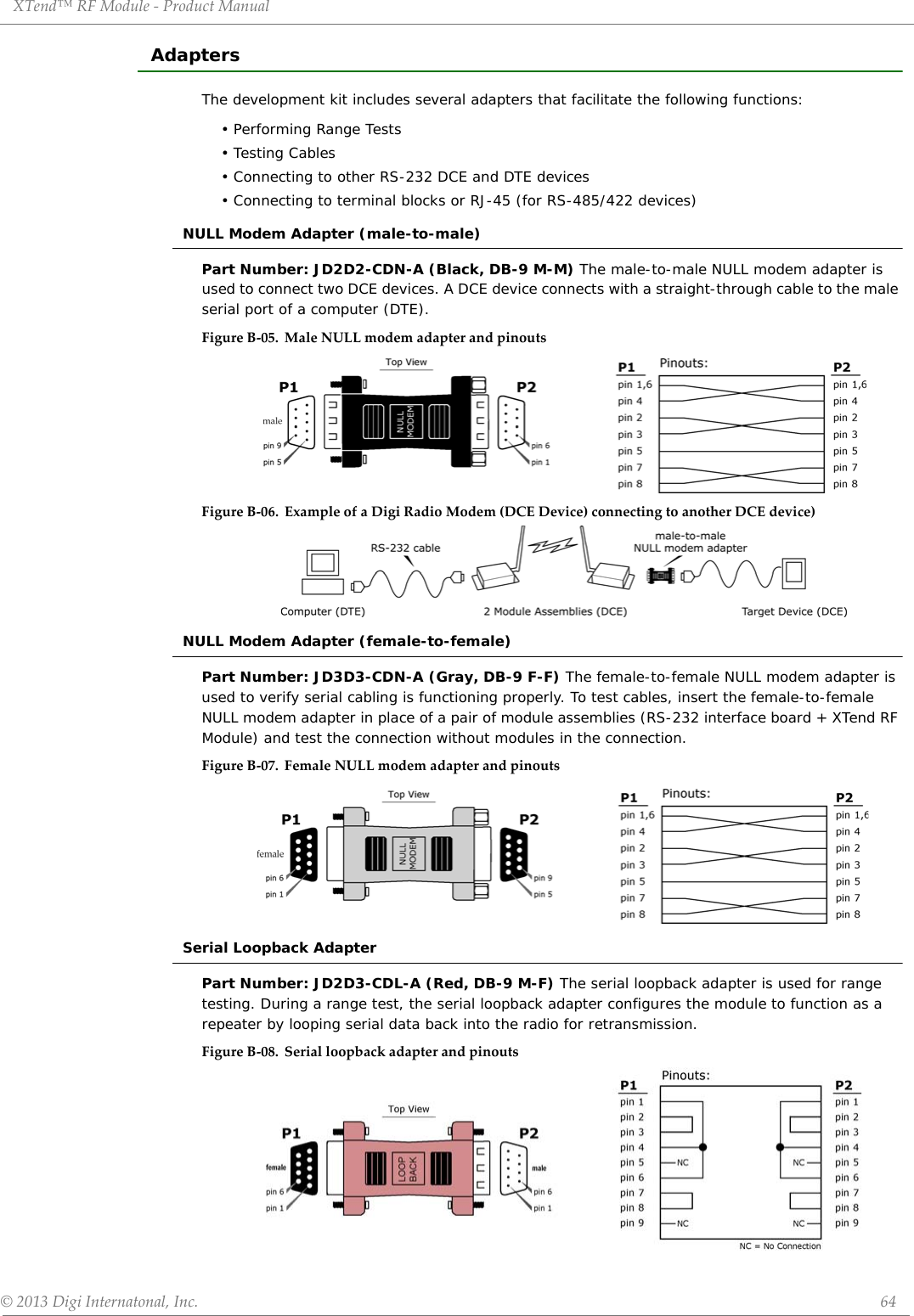
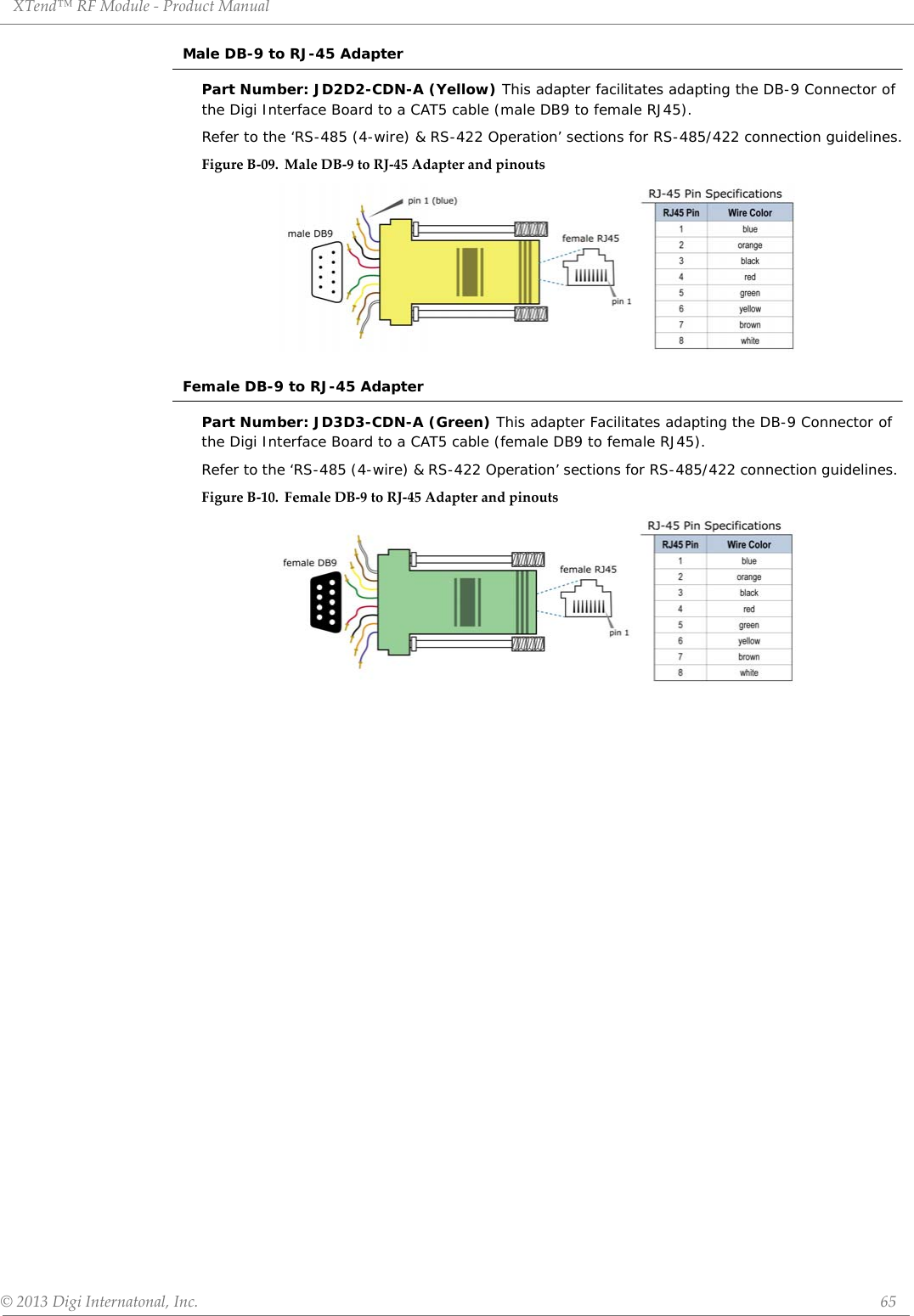
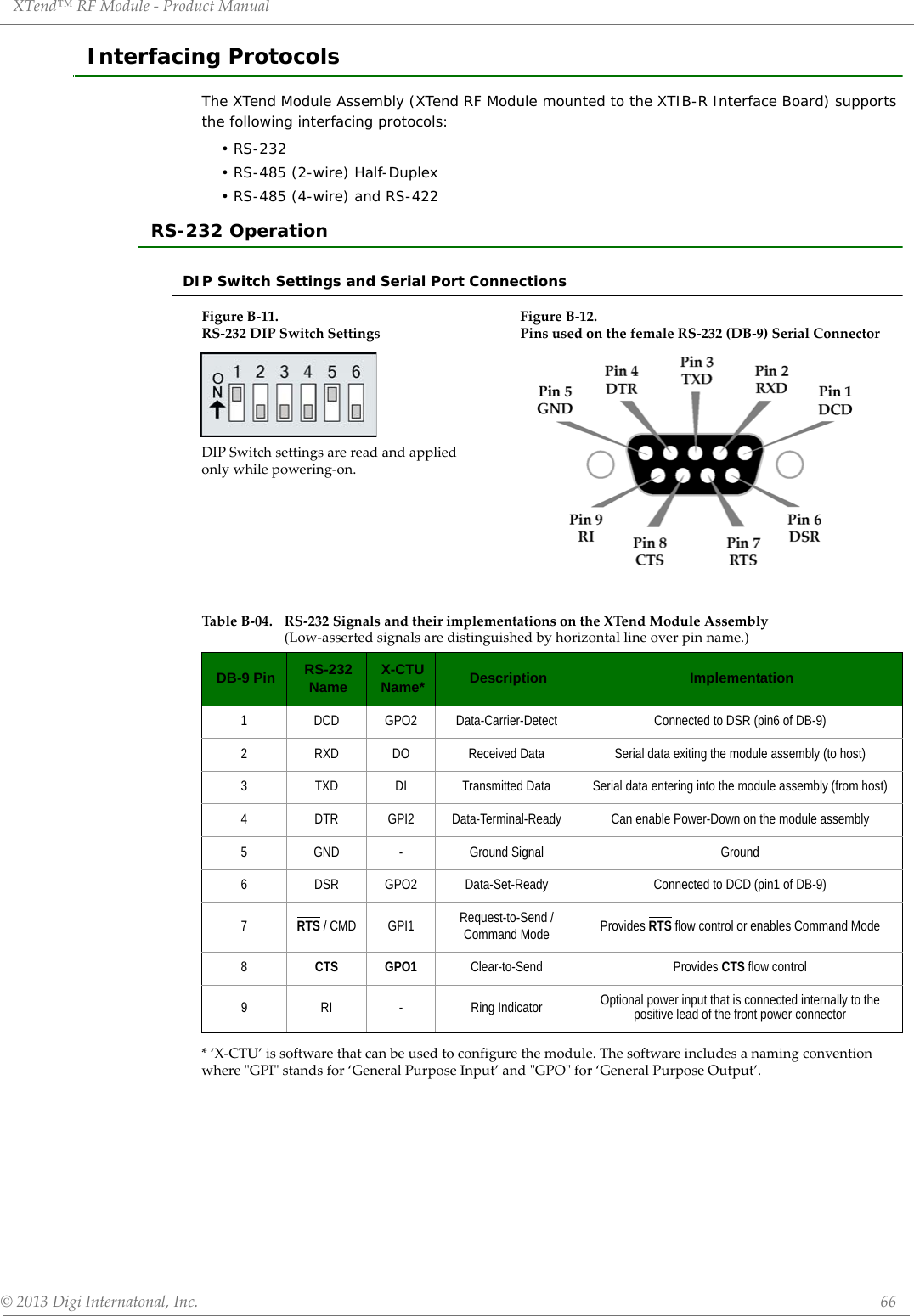
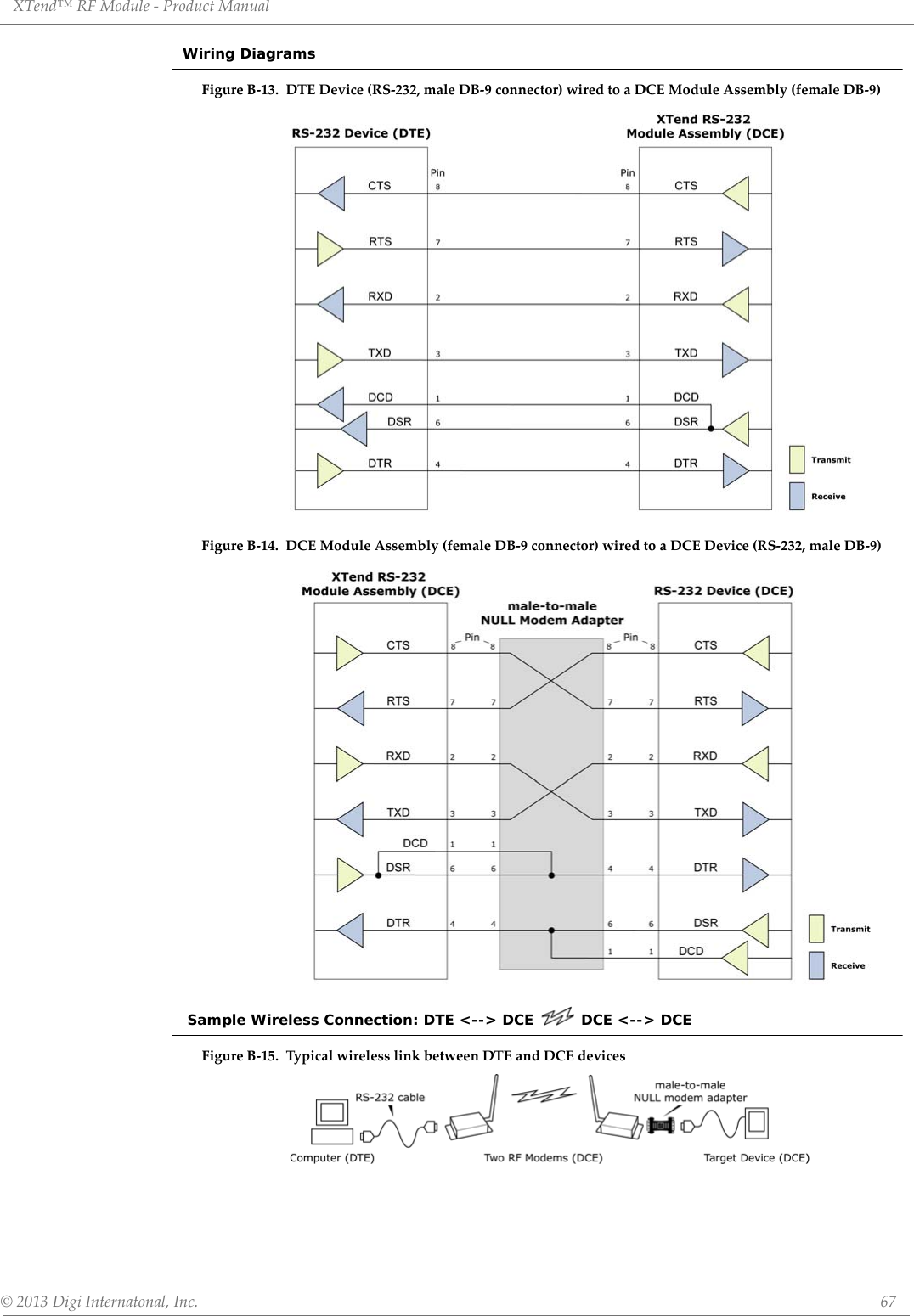
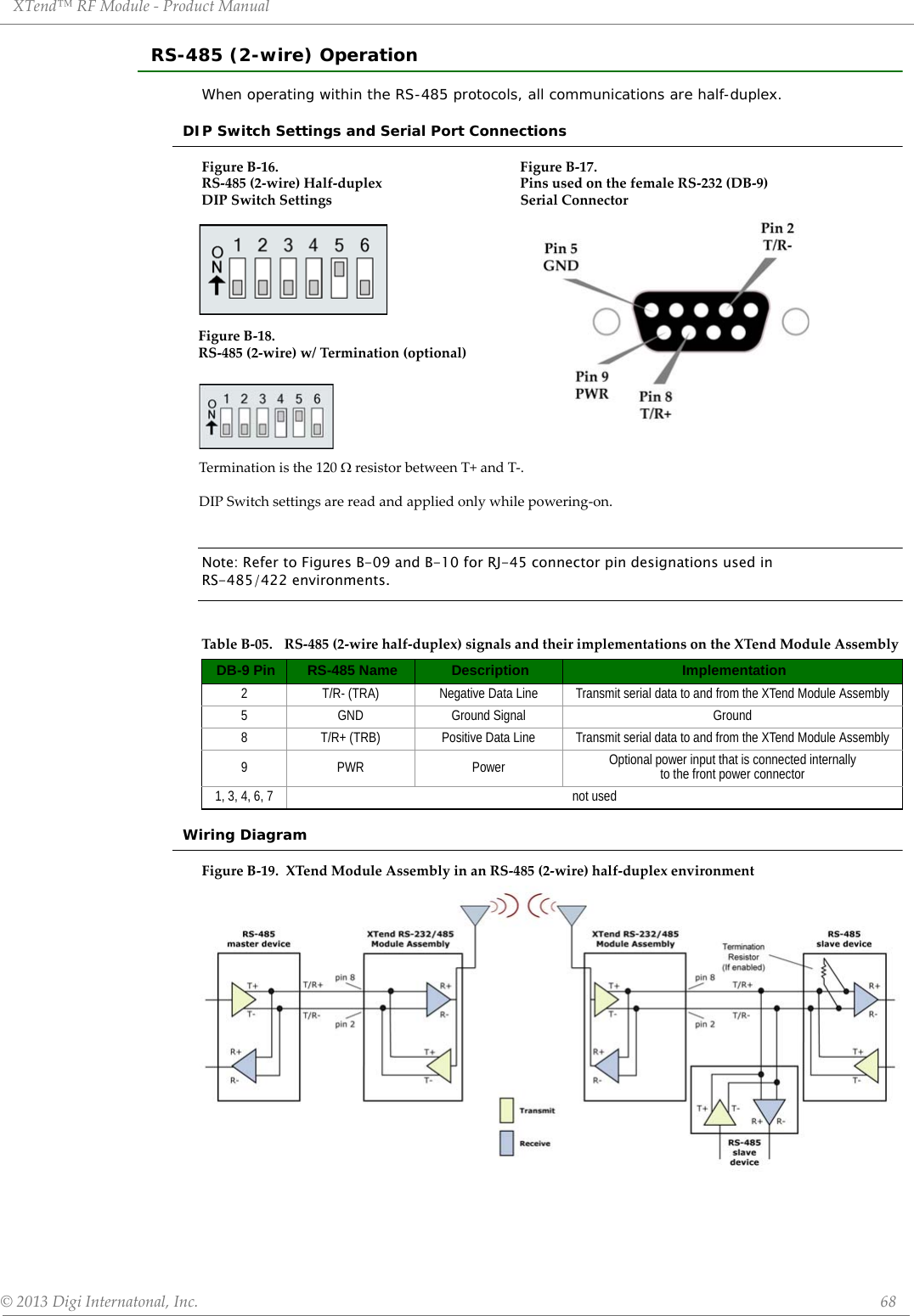
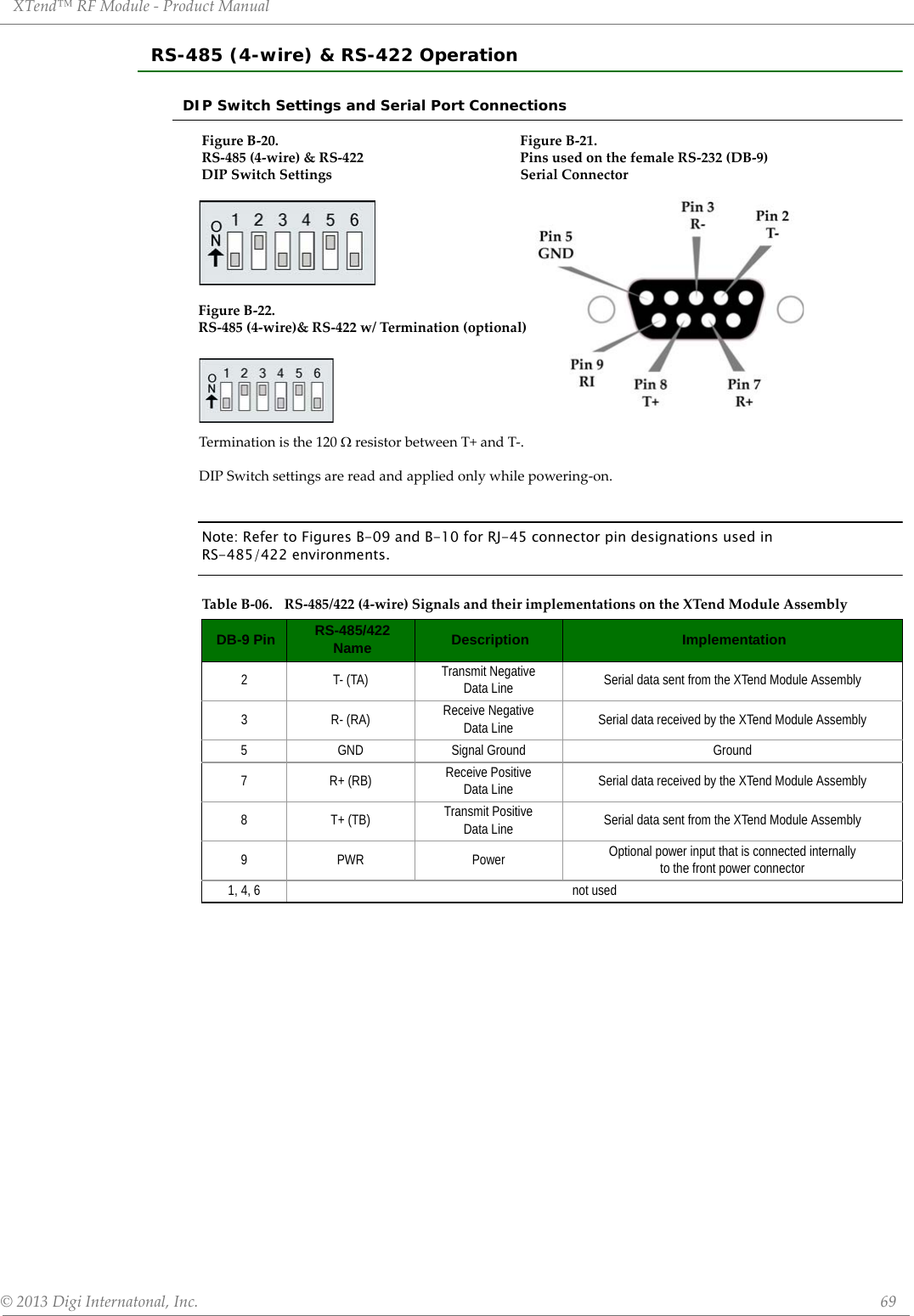
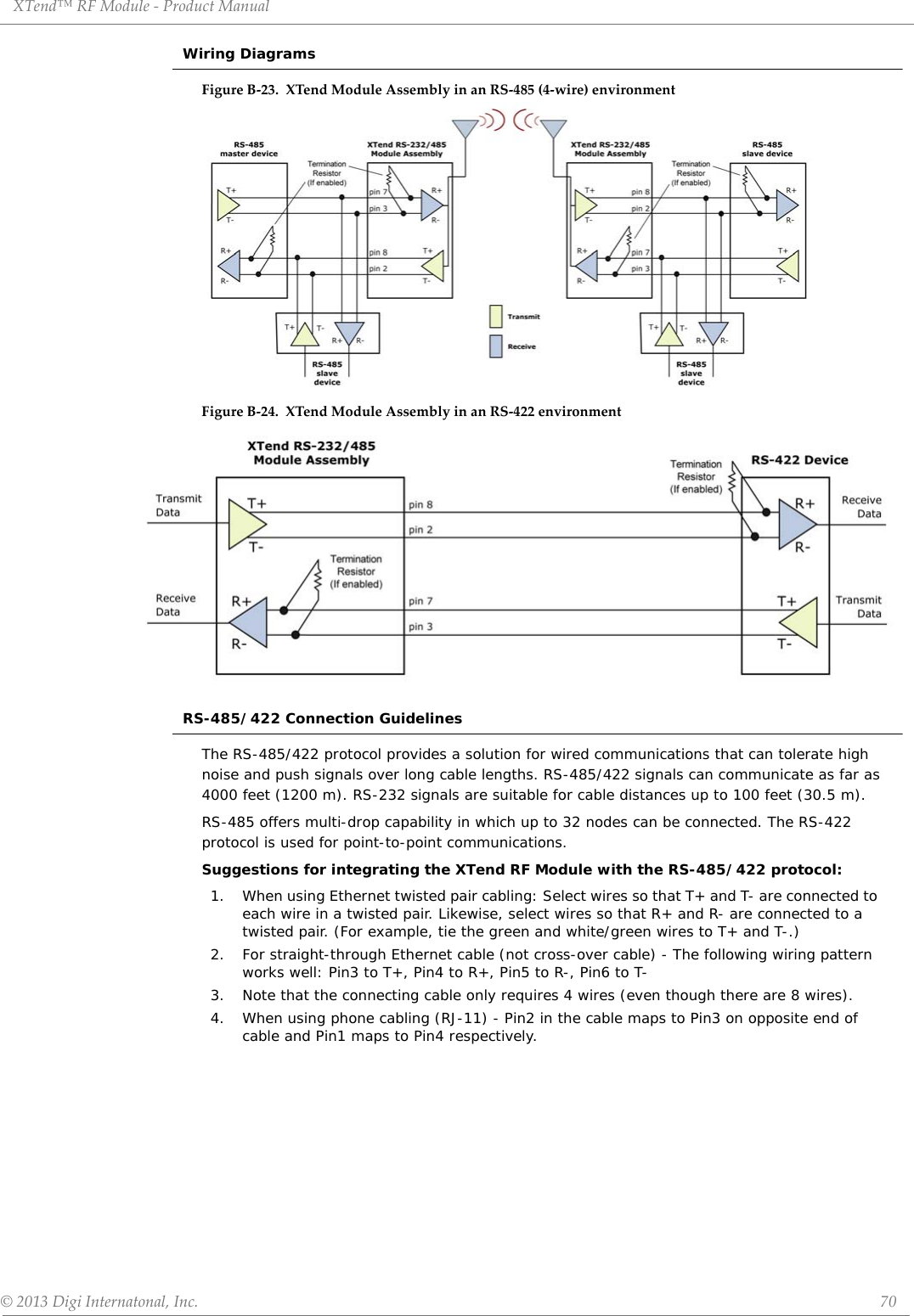
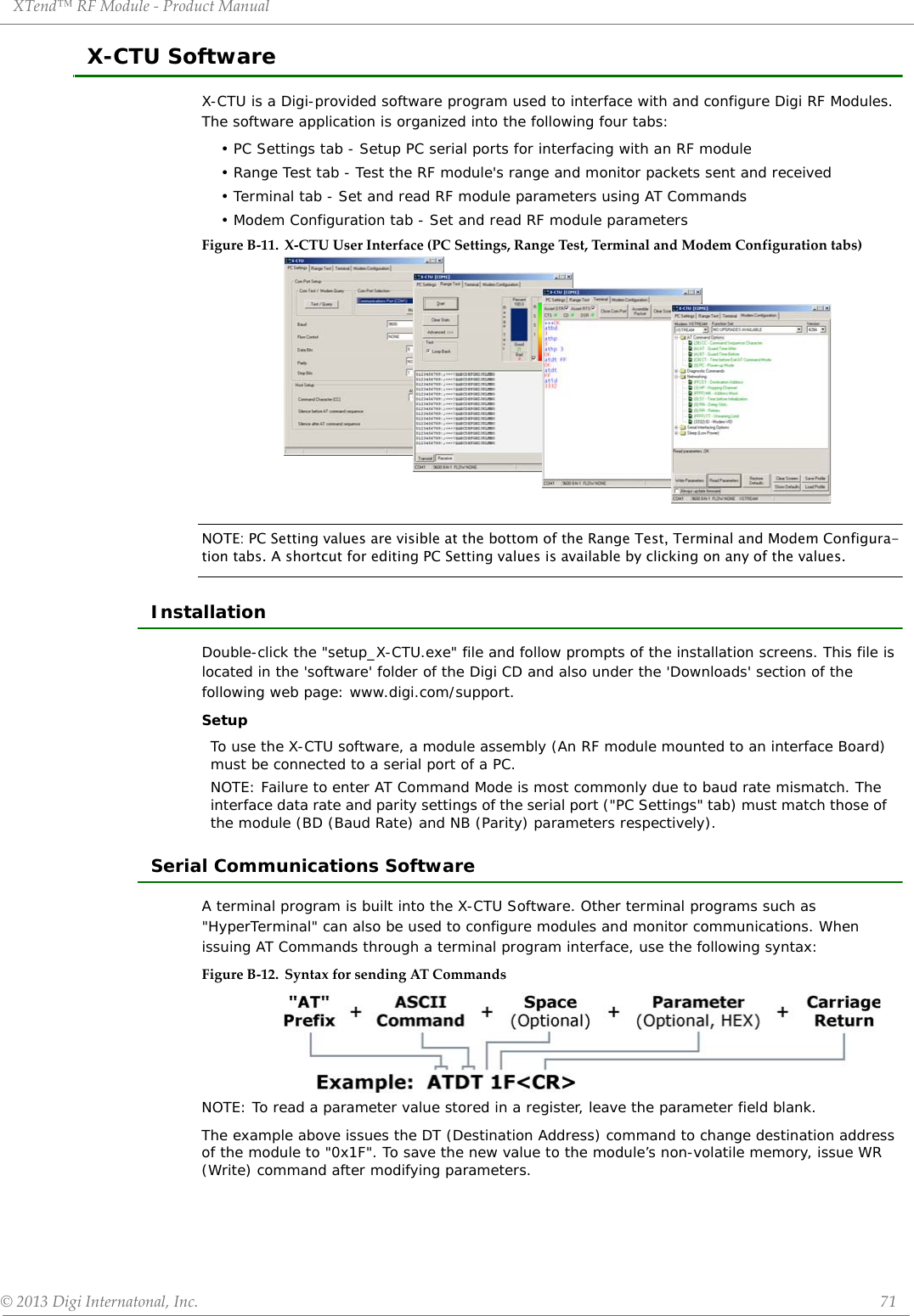
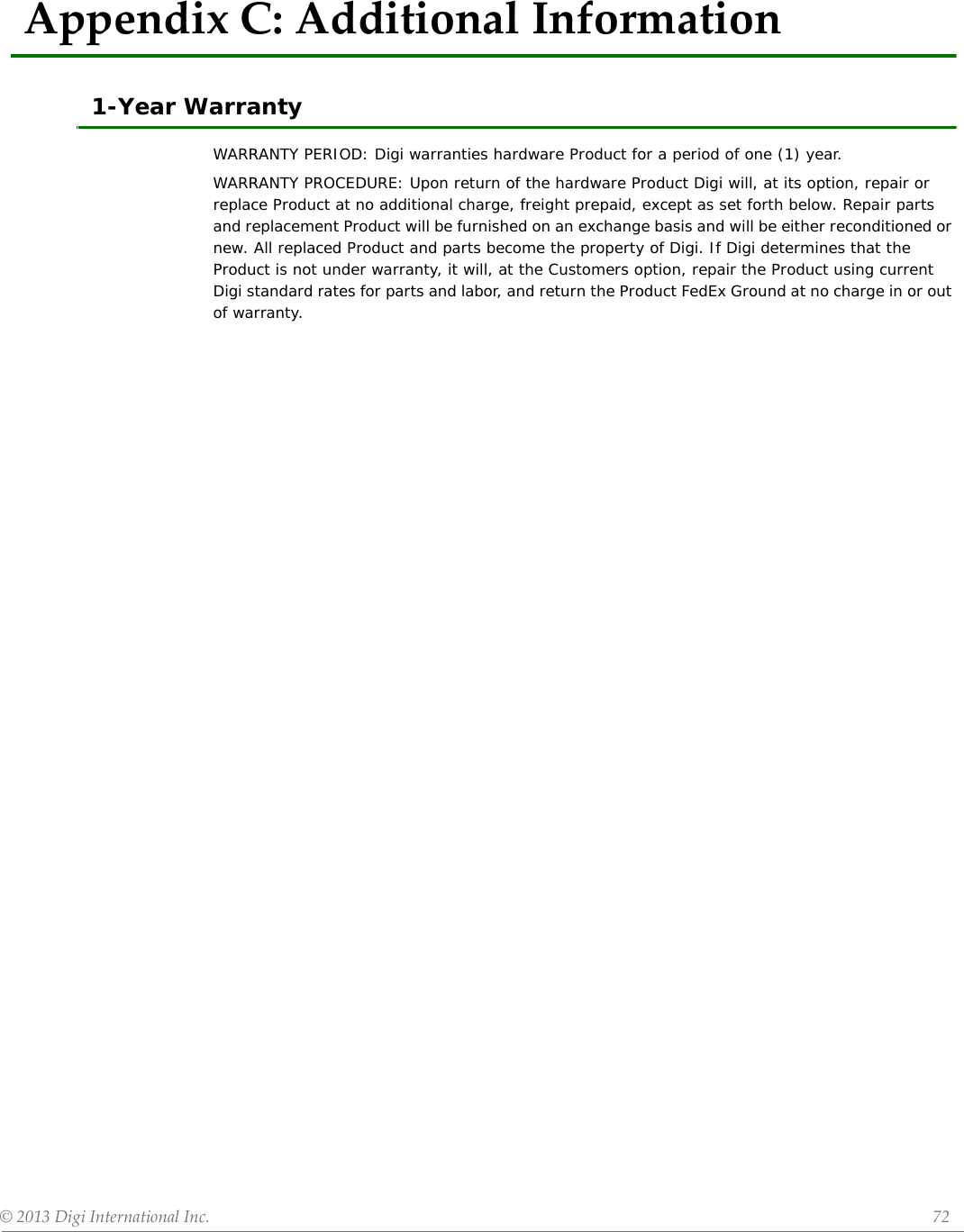
![XTend™RFModule‐ProductManual©2013DigiInternatonal,Inc. 73Contact DigiFor the best in wireless data solutions and support, please use the following resources:Office hours are 8:00 am - 5:00 pm [U.S. Mountain Standard Time]Documentation: www.digi.com/supportTechnical Support: Phone. (866) 765-9885 toll-free U.S.A. & Canada(801) 765-9885 WorldwideEmail. rf-experts@digi.com E-support: http://www.digi.com/support/eservice/eser-vicelogin.jsp](https://usermanual.wiki/Digi/9XTENDB.Updated-User-Manual/User-Guide-1882461-Page-73.png)